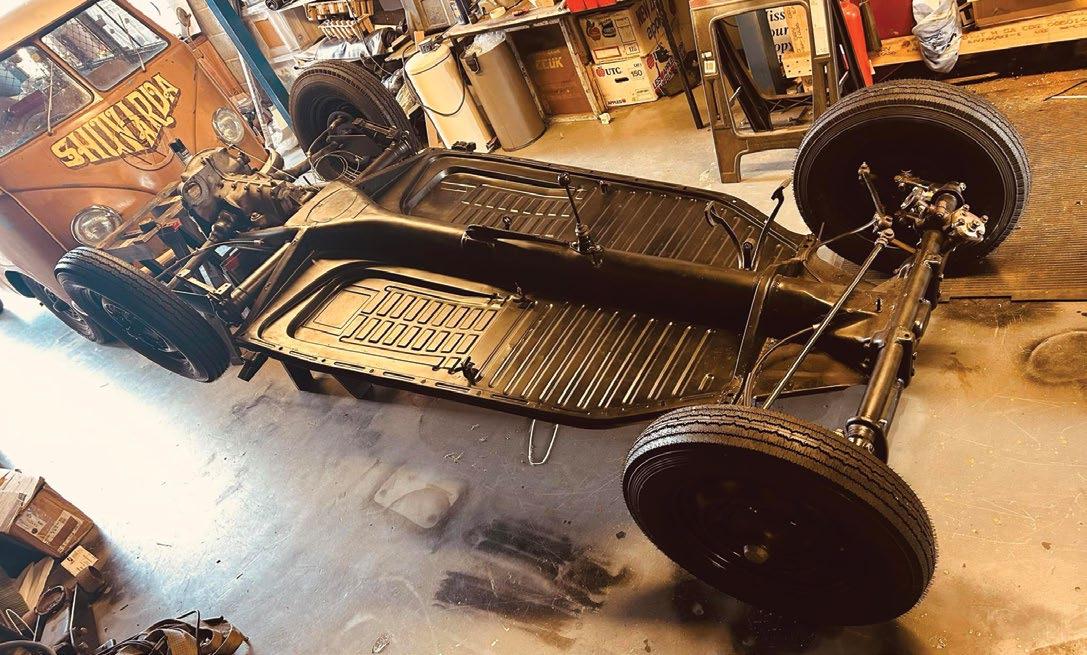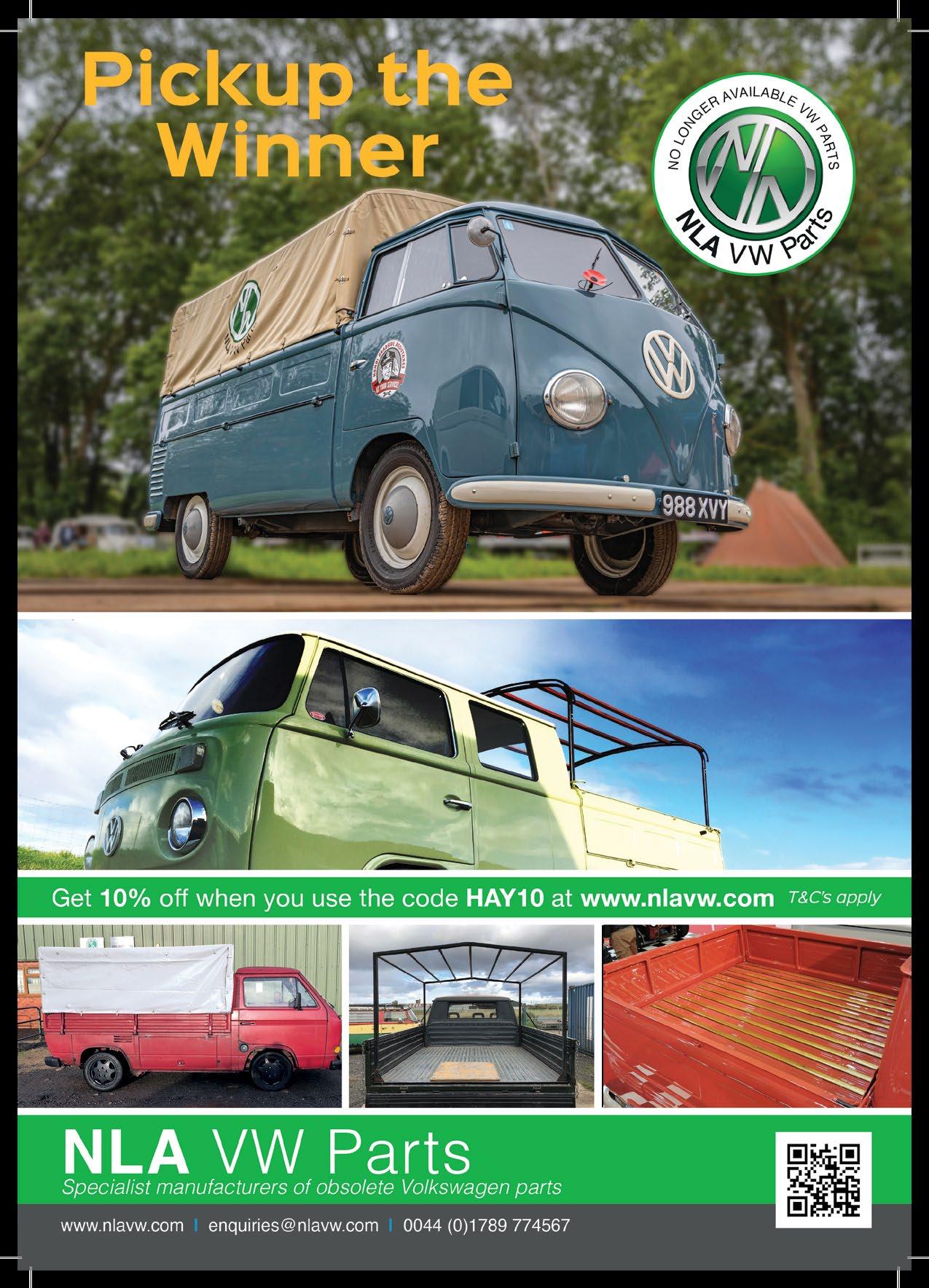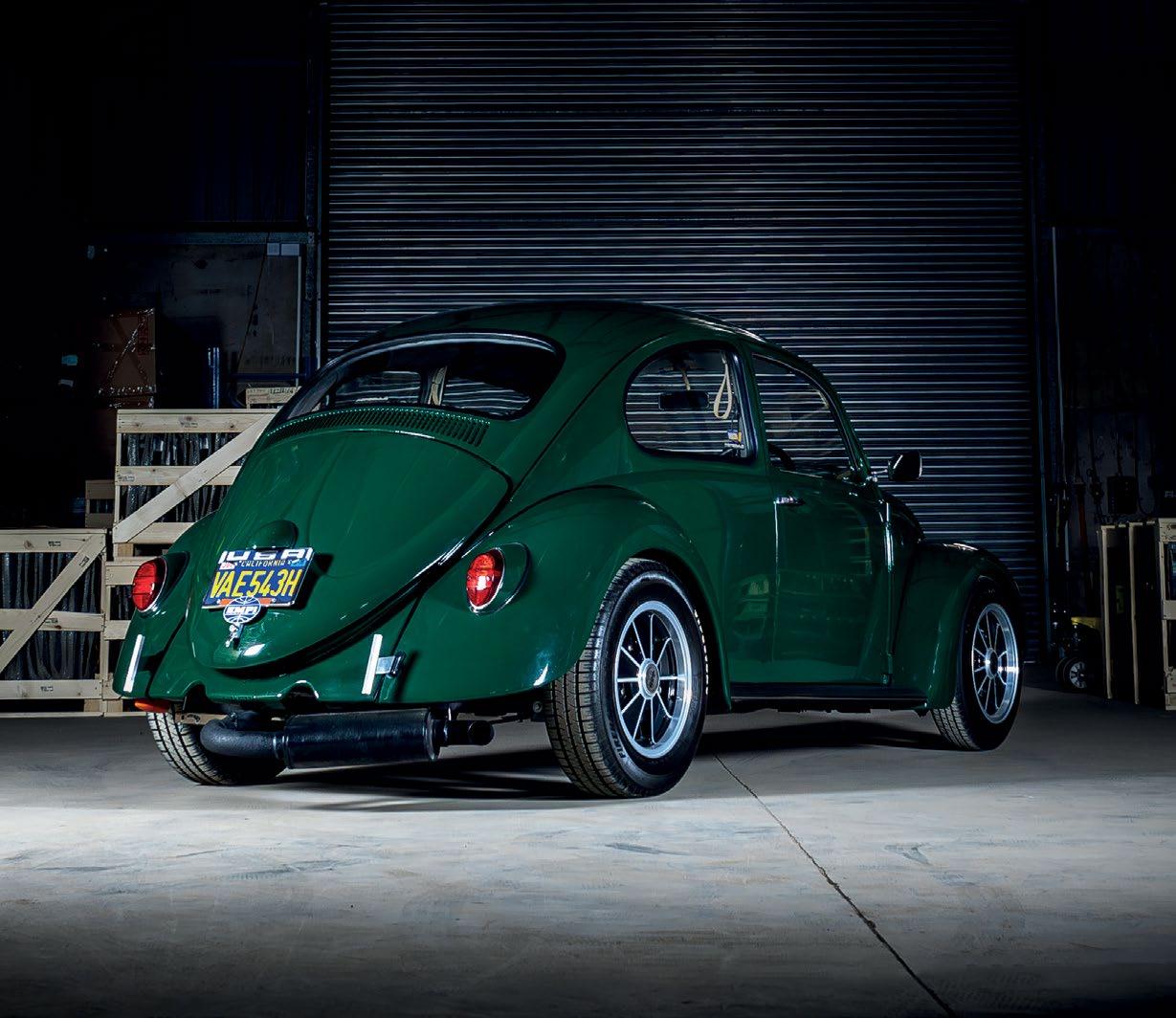














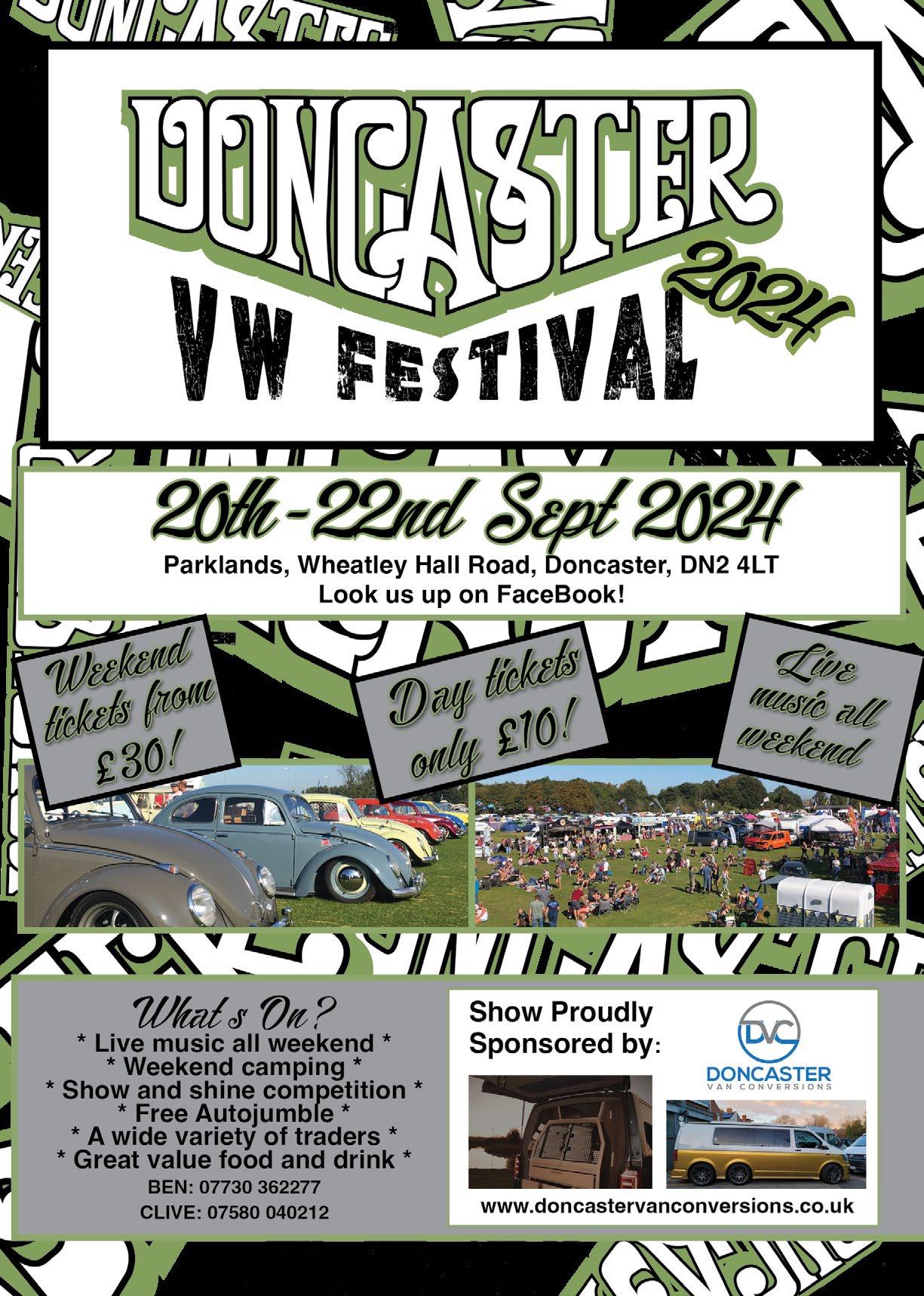



































72

Valentin’s passion for cars goes back to his rebellious teenage years, when skate-park trips with his friends were punctuated by punk rock and the frenetic customisation of their bikes: “We were looking for ways to customise our BMXs with cool parts to stand out from the crowd. It never left me!”
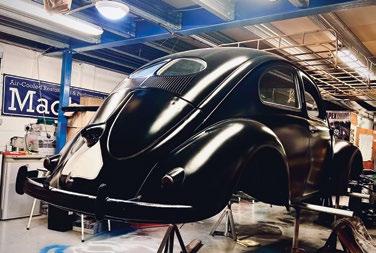
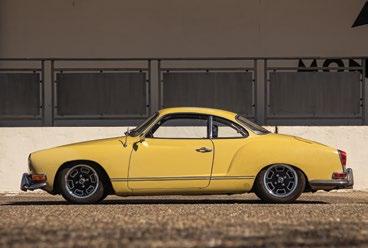

190
I believe it went something like this: “Dan! Dan! Is it bad? It’s bleeding but I can’t see.” “Yeah, that’s all the way to your skull. It’s going to be a stitch.”

Today there are about 30–40 of all the 4-door saloon models left in the UK. Mine is one of four TiLuxes known to exist over here.
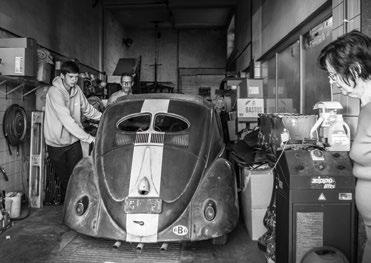


60 64

Jimmy Eriksson’s journey with this 1956 Type1 rally-inspired Beetle has been a long process and has taken many different paths. For many years Jimmy has run a large blog focused on lowered vehicles of all kinds, but mostly American cars.
I guess I will keep on changing things on the car. It’s like a never finished project. But first on the list is the bigger engine with EFI. I’m really looking forward to getting the fuel tech sorted and driving it like I stole it.
144

Highroof Panels are pretty scarce. Most of them led a tough working life and simply didn’t survive. This showwinning example that just went through a photoshoot in our in-house studio started out as a light grey workhorse, destined for Portugal.
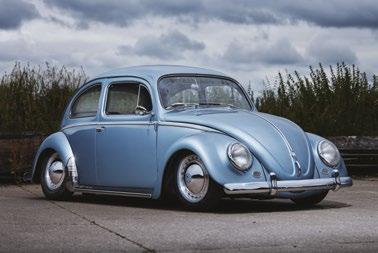
18

The fact that his standards are exacting just happens to be the way he works, the Porsche crossover, just what he likes – and his car just happens to be fucking awesome (in a subtle kind of way).
Our friends over at JK took opportunity to look back through their old photo albums and image drives at some of the 250+ VW’s that Just Kampers has bought, built, or bartered over the last 35 years and share them with you. 82 180

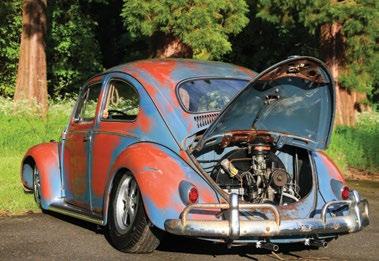

Copyright © 2024 by Hayburner Limited. All rights reserved. This magazine or any portion thereof may not be reproduced or used in any manner whatsoever without the express written permission of the editor, except for the use of brief quotations.
Operations Manager - Vic Faux
Editor-In-Chief & Founding Editor - Ned Faux


Every nut and bolt has been thought about and perfectly executed. The first time I saw this car it stopped me in my tracks and I’m sure it has or will have the same effect on you if you’re lucky enough to see it in the flesh.


Here we have a car owned by Myles Yarney – no stranger to an air-cooled VW and also having a collection, both past and present, of cars that would turn the eye of almost anyone that knows their stuff.
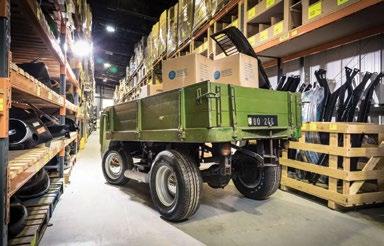

Back in January 2024 Ned received the first email from Bob at BBT in Belgium, kindly inviting us on a trip to Brazil with him in May. It was very vague, mainly a brief description of “a visit to Volksfest Curitiba, and the week after we will visit several factories (engine cases, pistons, brake drums, etc. etc.) and also a couple of private collections …”


Since you can’t just walk out of the door and buy a new air-cooled Volkswagen from the dealership, EMPI found an abandoned 1962 ragtop Beetle project to use as the foundation.
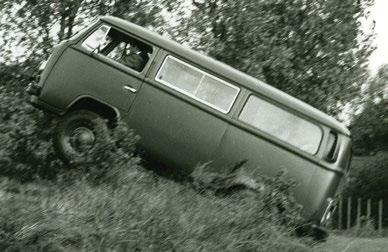

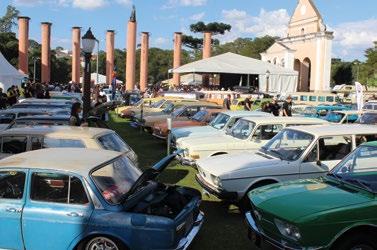

Paul Blofeld’s car is a nod to the Old Speed Racer styling and tuning, with tonnes of cool custom touches Paul has added through the years which you will read about later.
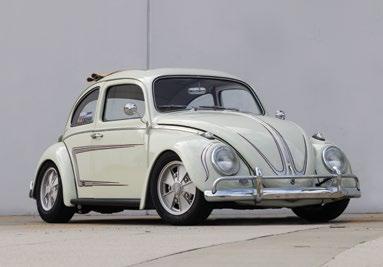

So, without funding, in 1975 Gustav set out building his own personal project in his spare time, using mostly recycled parts from the VW factory’s own parts bin.
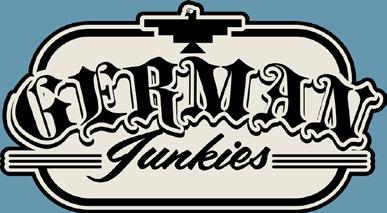
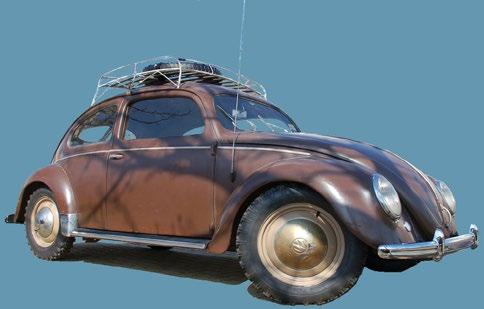


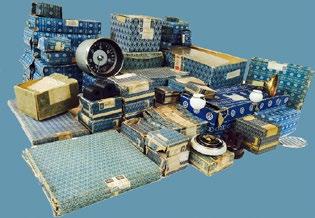
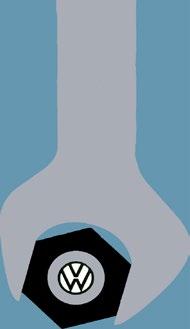





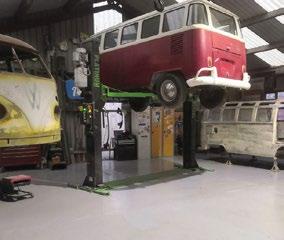

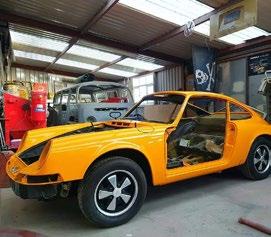
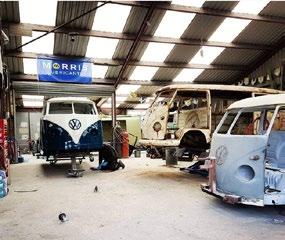
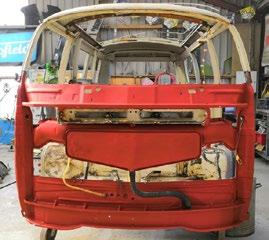
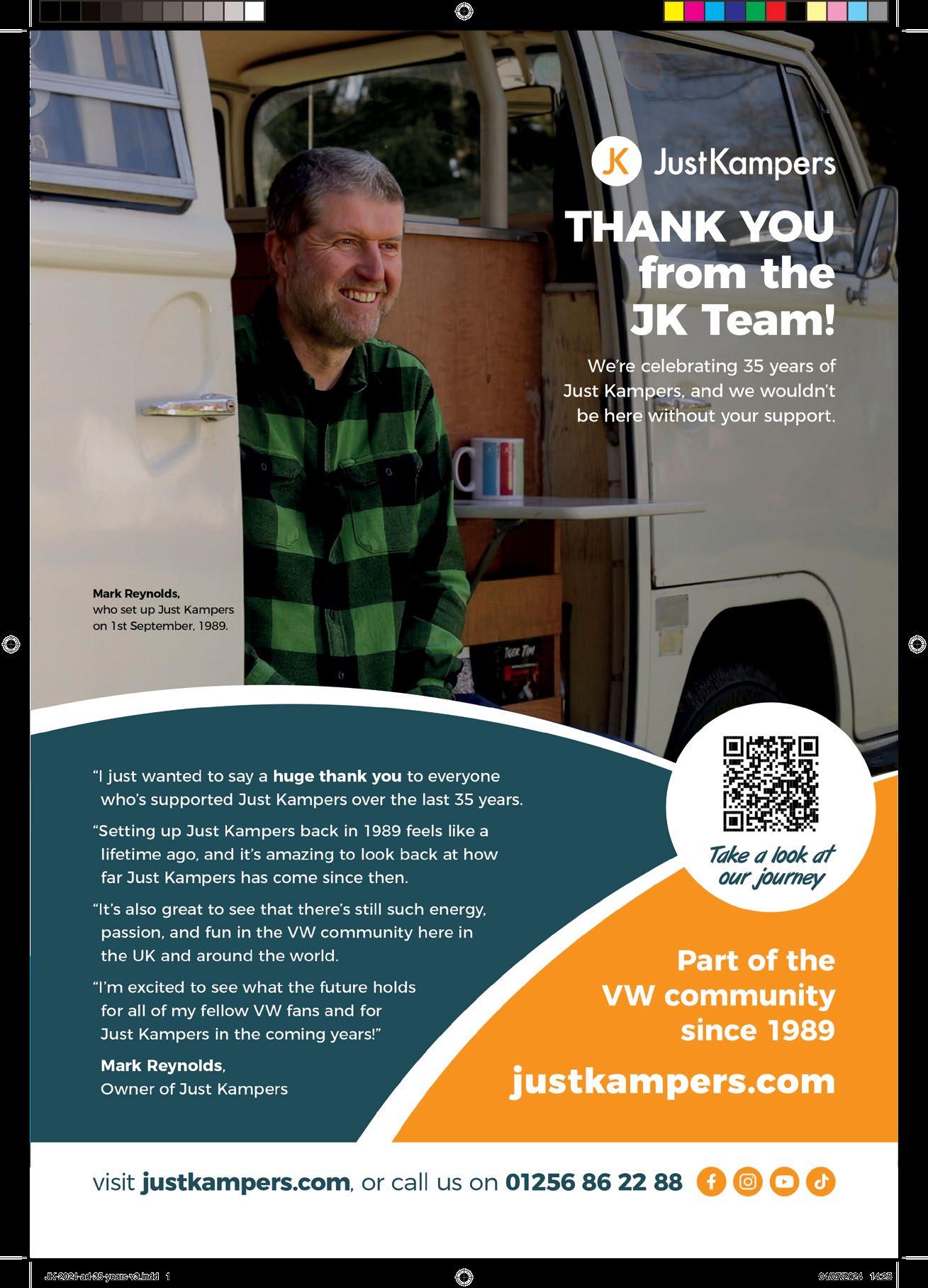

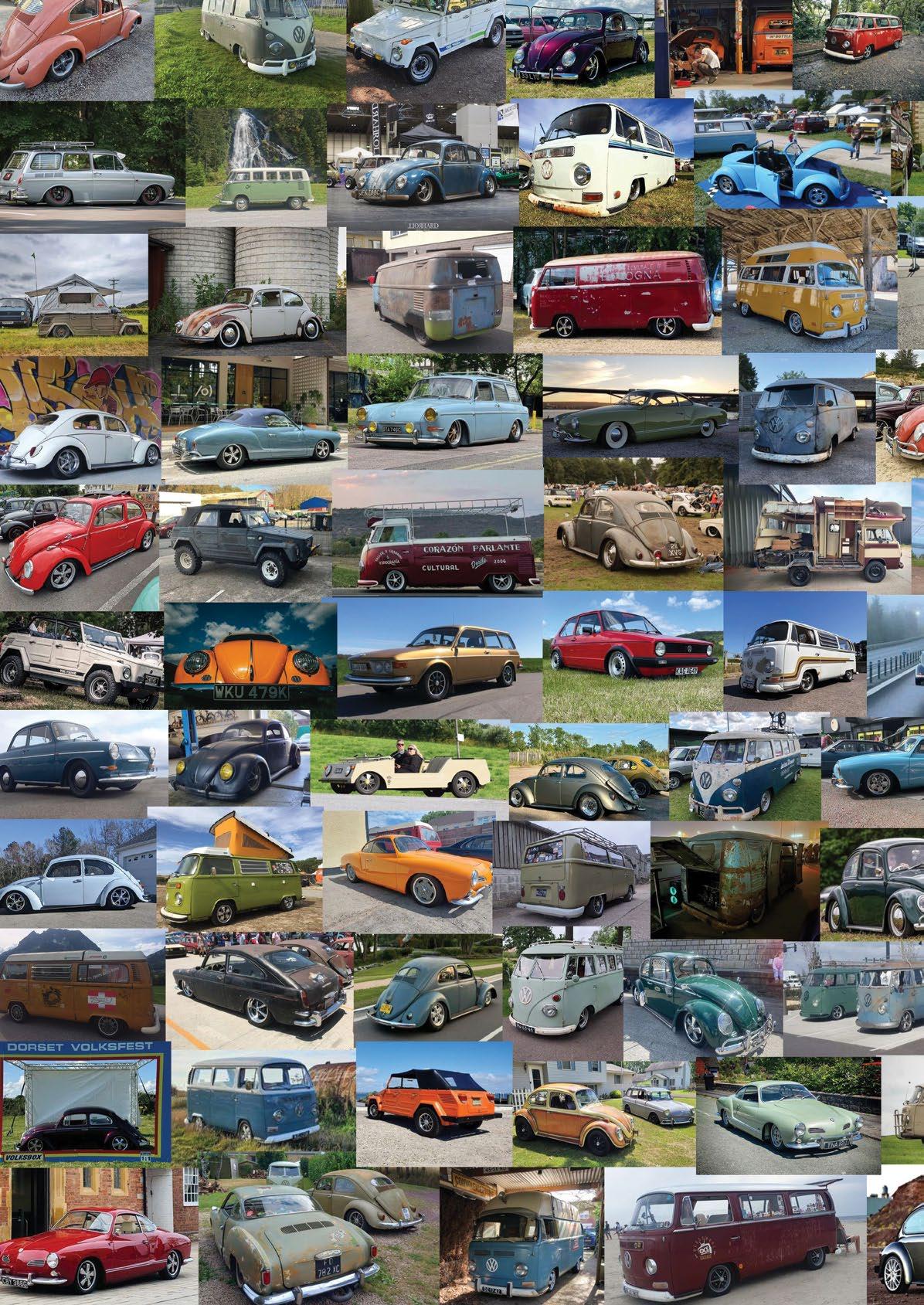


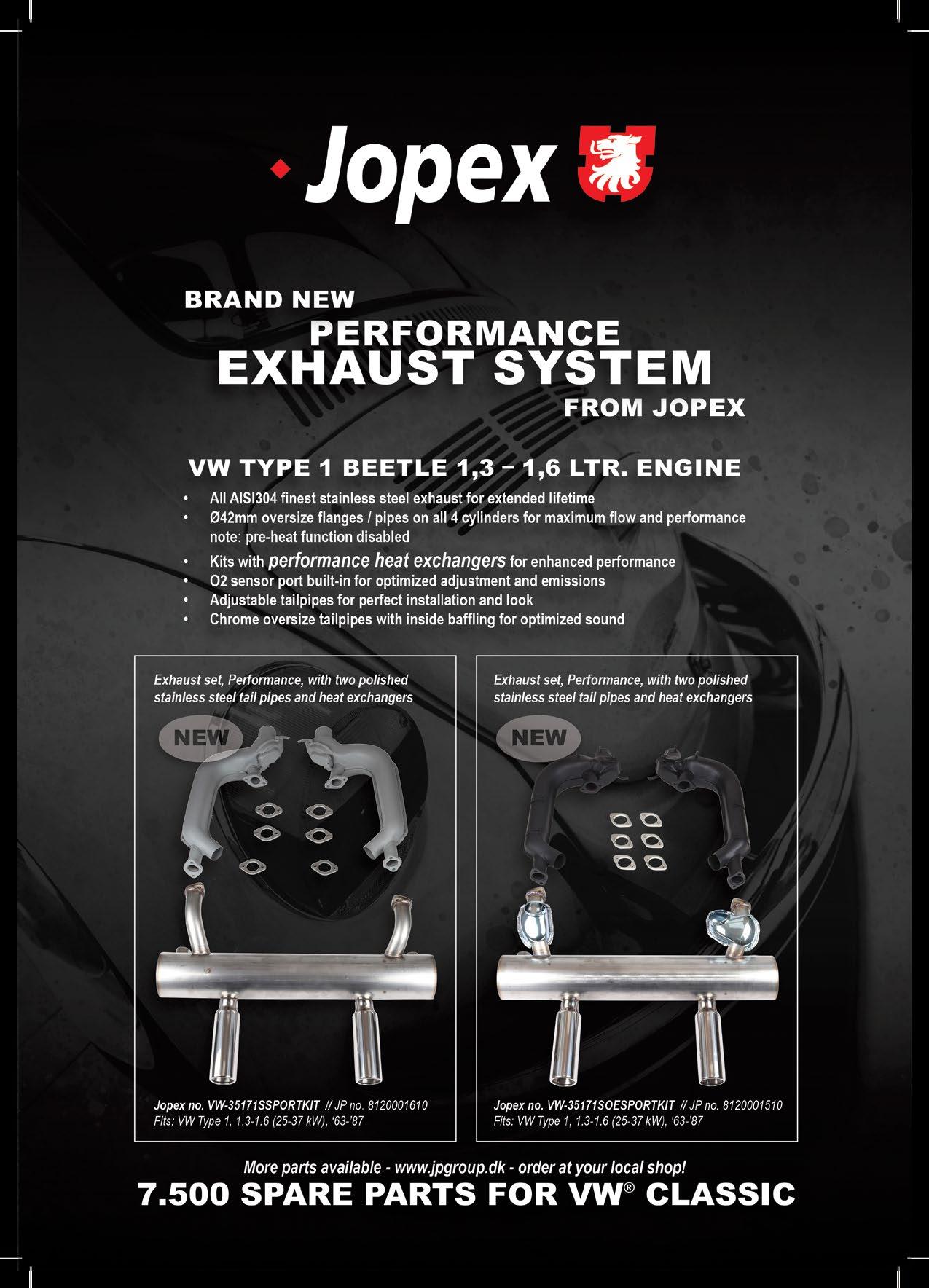
WORDS BY STEVE WALKER

JAMES RUDLAND
Someone much wiser than me once said that “necessity is the mother of invention”, and this is a statement that certainly applies to the early days of Volkswagen. From its politicised inception, its military adaptations and through to its postwar resurrection, constant development and steps into an export market, necessity was the driving force. You could even argue that the development of the light commercial became a necessity – once Ben Pon had pointed it out, of course. It wasn’t all serious stuff at Wolfsburg, though, because there was always a plan to develop a functional convertible version of the Beetle. However, the freshly appointed general manager Heinz Nordhoff wanted to retain the factory capacity for existing Beetle production (and perhaps had half an eye on the commercial prototypes and their future production needs).
Hebmüller, based in Wülfrath, and Karmann from Onasbruck were given official approval to submit versions for appraisal.

A two-seater Hebmüller and latterly a four-seater Karmann version were approved in 1949 with initial contracts for a thousand units each. It wasn’t all plain sailing, though, as for three years previously Wilhelm Karmann had repeatedly badgered VW for a base car to tamper with. Eventually the factory relented and actually forwarded the 10,000th car produced, plus a second car, which both ended up as the earliest formed Cabriolets for appraisal.
You may be wondering where I am going with this. Wilhelm Karmann wasn’t satisfied with knocking up verts and lopping the roofs off other contemporary vehicles at the time. No, old Wilhelm fancied a go at building a sleek sports car using the VW chassis! In 1950 Wilhelm junior approached VW, and let’s just say he must have been a badgerer like his father, because after many rebuffals of his sports convertible design submissions, he hooked up with Luigi Segre, the commercial

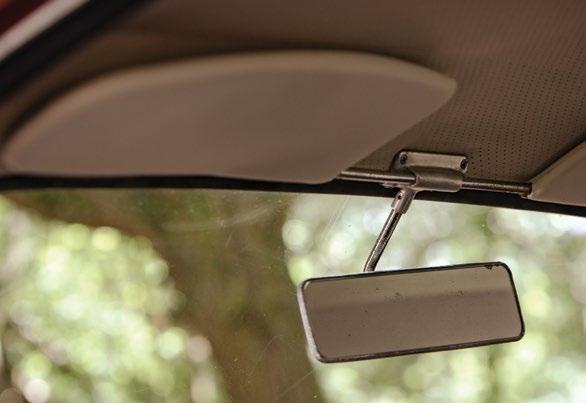
director from the Italian styling house Carozzeria Ghia, and the end result was a very closely guarded prototype. Which to Wilhelm’s surprise was a coupe – and not an ugly one either! Secrecy was paramount in the cutthroat business of car development, and whilst VW were aware of Karmann’s previous efforts, the collaboration with Ghia was not common knowledge at Wolfsburg.
The Karmann sports project finally received approval from Heinz Nordhoff on 16th September 1953, and was officially launched on 14th July 1955. The Karmann Ghia was born.
I won’t make excuses for throwing a bit of history into the mix. It’s a fascinating story if you ever feel like digging deeper. But

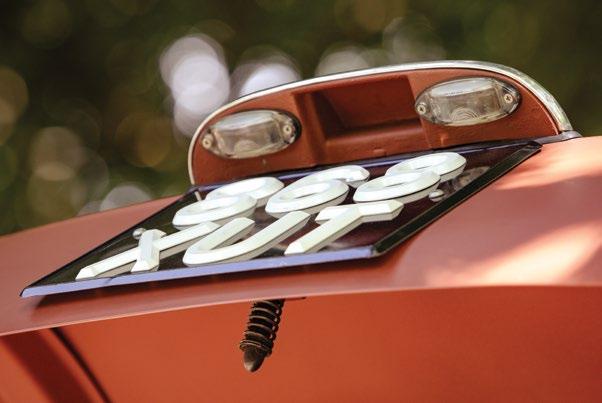
from such a belligerent start the hand-built Karmann Ghia would be made for almost 20 years. Produced alongside Porsche 356 and 912 models as well as the venerable Beetle Convertible and a few other marques that got the Karmann treatment (and still do), Wilhelm Karmann’s sporting aspiration has attracted countless admirers and platitudes along the way. If you like cars you can’t help but admire the stylish beauty of a Ghia, and that is exactly how a bona fide Porsche 356 guy named Jason Kearsley came to own and recreate the January ’59 “Low Light” coupe you see before you.
I am sure Jason won’t mind me saying that he is a very creative person. In fact creativity could also be the mother of invention,

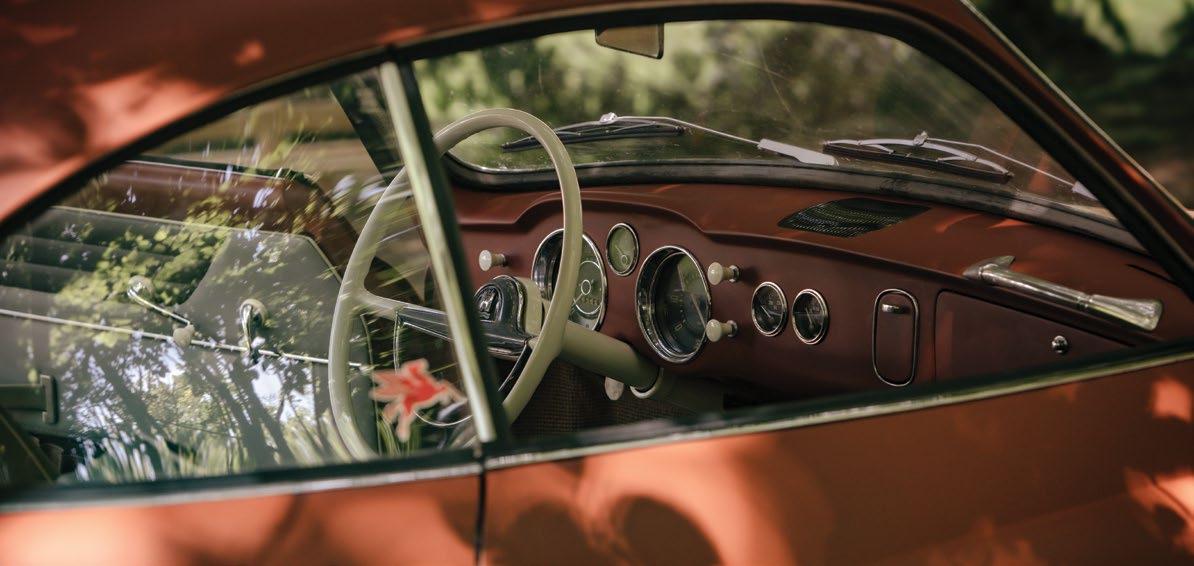
and in Jason’s case it has led to a successful business (with his best mate), creating bespoke props and models for the film and TV industry. For a taste of what this entails, www.alchemy3dc.co.uk is well worth a visit, and it also helps to explain some of the lateral thinking and hands-on approaches applied to the Ghia. If that isn’t creative enough, in 2007 Jason also designed and engineered a 12v alternator pedestal and conversion kit allowing early Porsche 356 and 912 cars to reliably run modern 12-volt systems. These have proved very successful over the years and are still a unique and popular conversion. He also modifies and re-engineers the old troublesome Solex p11 carbs into something infinitely more useable. I would say his skillset is well established.

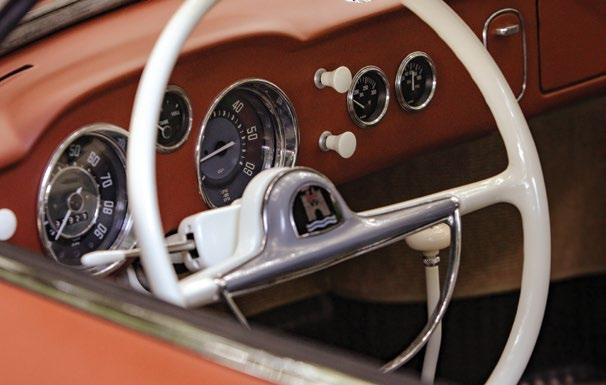
Before we crack on with the Ghia, I should say that being into early Porsches wasn’t always an expensive hobby. As recently as the early noughties they were very niche, very cheap and overlooked by all but a few (mostly ageing) devotees. As a consequence, finding parts within those close circles was relatively easy, and Jason started picking up bits and pieces for his ’62 coupe project (still ongoing). He soon amassed enough engine parts to rebuild the project’s powerplant and assemble another from the bits left over. This snowballed over the years, and four fully restored engines have since been built as a sort of therapeutic exercise –one of which resides in the back of the Low Light.
Ghias were always around in the 86 and on VW scene, but it took


a couple of cars in the early 2000s to really kick-start specific interest in the Low Light (that’s pre-’60, give or take, when US lighting laws necessitated the raising of the front headlights, and a general re-design overall). These cars were a heavily sunburnt ultra-slammed coupe christened the Zombie, and a super clean Cognac coupe on 5 bolt Sprints owned (still) by Paul Taylor. Both Jason and myself – and I suspect a lot more – were instantly hooked. I did nothing but pester Paul Taylor. And Jason found a Cal imported coupe with a touch of ’90s custom, and set about building the early Porsche-inspired car you see on these pages.
Phase one started 14 years ago with some minor repairs, a set of 5-spokes and a coat of red oxide; then in 2017 the restoration started in earnest, starting with bare metal and a complete strip down. Jason did all the work himself, so with that in mind the following list is pretty impressive. However, it’s the standard of finish and execution that makes this car really stand out. Study the pictures closely and things will start to fall into place.
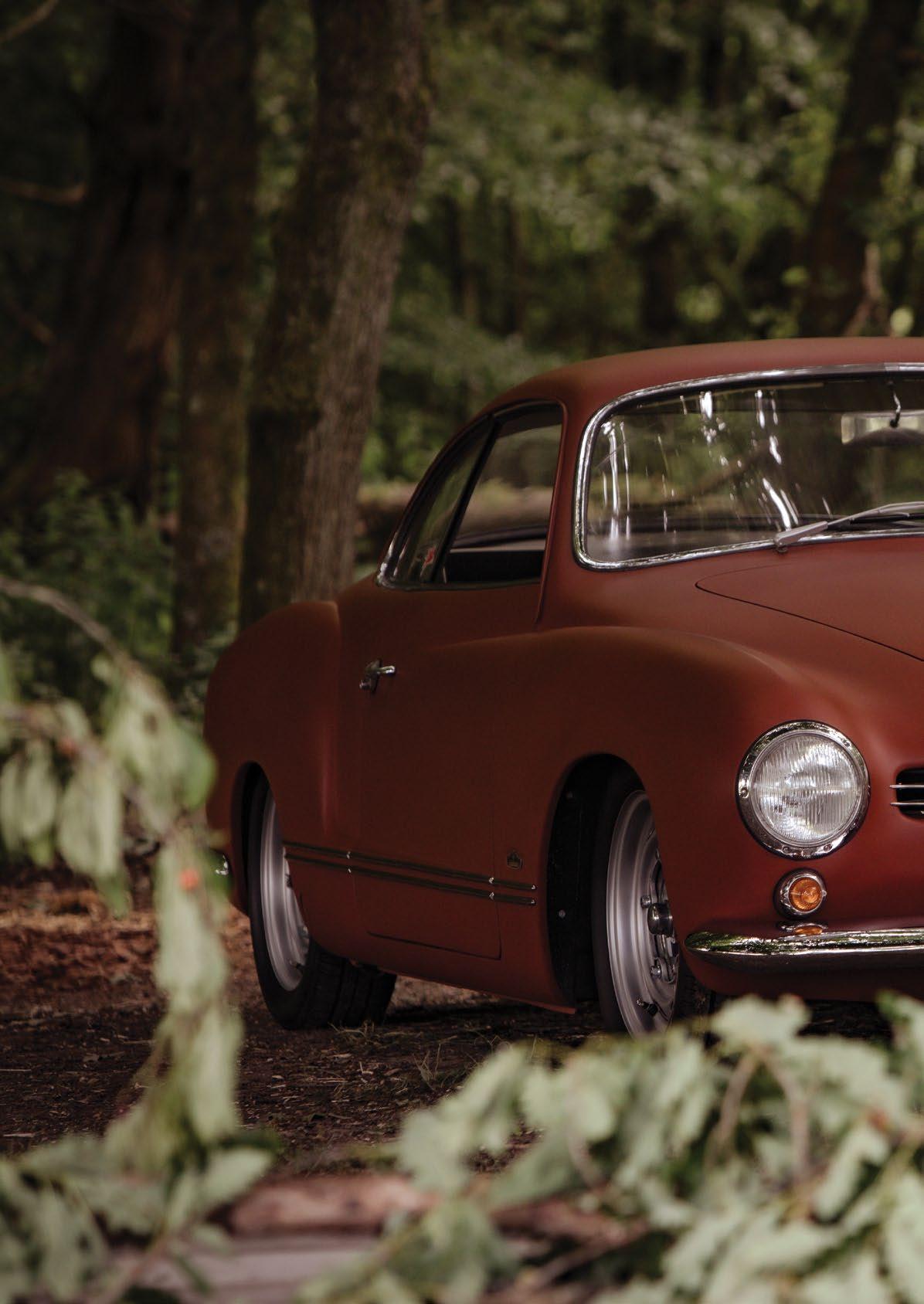
with scratch-built tin-ware and a one-off custom made Sebring exhaust being just a couple of the modifications needed to fit a wide 356 unit in a space designed to accommodate a tiny 30hp motor. You could be excused for thinking it was built that way, the finish is so good, but that was part of the plan. A sort of periodesque Vintage Speed build that could easily be a product
of the ’50s and ’60s, when countless chaps and chapesses were modifying their VWs and throwing them into all types of motorsport and competition. Or perhaps, as some engineers at Karmann might have done had they liberated a few parts from the Porsche assembly line. As far as I know they didn’t, but maybe the mk1 gti almost 20 years later wouldn’t have
Welding! Actually, not too bad for a Ghia. The usual (broken) nose which needed treatment, return edges of the lower front wings and a few minor let-in repairs. The shell was really good, and when Jason couldn’t decide on a final colour, indecision became the mother of red oxide. It worked the first time, and also gave a subliminal edge that could well be traced back to his formative years and an interest in custom cars, so Jason painted it red oxide again.
The beam was a narrowed 4”, with dropped spindles and a set
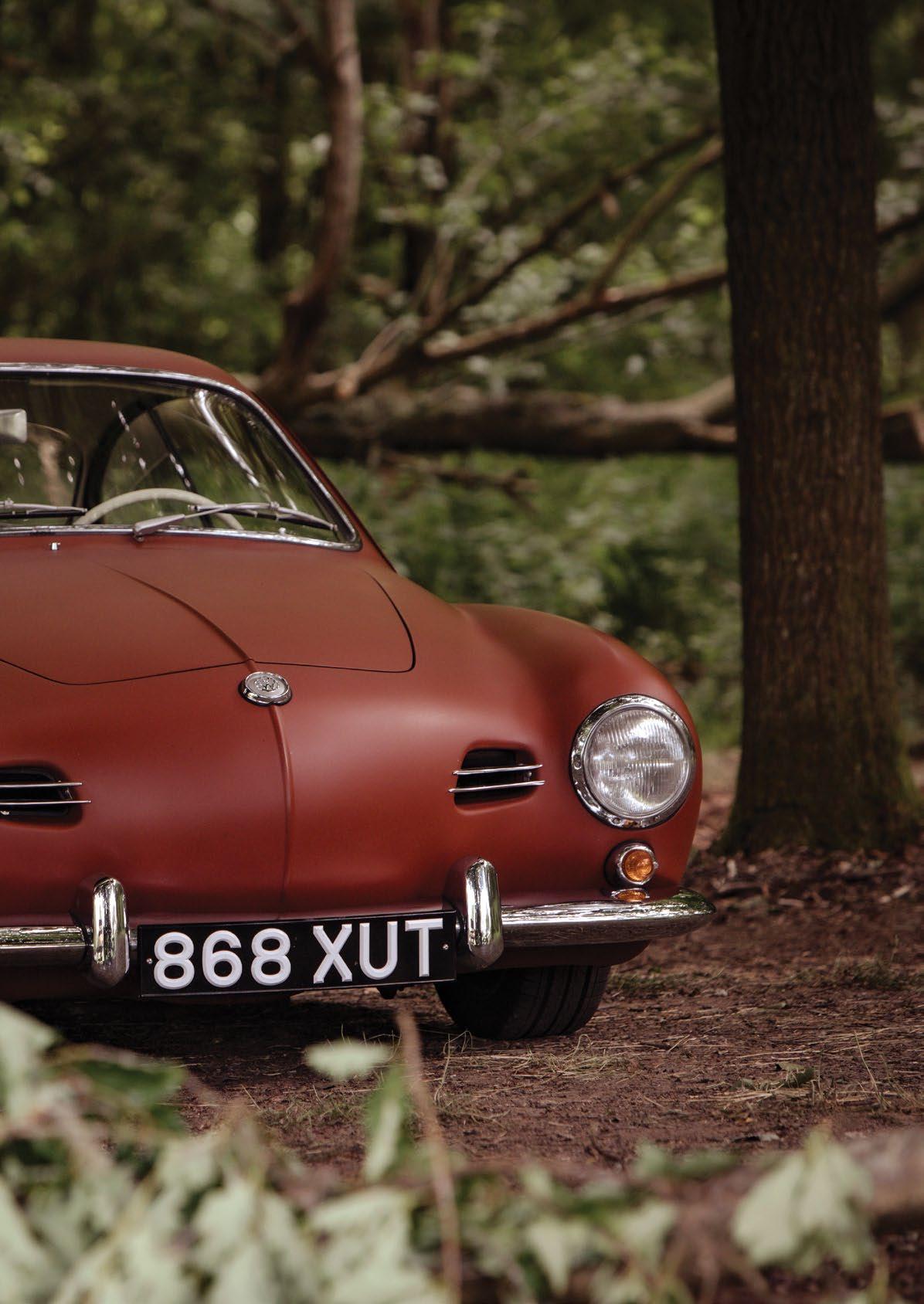
been such a surprise if they had set the precedent.
The engine itself started out as a lowly 60hp “normal” unit from 1960 (which I am convinced is intentional, when you realise that all the restored original KPZ 356 wheels on the car are date stamped 1959). It was completely rebuilt using 1720
of CB Performance disk brakes. As they didn’t match the original 356 drum brakes allocated for the rear, a one-off pair of hub plates were made to give the illusion of Porsche drums all round (I told you he was creative). Rancho provided a Pro Street gearbox (388/tall 4th gear) to cope with the revised motor and also to give a high speed motorway cruising capability, and a jiggle of the spring plates sorted out the stance. The engine itself is a work of art, one which even die-hard 356 aficionados would drool over. Contrary to popular opinion, they don’t “drop straight in, mate”,
AA barrels and pistons, Neutek SX1 camshaft, modified cylinder heads to match the later Solex manifolds and a pair of Jason’s rebuilt and machined 41mm Solex p11 carbs. The engine was also modified for full flow oil cooling and is fed via an electric fuel pump and Malpassi fuel regulating filter. The engine produces around 100hp and has a fantastic torque delivery. I

can definitely vouch for this as he left me for dead when hitting the M4 slip road after Classics at the Clubhouse.
The devil really is in the detail in this car. Aside from the bespoke parts, there are features and processes that not only take a great deal of time and dedication to complete, but could easily be left untouched and no-one would really know. I mentioned the wheels earlier, but the vintage tyres are actually modern items which Jason painstakingly sanded
then polished, removing all the sidewall lettering, before making a Dunlop stencil and painting his own logos in place.
It doesn’t end there, because the car was always missing a few Low Light specific bits and pieces – so instead of hunting out grubby swapmeet parts, Jason made them. The replica door pull strap, arm rest, dash knobs, window cranks, heater control knob, plastic horn push and rear window vent were all custom made by Jason. The seat covers and door panels, on the other hand,
were made by Lenny Copp and West Coast Classics, in the traditional Low Light style –fitted by the owner, obviously. The German square-weave carpets were made and fitted by Mark at Mad Matz. In fact Jason said the visit to Mark was the only time the car left his workshop.
Like all restorations, it’s the small fiddly stuff that takes the time – painting this, cleaning that, fitting a rev counter that matches the speedo in the space where the original clock once sat. Then there are the collars and
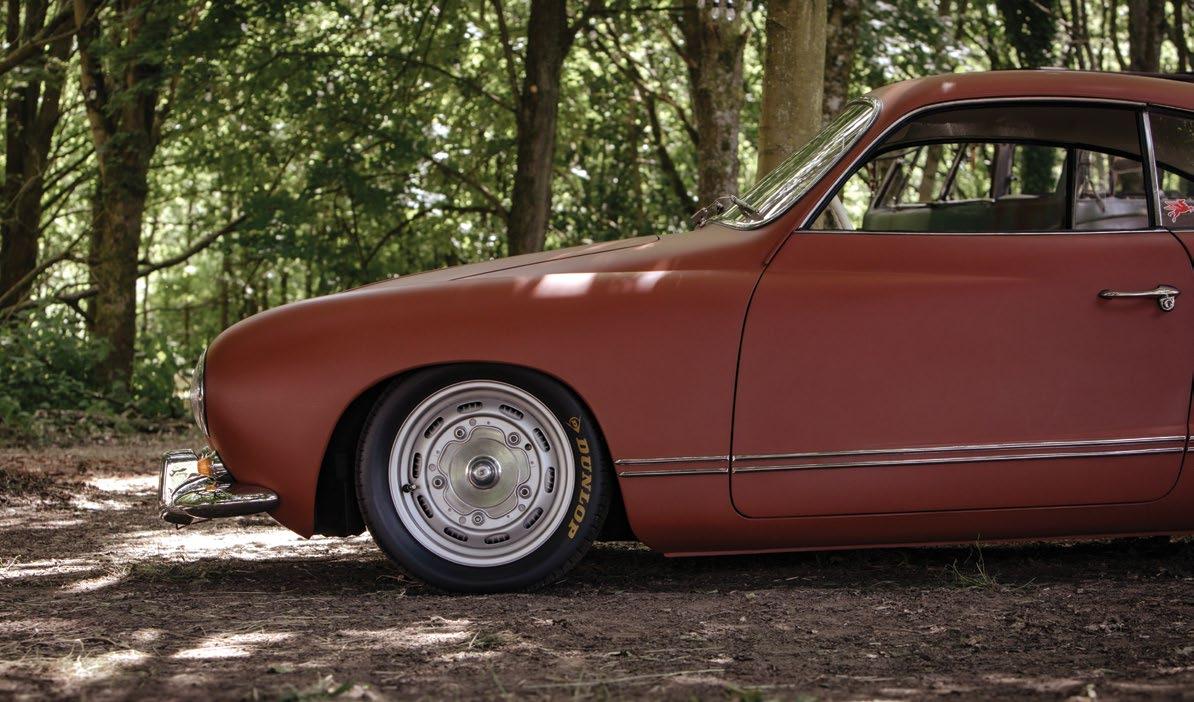

cuffs: rechroming tired bumper sections, polishing and straightening trim, refitting new rubbers, polishing the light lenses, the glass, anodising every bit of metal applicable, and generally doing all the things that after 14 years you want to do once and forget about.
Now I am smitten with this car. It goes way beyond simple Porsche power, or even a restoration. The thinking and engineering behind it are enough to keep most viewers busy for a good while. You know we have
barely scratched the surface as far as the amount of work and level of finish go, but the good news is that it gets driven! View this as an introduction, and see the car for yourself if you get the opportunity – Jason is a nice guy, and built a car for himself that invites further inspection without the “look at me” narrative that is often prevalent. The fact that his standards are exacting just happens to be the way he works, the Porsche crossover, just what he likes – and his car just happens to be fucking awesome (in a subtle kind of way).
There are usually a raft of thanks at the end of each feature, but as Jason did 99.9% of the car himself he is going to dedicate this to his dad Derek Kearsley, who is sadly no longer with us. His love for classic cars and engineering background are the foundations and inspiration which Jason proudly cites as putting him on the right path.

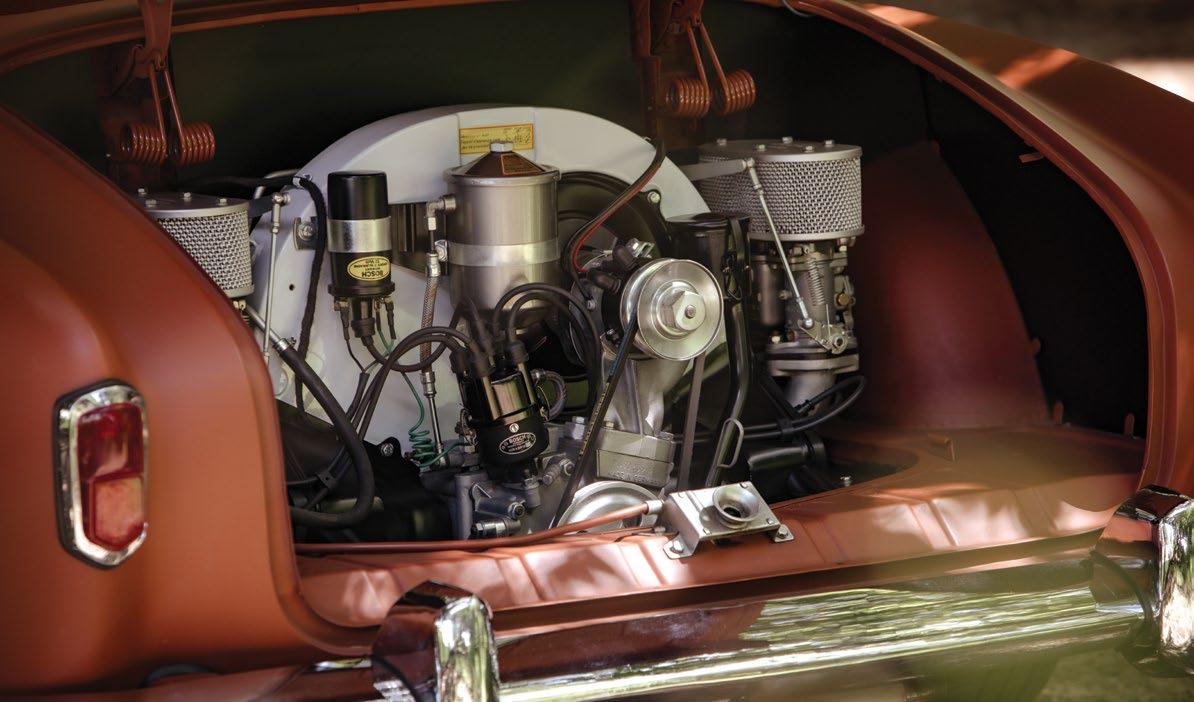
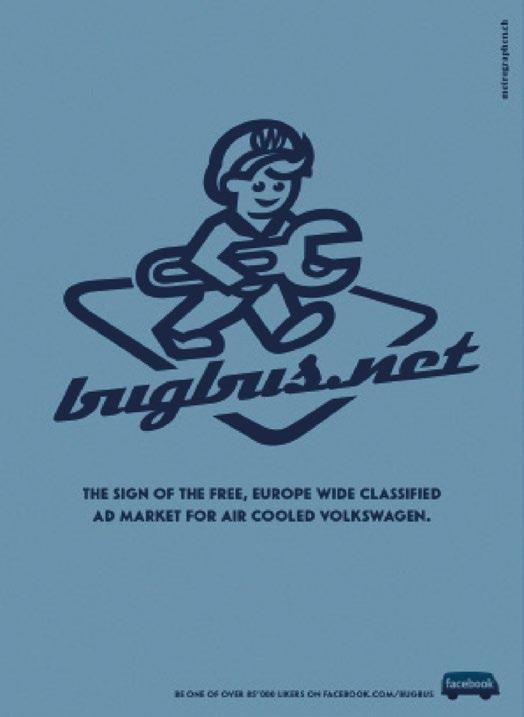

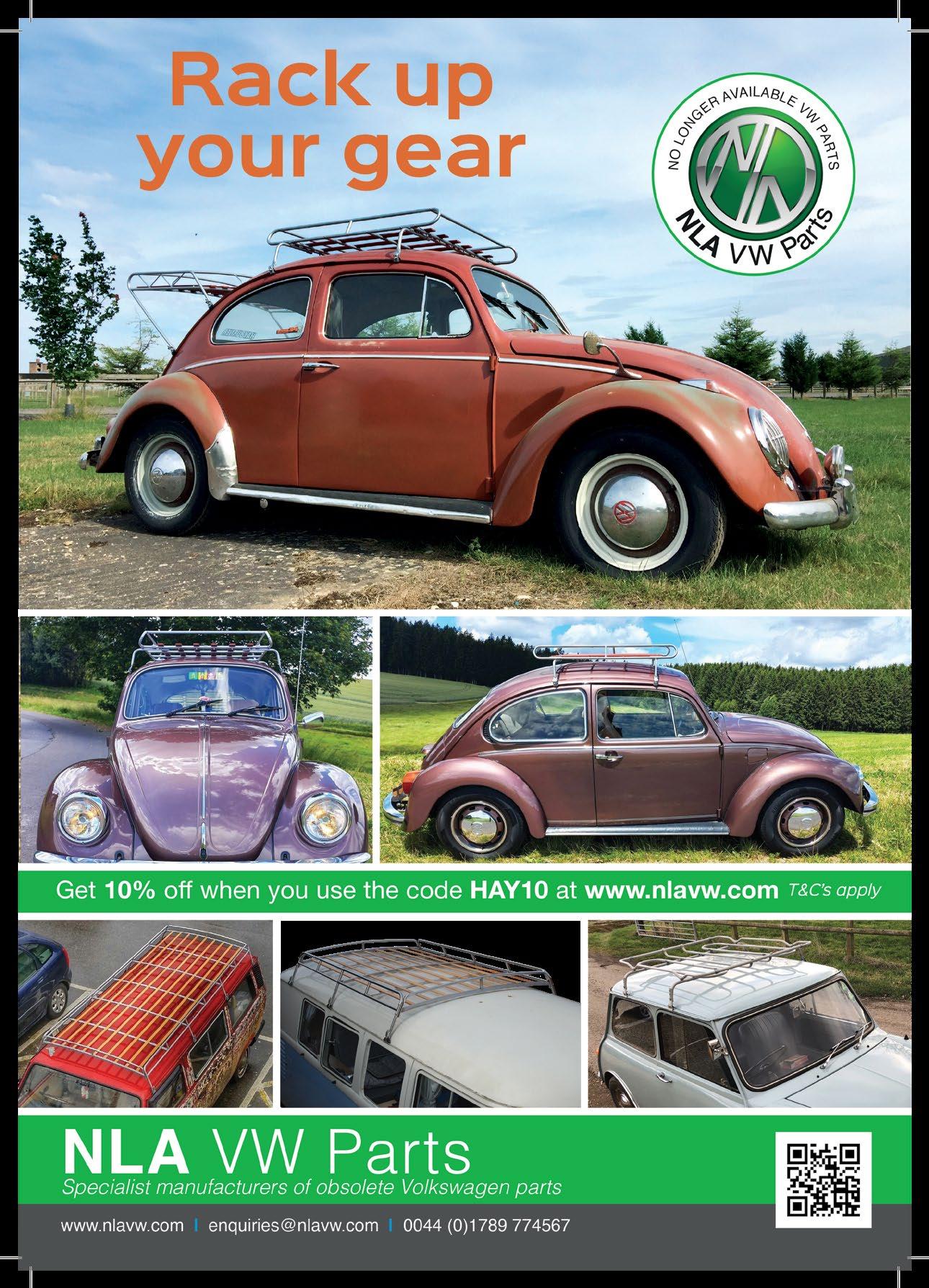


We asked for photos of your Barn-finds, Forest-finds, Field-finds, Garage-Finds etc...
These guys came through with these ‘as found’ photographs of interesting VW/Porsche vehicles that have been hunted out by our readers over the years.
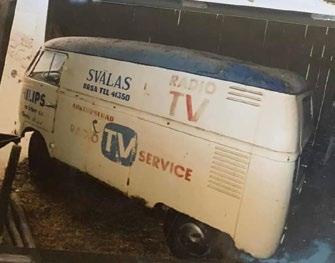
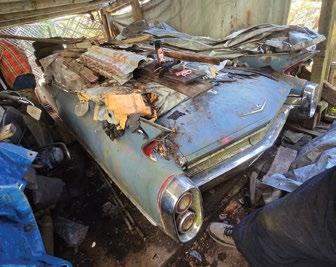
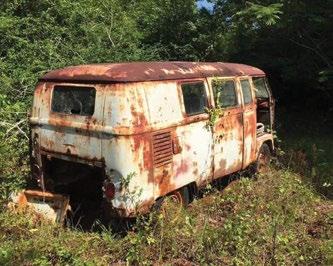
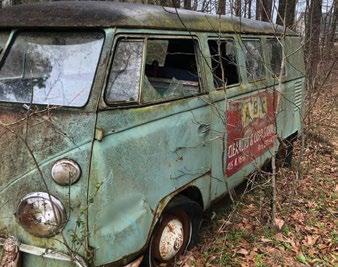

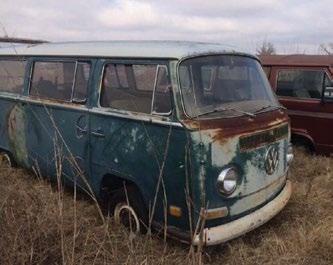
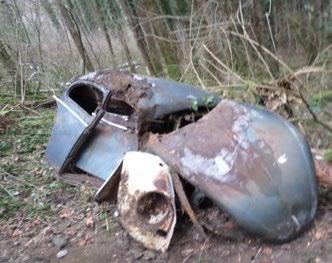
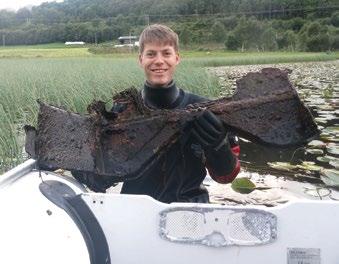
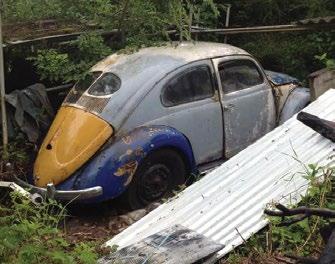
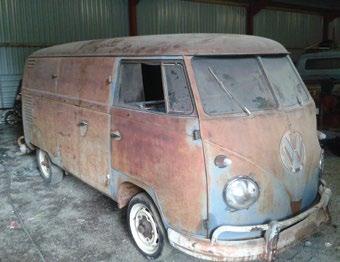



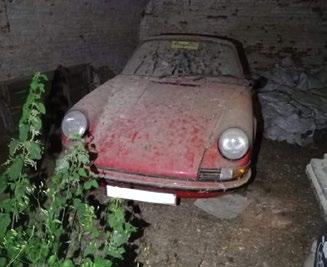
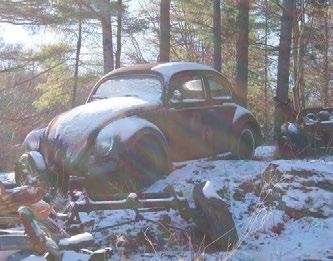





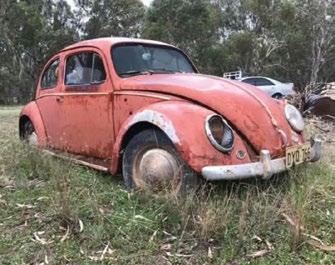
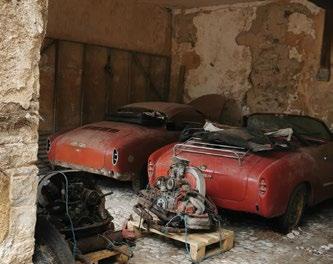
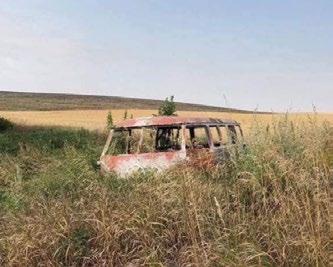




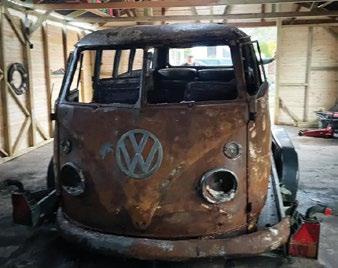
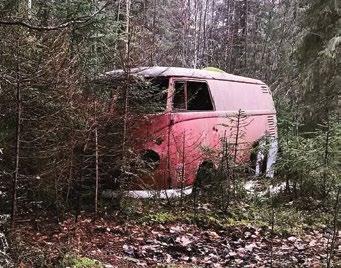

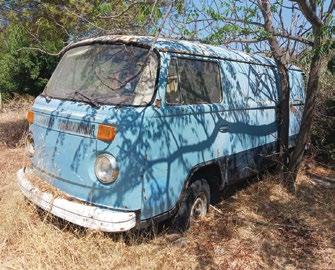
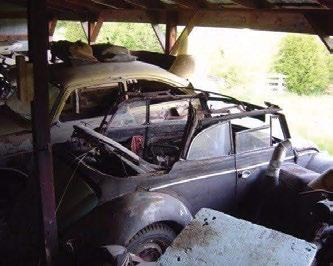


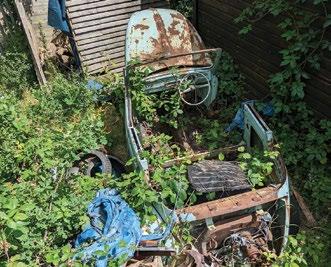
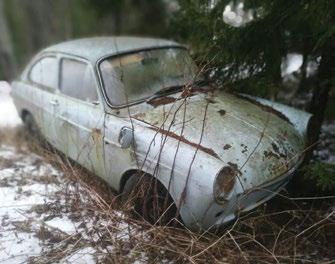

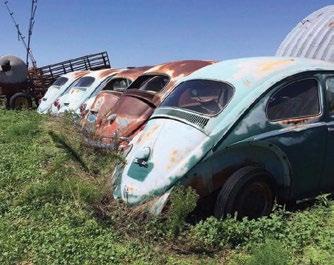



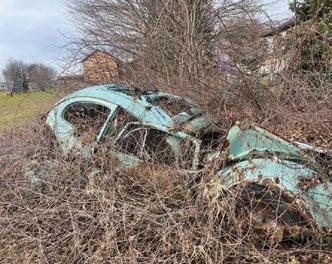
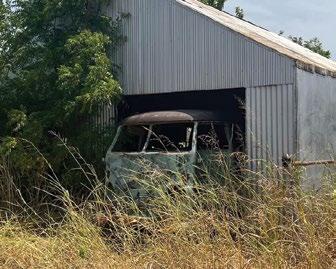
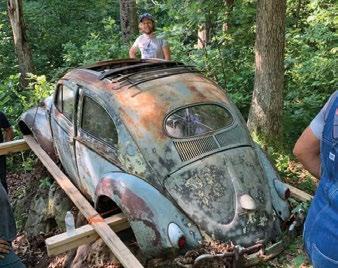


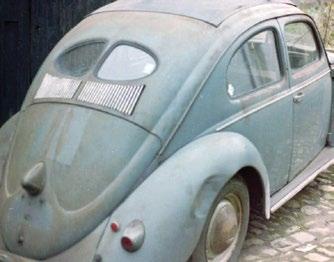

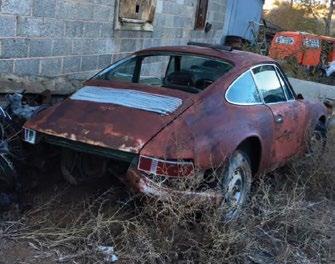
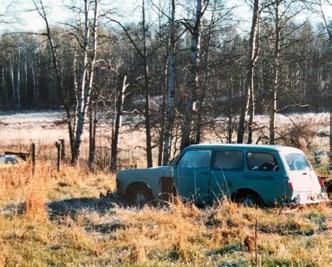
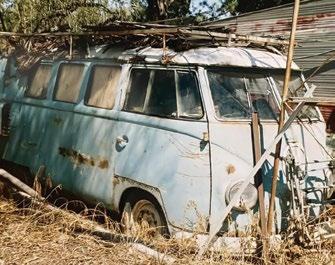
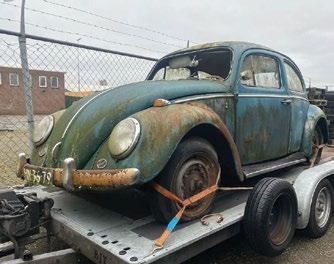

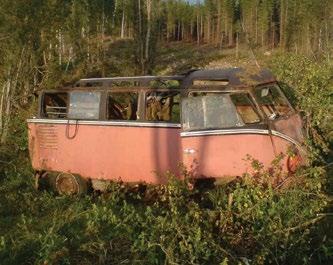

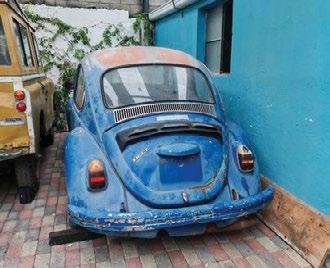

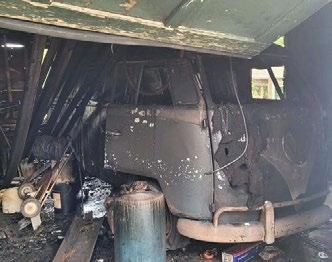
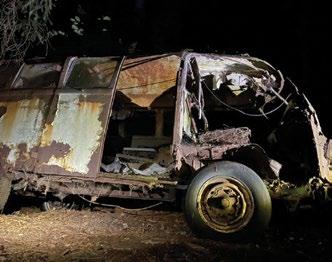

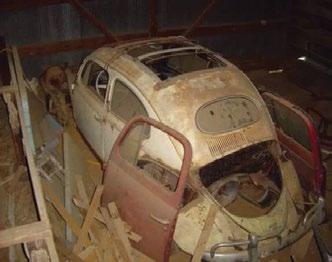

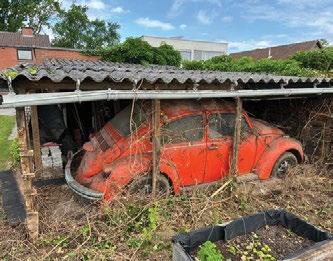
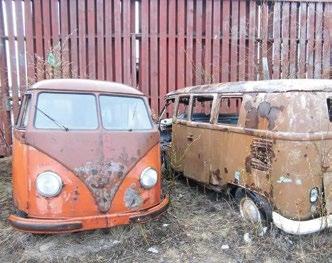

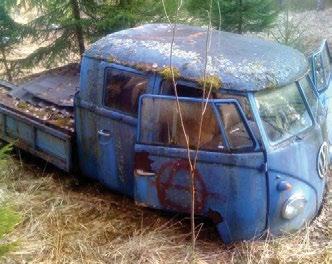
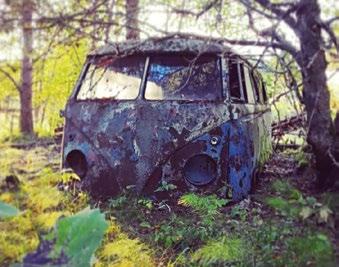

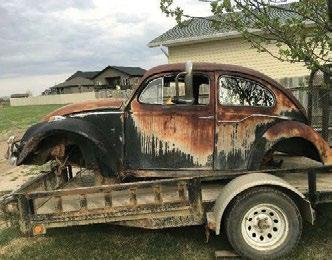
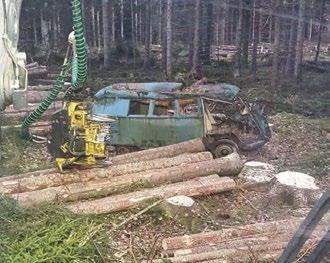
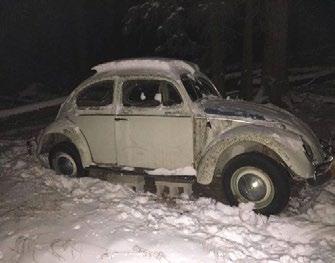
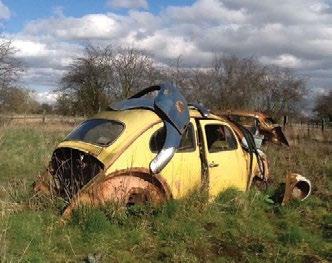
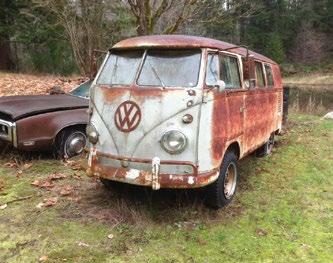
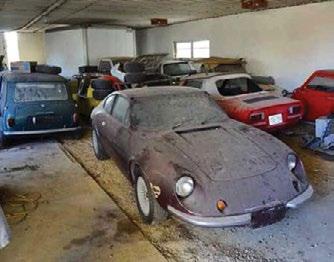

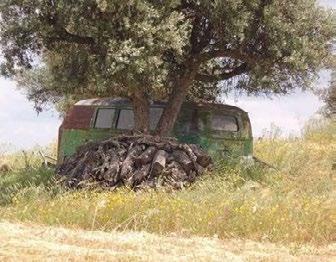

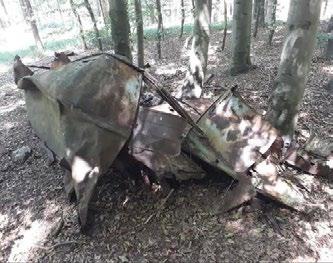
WANTTOADVERTISEHERE?PLEASEEMAILadvertising@hayburner.co.ukFORDETAILS
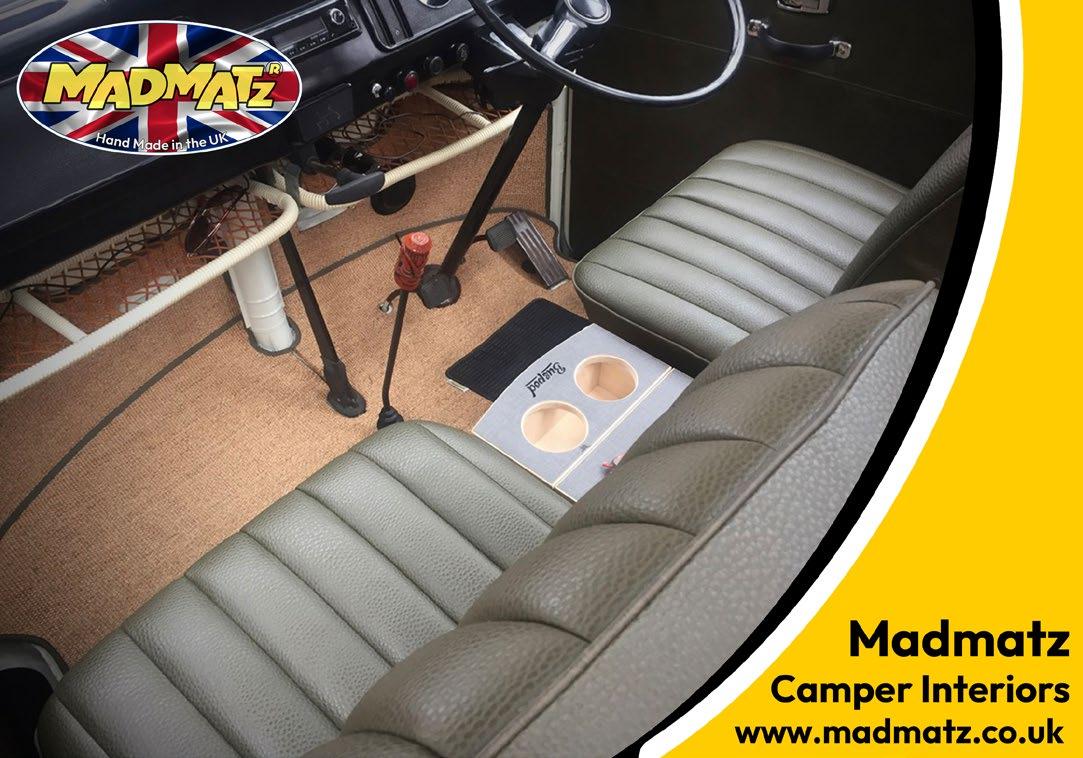
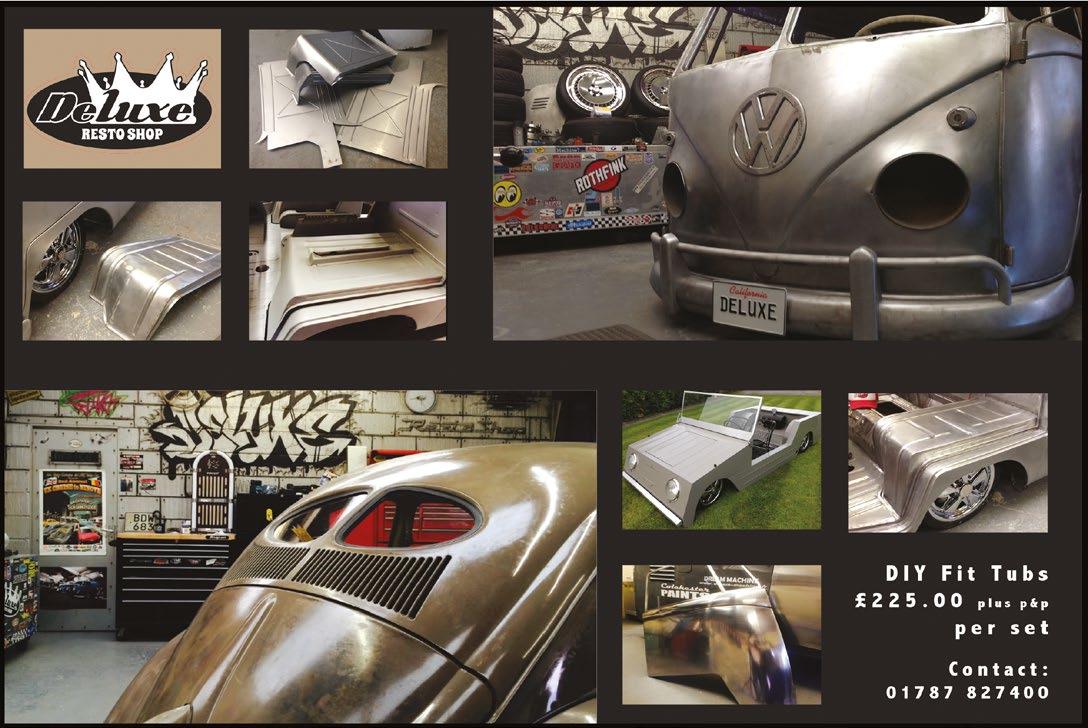







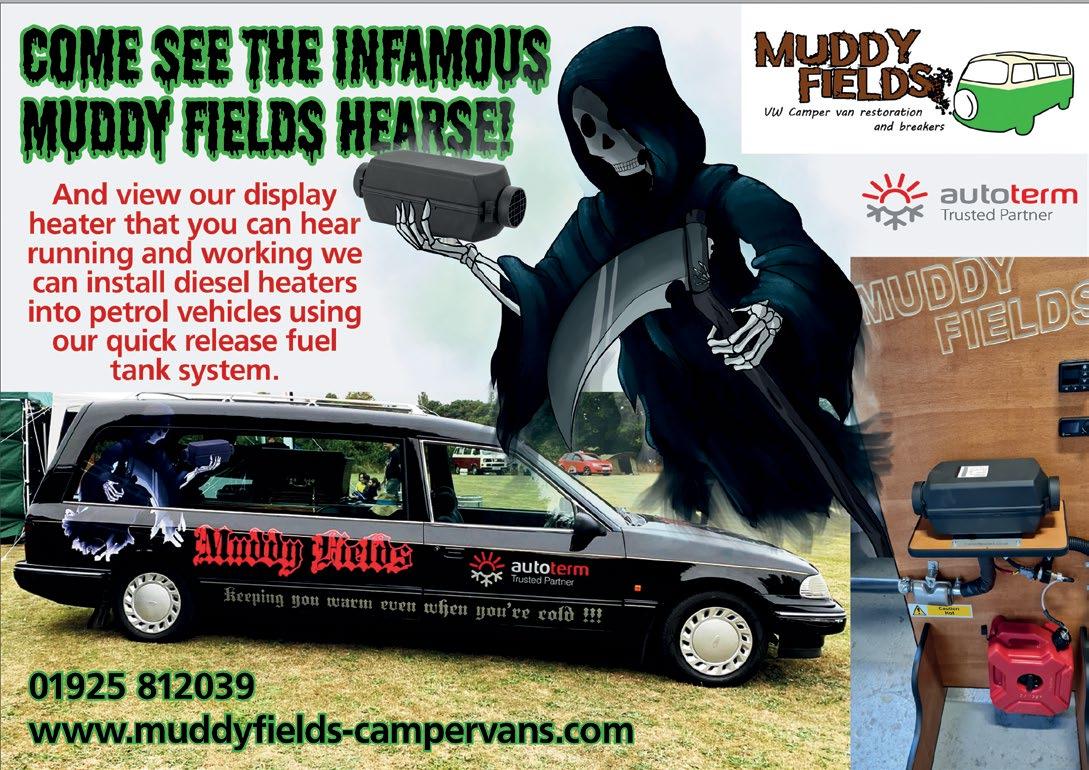

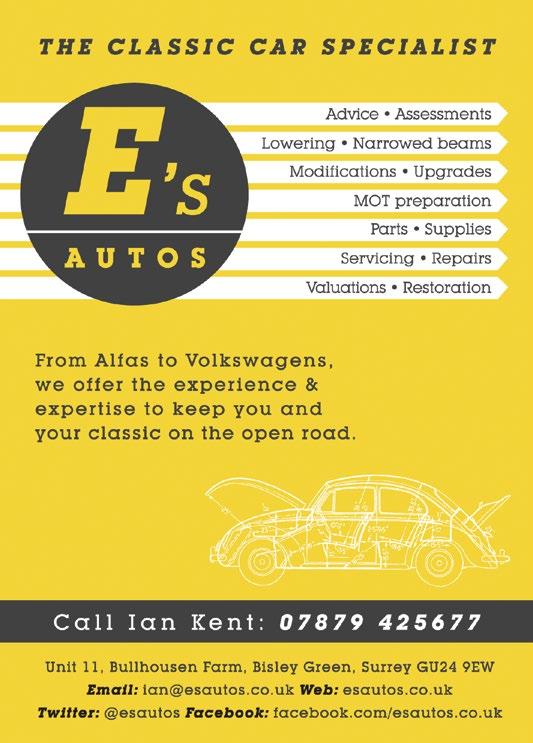

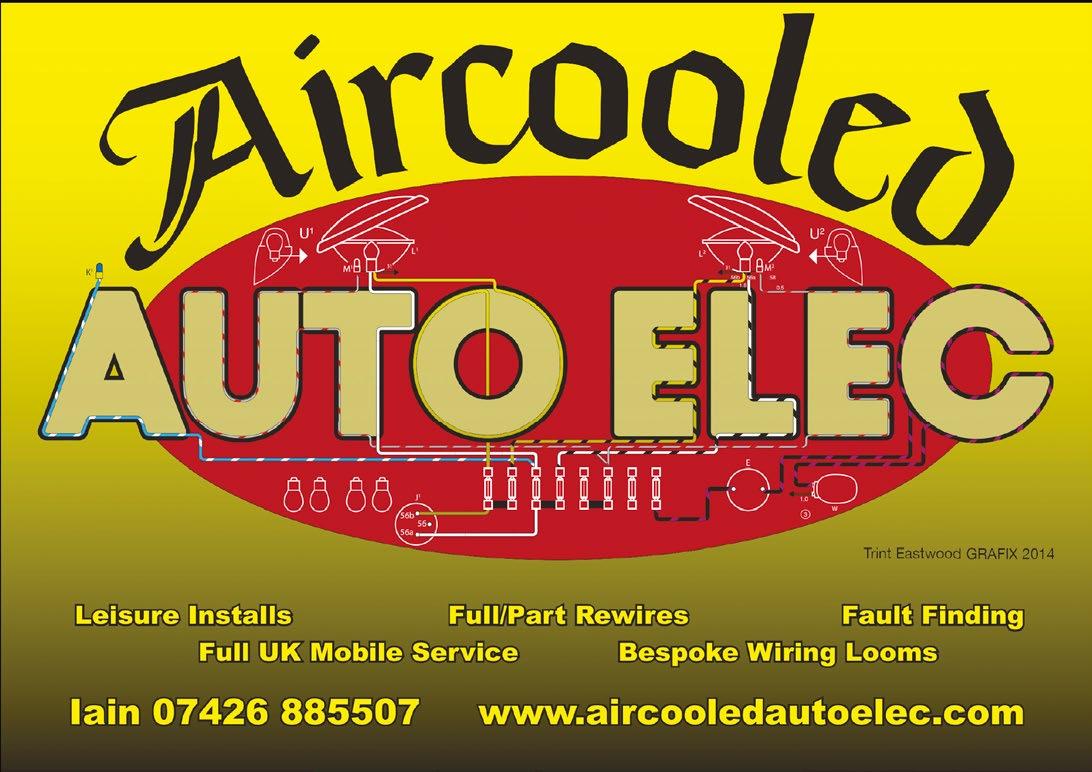
WANTTOADVERTISEHERE?PLEASEEMAILadvertising@hayburner.co.ukFORDETAILS
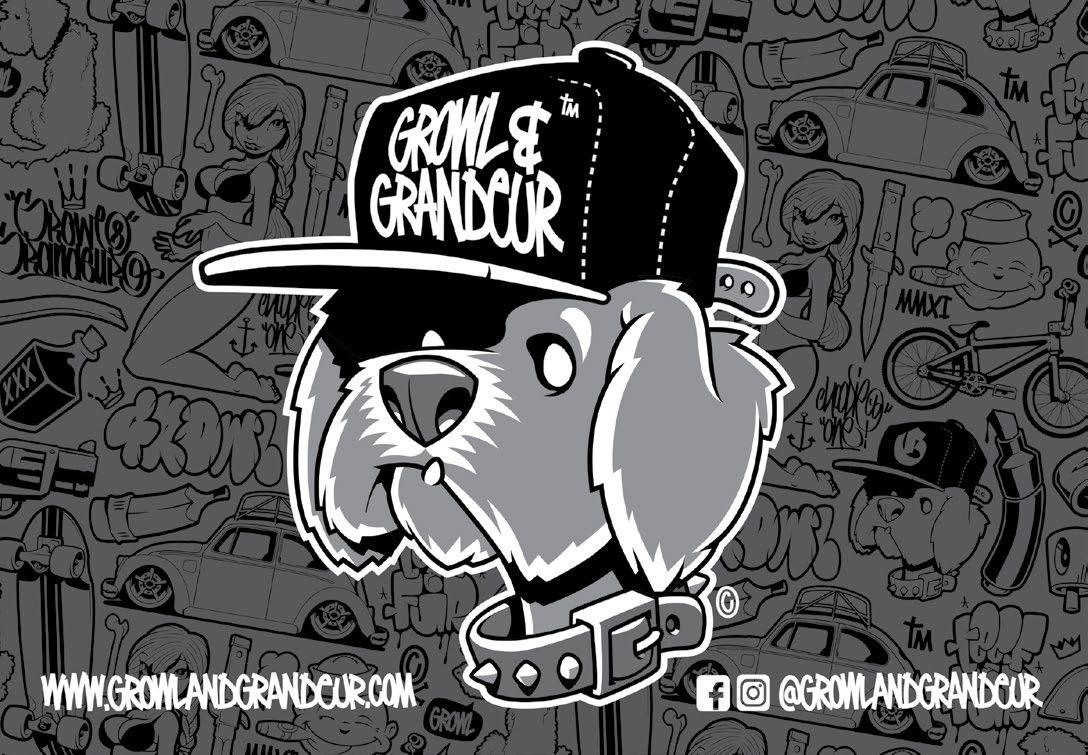
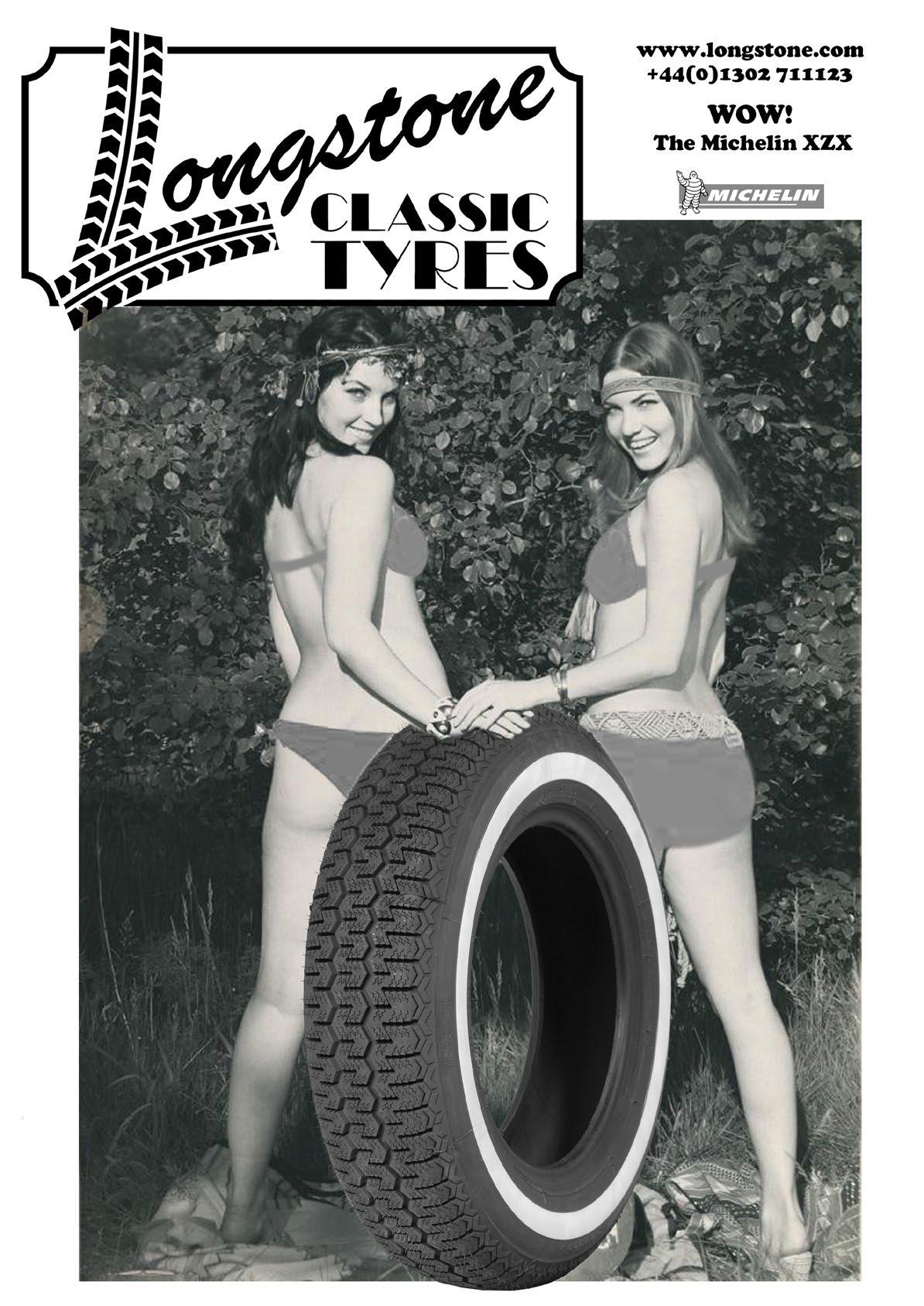
I think this has to be on my list of Volkswagens I’d love to have a drive in. Having driven my Split off-road, I found it surprisingly capable though a little brittle for the job at hand. It made it up the slopes and seemed to get out of the mud without any real issues, but when I parked it on a piece of really rugged terrain with the front wheel off the ground just to snap

a hero photo, I found that the chassis were twisting so much that I couldn’t even open the cab door! Being 68 years old and pretty basic to begin with, my bus’s offroad phase was rather short lived. However, the thought of a very slightly more modern reinforced shell with the same engine/box/ suspension configuration but actually set up for 4x4 is very
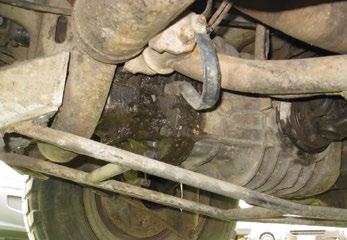
appealing to me.
It seems that it was also an appealing concept for Gustav Mayer, the head of Transporter development throughout the 1970s and 1980s. Gustav Mayer is a name that I feel isn’t quite as well-known as it should be when it comes to VW history. He worked for Volkswagen alongside Heinz
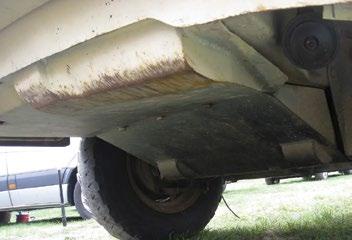
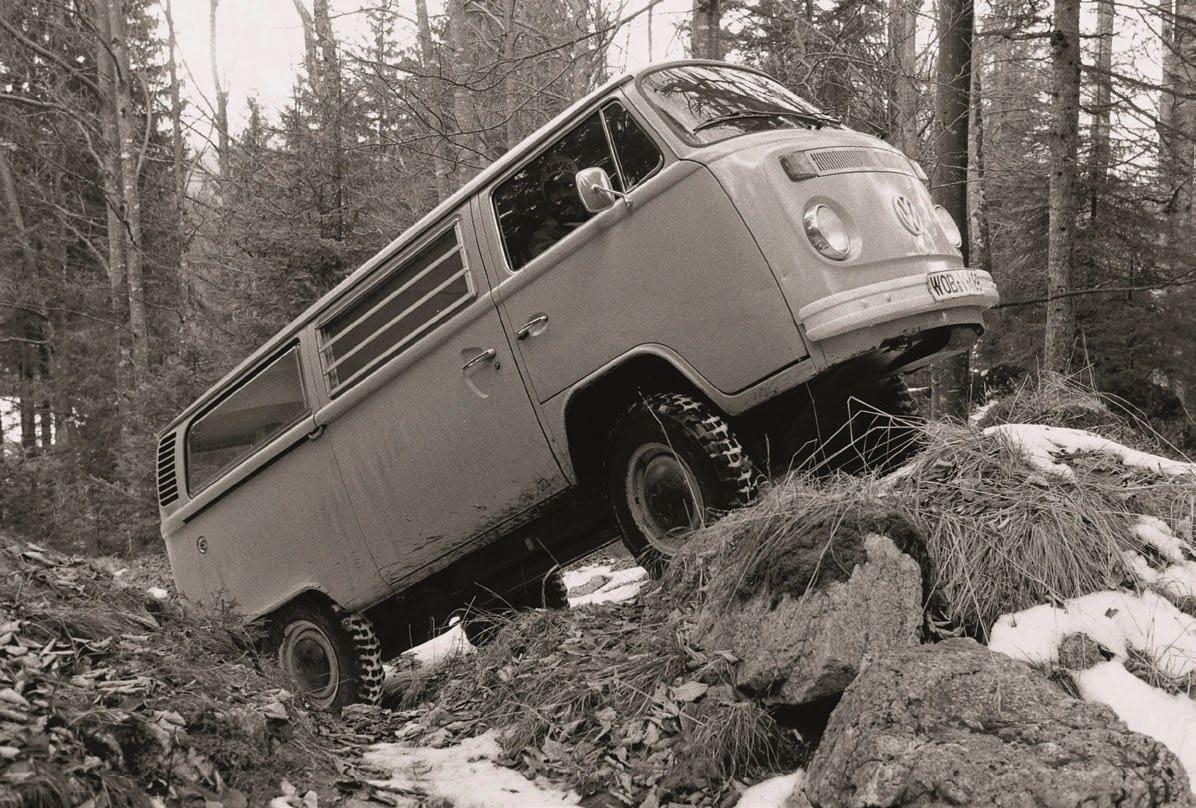

Nordhoff as a designer during the 1950s, putting out some seriously ahead-of-its-time work, being the first to combine McPherson strut suspension with a front-wheel drive and its associated steering mechanism. His prototypes for this setup were around over 30

years before VW actually went for it! As well as being an ideas man and designer, Gustav was also a talented engineer. One of his favourite pastimes was as a bit of an explorer who spent a lot of his time away from Wolfsburg, touring Africa in his own personal Bay Window. By the mid-70s the Bay had been well and truly put through its paces, being used for hauling goods, taxis, touring, camping, ambulances, fire engines and various military uses. Gustav knew the Bay was capable and he made it his mission to find out

how much further into the Sahara it could go if the bus was just a little higher off the ground and had 4-wheel drive.
There were various failed attempts to have the new CEO of VW, Toni Schmücker, officially back the project. Unfortunately, he had bigger problems to solve
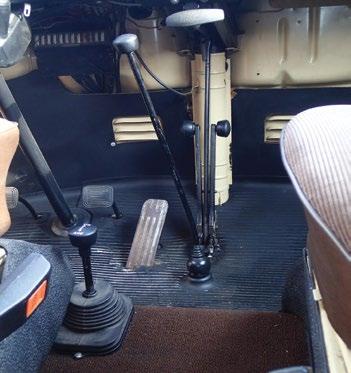
than figuring out how to give the Transporter the ability to keep up with a Land Rover in the desert. At the time VW were losing money and its American sales were falling. Schmücker closed a factory in Australia and slashed the workforce in Wolfsburg. So,

without funding, in 1975 Gustav set out building his own personal project in his spare time, using mostly recycled parts from the VW factory’s own parts bin. With the help of friend and colleague Henning Duckstein from the research and development department, he was given clearance to use machinery and even milled his own parts when he needed to. The arrangement was for this to be his own personal vehicle and in no way an official Volkswagen project, to the point that when executives asked
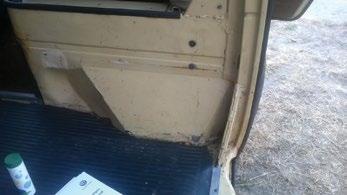
Gustav what he was doing over the Christmas period his answer was “to drive into the Sahara in the now-completed 4-wheeldrive Transporter that you have banned”.
Gustav got the bus finished in time for the festive period. He put it through its paces and found his prototype very capable. Its boxy proportions and driver’s seating position gave an unobstructed view of what lay directly in front of them. This was a real advantage compared to other off-road vehicles on the market. He also discovered that the 1600 twin port was severely underpowered. With the bus performing so well in the data he had collected, VW’s executives just couldn’t ignore
the fact that this creation could potentially fill a gap in the market, so in 1978 Schmücker gave the nod for five official prototypes to be built.
Converting the Bay to 4-wheel drive from scratch is no walk in the park. Gustav used 16” wheels and modified the front wheel arches. Thick plates were added to protect the underbody components, and Volkswagen’s archives department even indicate that some prototypes used a semi-automatic transmission from the Beetle. That gearbox sent the engine’s power to the four wheels via a part-time 4-wheel-drive system that needed to be engaged manually (the prototypes were rear-wheel-drive
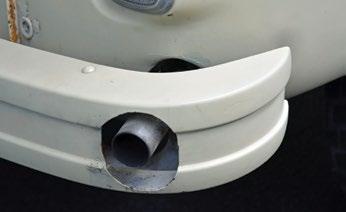

in normal driving conditions) and locking differentials. On the five prototypes, the 4x4 setup and body modifications were built to Gustav’s original plans. They did decide to upgrade to a 2.0-litre flat-four 70hp motor for a bit of extra torque. These five prototype buses were tested off-road and


VW also lent them to local police officers and select journalists to build as much feedback as they could get.
The finished product was extremely capable off the beaten track, but sadly it never received the green light for production. It’s thought that the reason we never got to see them sitting in showrooms is because the prototypes were built so late in the Bay Window’s reign. When Gustav was working on these prototypes the T3/T25 were already in prototype stages, and by 1978 VW knew full well that the Bay needed a facelift and would be discontinued after selling the same model for over a decade. Fitting the new technology to the Bay would also cost a significant amount of money. Creating the space and machinery to do so just wouldn’t be financially viable, knowing the Bay’s days were numbered.
However, Gustav’s prototype was not built in vain. Engineers developed the T3/T25 with 4-wheeldrive in mind from the
very beginning, leaving space for a driveshaft and a front differential in the underbody. Volkswagen introduced the Vanagon Syncro in 1985.
So, if you have ever driven a Syncro, now you know who to thank for all that fun you’re having.



WANTTOADVERTISEHERE?PLEASEEMAILadvertising@hayburner.co.ukFORDETAILS
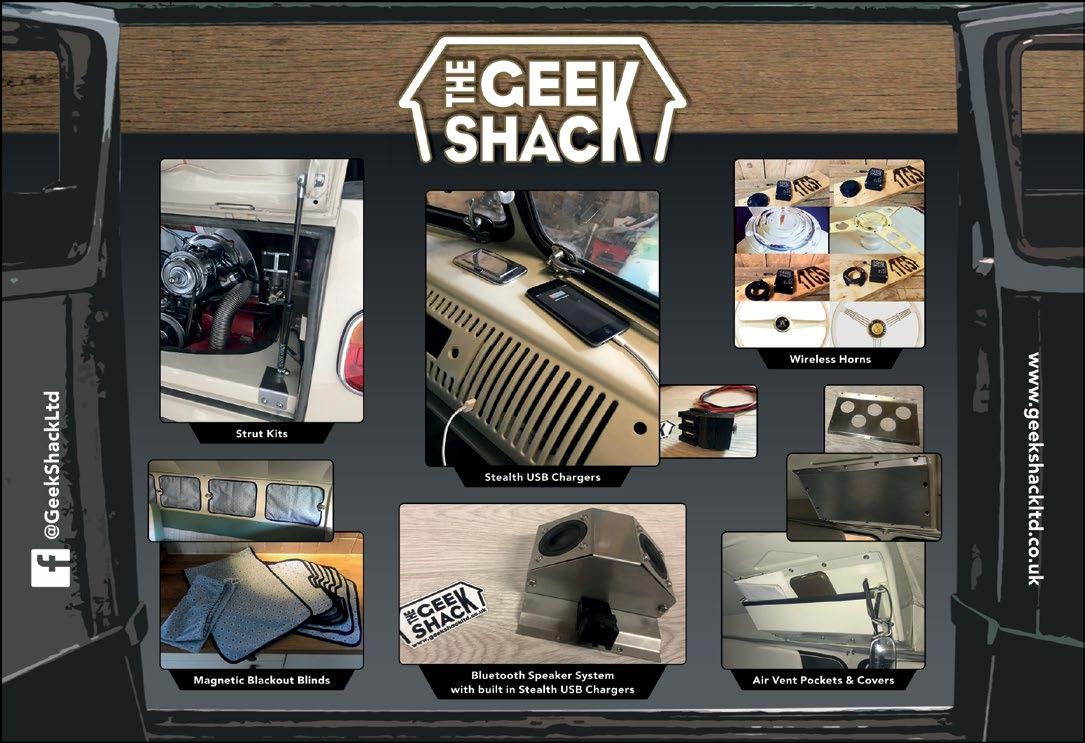




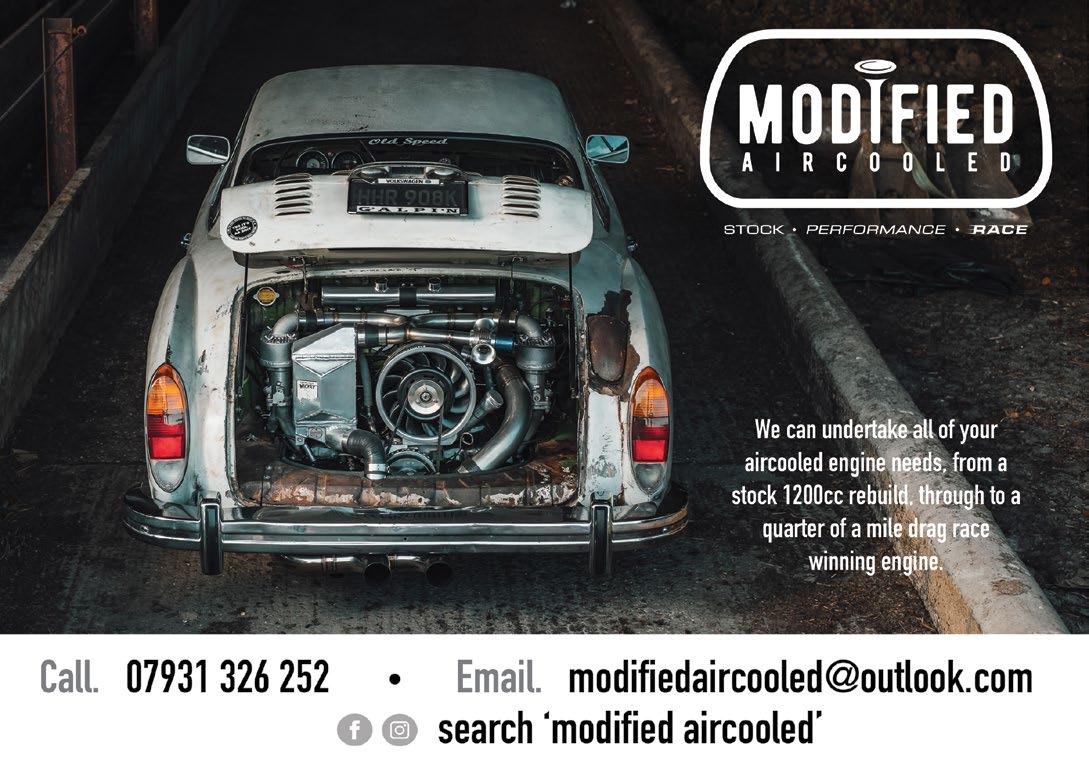
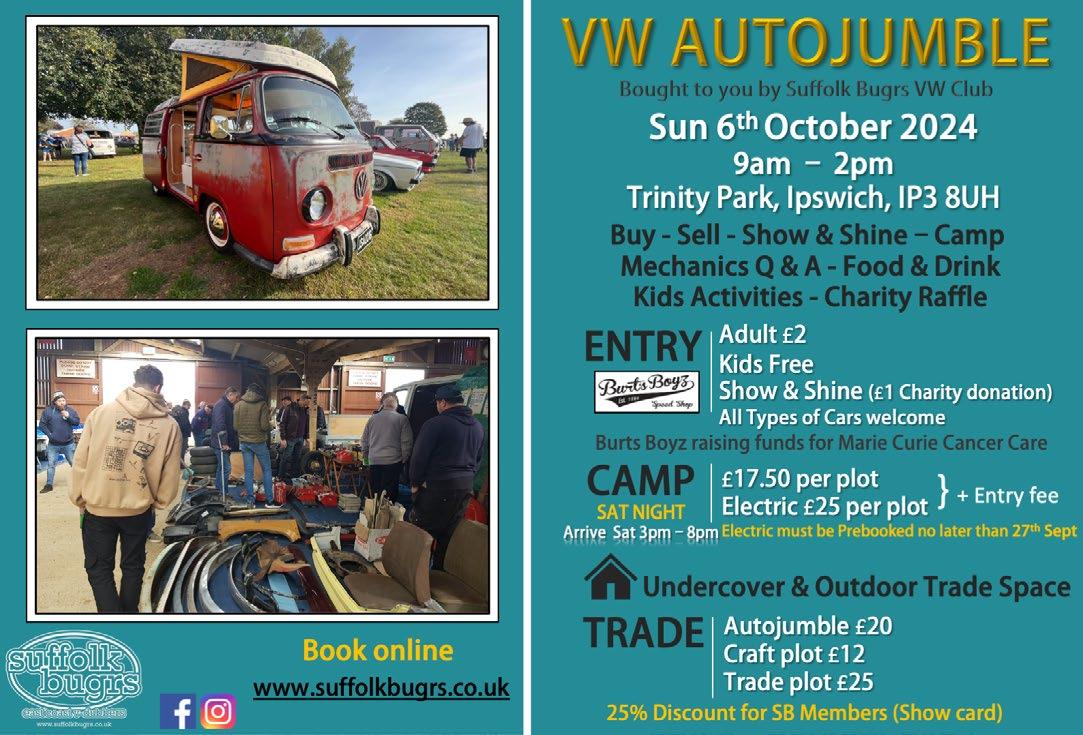
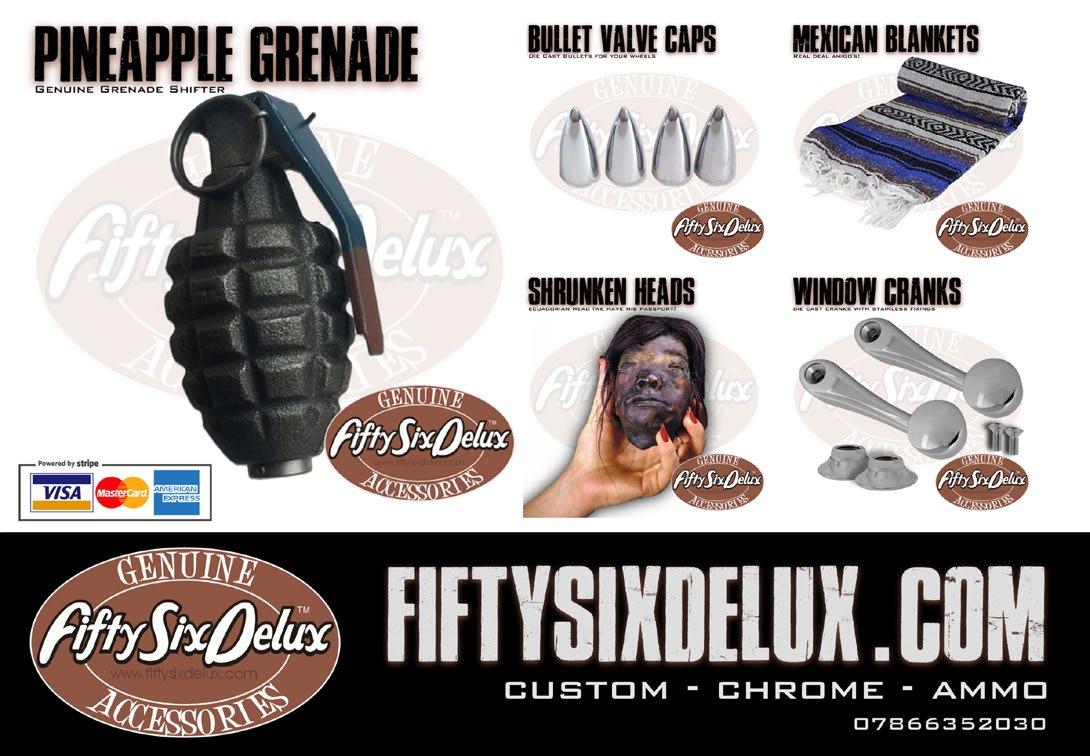
BY FASCINATING CARS & JIMMY ERICKSSON
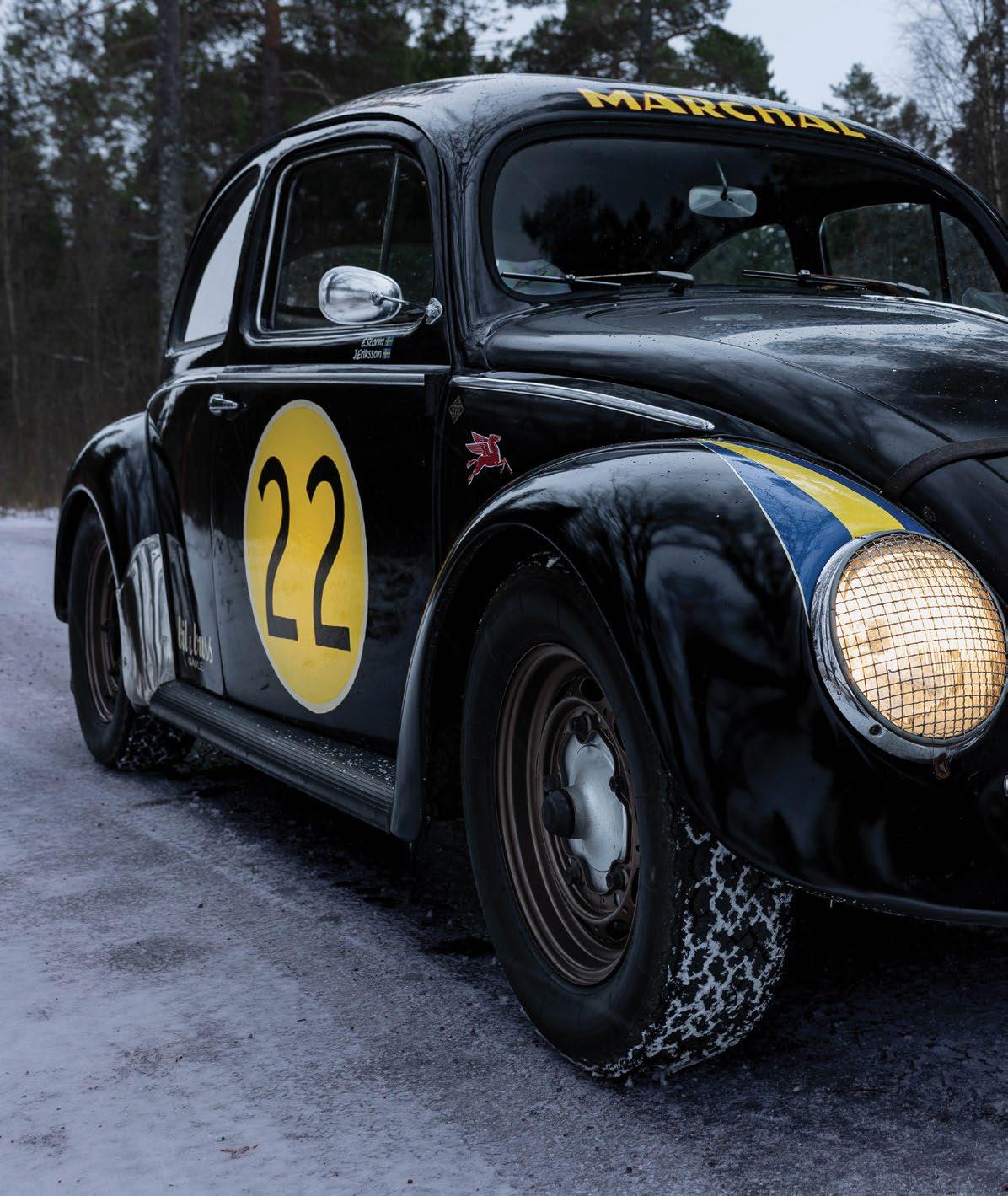
Jimmy Eriksson’s journey with this 1956 Type1 rally-inspired Beetle has been a long process and has taken many different paths. For many years Jimmy has run a large blog focused on lowered vehicles of all kinds, but mostly American cars. He was once deeply involved in the Japanese car world and started Sweden’s first Japanese car forum 23 years ago. Even
with spending so much time concentrating on his work with Japanese and American stuff, he has always kept a foot in the Volkswagen world.
“When I was little, we always went to watch rallies in the forests around Gävle.”
His own driving lessons began, however,

with adventures when he was 13–14 years old. His neighbour Claes took him out on the ice in the middle of the night to drift in his Volvo 240. After much nagging, Jimmy also got to drive and learn to drift on the ice with the 240’s classic rear-wheel drive. Naturally, Jimmy’s first ever car was a Volvo 142.
In 2017, Jimmy was at Cold Balls Rally in Östersund with his camera to document the event. At the time he had no car of his own to join in the fun. One of the participants was Marco De Waal, a wellknown face in the European Classic Volkswagen community. He had driven all the way up from the Netherlands in the extremely cold February weather in his Light Blue 1956 Ragtop Beetle with yellow auxiliary lights on the hood. This was a car that made a lasting impression on Jimmy. He had seen the same car on the internet several years earlier but had no idea who owned it at the time. “I was definitely going to build one in this style because it was just so cool, and it made me think back to my times in the rally forest.”
The goal became to build a “rally” Beetle and drive at the annual Cold Balls event in it. Jimmy’s image of Marco’s Beetle sideways in the Swedish snow later graced the front page of AirMighty Magazine.
“My aim was for the car to be usable all year round. It shouldn’t be a beauty queen and should always be drivable, regardless of weather and season. So it’s just a matter of changing tyres.”
To get where he was going with this Beetle, the journey involved two cars – one blue and one brown.
“In 2003, I bought a blue Volkswagen ’62 which became my first Beetle. I had big plans for it, but I ended up selling it a year later. However, I bought the same car back in 2015 only to sell it once again a year later. The brown (extremely low) Beetle entered the picture around 2013.”
After a few backs and forths, and an incredibly pleasant autumn drive in his friend Elin’s ’68 Beetle, he decided that enough was enough with driving a Beetle that constantly scraped the ground. Jimmy wanted to be able to use the car to explore gravelly forest roads – far more than a drastically lowered Beetle could manage. Said and done, the brown one was put up for sale in 2019, and within 24 hours it was sold to Belgium, later ending up in France where it resides to this day.
“An older gentleman arrived driving a Beetle, and in the window there was a note saying that he had a ’56 Beetle for sale. We went there the same day and looked at it
where it stood in the barn. It was completely empty inside, and someone had painted it snot green some time in the ’80s.”
The deal was made, and the car was picked up from Norrtälje on 2nd October 2019.
It took three weeks and two litres of paint remover to finally scrape the green paint off the car. Unfortunately, several places had been sanded down earlier, so the Beetle has been touched up and painted from the trim line down, while the roof still retains its original paint. Jimmy used matte paste to make the paint a bit more flat, plus a steel brush to make the newly painted part match the old. The hood is the only body part that has been replaced. Otherwise, everything is original – oh, except
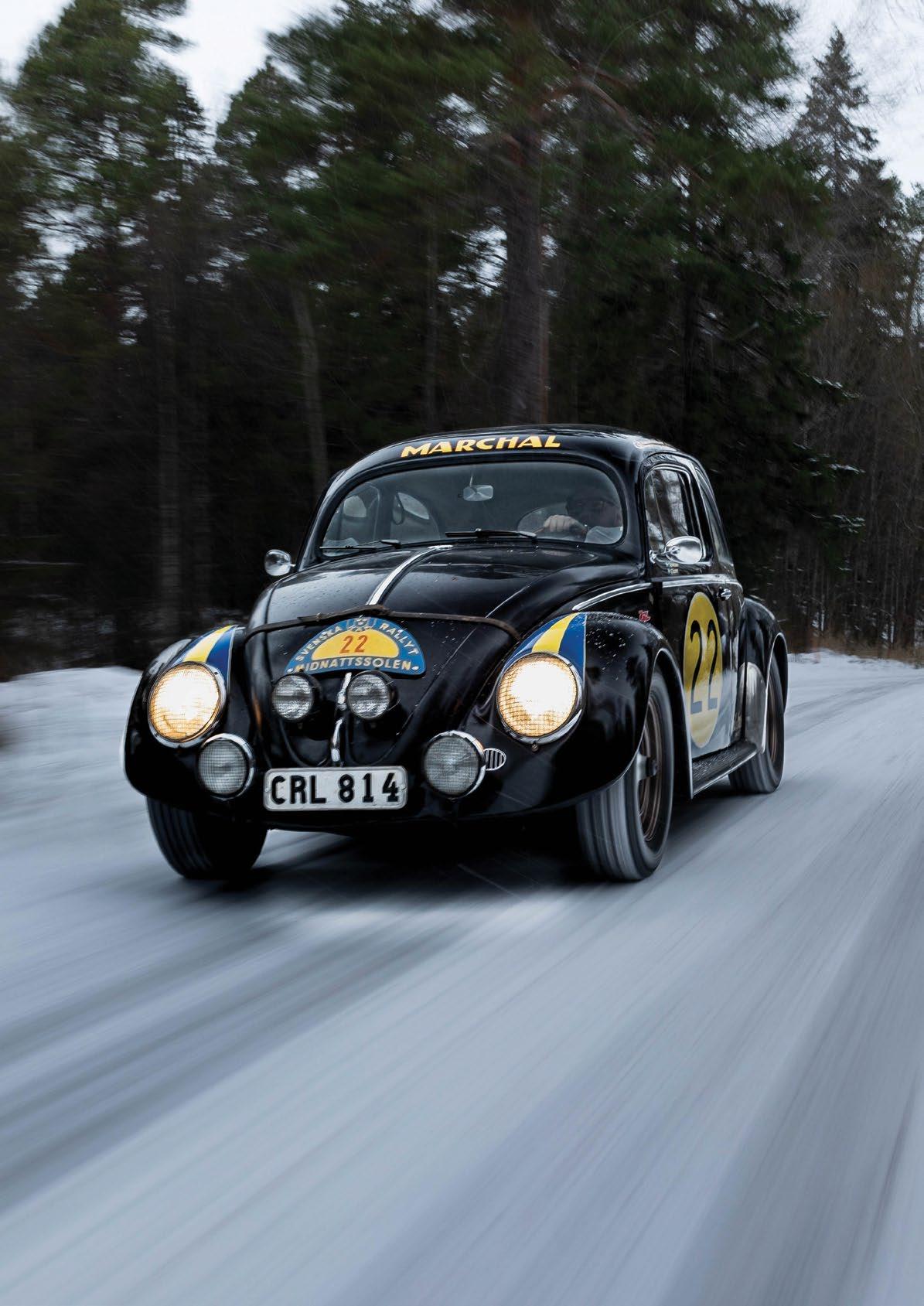
Jimmy had owned a pair of 356 original brakes earlier, but sold them in a moment of weakness. Now there are original brakes at the rear, but in the front there are brakes from a ’65 with slightly wider pads.
“The 356 brakes are still on my Christmas list to Santa, every year.”
Even the livery is well thought out. They are hand-painted, just as would have been done in 1956, by Jimmy and his good friend Harry Ojala.
Why Gevalia, one might ask? Gevalia is a coffee brand founded in 1853 in Gävle, and to close the circle, they made deliveries throughout the mid-1950s with VW buses. That’s where the idea for the painted advertisement came from. The rest of
for the punched 3.5-inch gills that friend Janne Bodin made in the engine hood.
“Actually, I’m a huge Porsche nerd, and the dream is to own a 356 coupé some day.”
Until then, Jimmy stays in the Volkswagen all the way.
However, this car does have some Porsche-inspired parts, for example, the original 4.5-inch Porsche KPZ/Lemmerz wheels – painted in what Jimmy calls Volk TE37 Bronze. The rims are slightly modified, inspired by ’50s Porsches. To keep the weight down, he drilled 30 small holes in the face.
The tyres are Michelin XWX 185/70/15, and if you look closely, you’ll see that there are original Porsche 356 stem clips on the valves – well thought out, indeed!
the signs each have their own story. Jimmy wanted to make his own Midnight Sun sign, on the front of the car, out of wood like the original, because the signs for sale on various auction sites always skyrocketed in price. After a post on Instagram about needing such a sign, an American – Mr Eric – replied that he had one lying around that he could scan and send over. Jimmy was thrilled and said yes of course, and 20 minutes later he had his template in an email. Anyone would think that’s where the story ends – but no. Just like everything else with Jimmy, there’s another layer. A month later, a person from Stockholm contacted him, saying they had an original sign lying around. It was the sign that was on Rudolph Wessel and Ingmar Falgard’s Lloyd LP 400S, when they raced in the rally in 1954.
“Rather than making my own new sign, I suddenly found myself holding an original sign with the number 22 in my hand.”


In that deal, Jimmy also got two fantastic badges – one from the Midnight Sun Rally 1956 and one from 1961. A few months later, Jimmy received a DM on Instagram from a person asking to buy the ’56 badge from him. His name was Cristian Kaiser, son of Porsche driver Gert Kaiser, who participated in the rally in 1956. Cristian was restoring his father’s blue Porsche 356 Carrera that he had driven in the rally. At first, Jimmy humbly said no, but after eight months he felt it might be more fitting for an original rally Porsche to have the badge rather than his Beetle.
The front of the Beetle is equipped with lights to illuminate the entire forest. “The leather strap over the engine hood ensures it doesn’t come off in a collision. Safety is important.” However, Jimmy hasn’t yet found a roll cage that fits well in the car. “It’s a street car, and you lose quite a bit of space with a cage, but it does increase crash safety,” says Jimmy. “The ones available are often very heavy and incredibly expensive compared to what you get, so I’m waiting on that.”



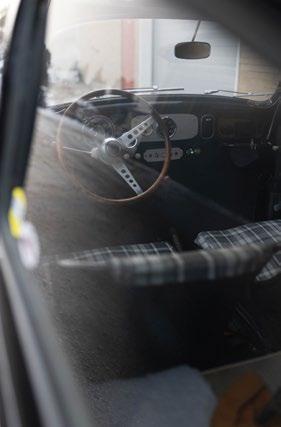
As we sit and talk in the calm and tidy VW garage, and Jimmy goes through the car bit by bit, I realise he has left nothing to chance. Everything is well thought out and figured out. “My life was the garage, until my partner came into the picture. Then the garage wasn’t as important any more. The magical thing is that we met because she also drives a Beetle, so we have that as a common interest.” Jimmy points behind us, and there stands her black stock Beetle.
“The community in the garage is incredibly important to me, and I’ve never built a car entirely by myself. It’s fun to have people involved in the builds, like my friend Anton Olsson, for example, who has helped me and been my sidekick for nearly 10 years. He likes to tinker with things I don’t.”
The car has been built to be driven year-round, and Jimmy has focused a lot on the goal of making it to Cold Balls in Östersund. “I installed a diesel heater in it so I wouldn’t have to sit shivering while drifting around in the forest and on the ice up there.”
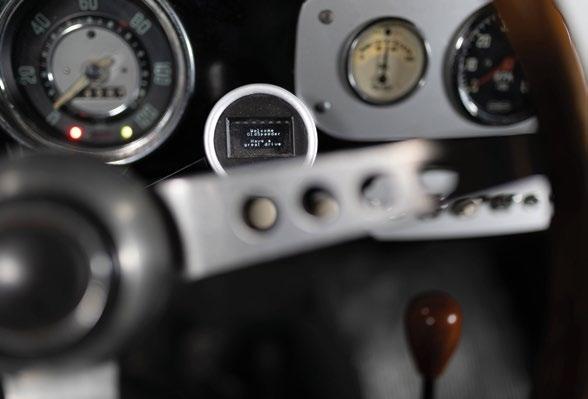
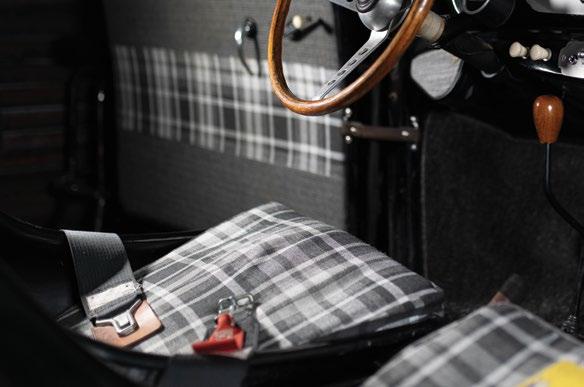
We open the front hood, and there sits a heater that, according to Jimmy, only needs a litre of diesel to warm the Beetle for two hours. Inside the car there are two vents down at the feet and two up at the windshield. During a little demo, the heater warmed the cabin to 48 degrees Celsius, so it should suffice for Cold Balls.
Inside the cabin, everything is more or less custom – Jimmy has put a great finish on the entire interior. The seats most likely come from the moulds used for Eric Lundgren’s Ockelbo Ferrari (you’ll have to Google that story). “They were ridiculously narrow for me when I got them, so I got help from my friend Magnus, who not only had the moulds but is damn good with plastic, so he widened the back part a bit.”

Among the controls and meters, Jimmy tells me about the VDO tachometer sitting in the middle of the hand-carved aluminium piece in the centre of the dashboard. He found the tachometer at a flea market in an old gas station in Östhammar, where he grew up 35–40 years ago.
“Practically all speedometers are off, which I got caught out with, so this is the best insurance against getting more speeding tickets.” The GPS comes from the Bulgarian techwizard Hayri. “When I bought it, it was the world’s smallest GPS speedometer with an OLED display.” Jimmy’s friend Magnus
With the help of his girlfriend and a sewing machine, they sewed the door cards and seats in a tartan pattern, all by themselves. “When the new seats were placed, the original gear stick was a bit off, so I bent my own, which turned out quite nice and feels much better.”
While my camera snaps pictures inside the cabin, Jimmy points with a big smile to the handbrake and proudly says he made a Ken Block handbrake. It’s meant to be easy to pull and yank, like a hydraulic handbrake, without getting stuck, and if you insert the pin, you can use it as usual. Two-point Simpson belts lie on the seats, resting, while the Michelin ice scraper nearly screams with its yellow colour in the otherwise modest interior.
made a neat 3D-printed holder for it, inspired by the old Motometer holders from the ’50s and ’60s, making it look as though it has always been there.
“If you’re an audio nerd, you must have good sound in the car.” Jimmy had his own ideas about how he would build his system, and again Magnus, who quickly understood what was needed, stepped in. Magnus went home to his 3D printer and conjured up two super nice boxes that fit perfectly with Jimmy’s Focal 165 AS3 3-way system. With vintage speaker fabric and small Telefunken signs from his brother-in-law Urban, it looks entirely original ’50s – super neat
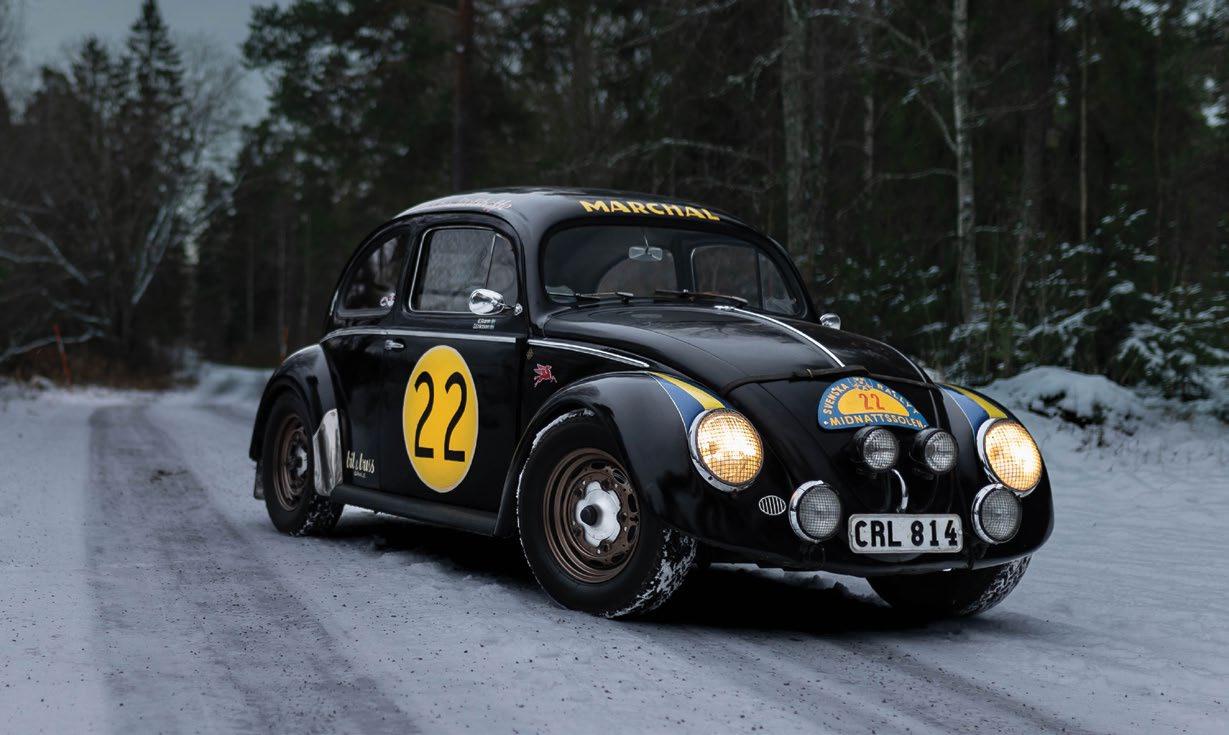
and creative at a high level. The system is controlled by a small Nakamichi NDSK4165AU sound processor, whose display is hidden away in the glove compartment next to the diesel heater’s control panel, while two 6-1/2” mid-bass speakers are hidden under each seat.
To top it all off and get that nice bass in the little Beetle, Jimmy has hidden a 6” Massive Audio XL64 woofer with a Rockford Fosgate 1000w Mono Amp behind the back seat. “I didn’t want a show-off
system, but a small, delicate system that isn’t visible. Which is difficult in a Beetle, because everything is visible! But this is how it had to be.” As Jimmy shows me around the car, I can’t help but be impressed by how neatly everything is done.
“I managed to get two original 30-horsepower industrial Volkswagen engines from a friend’s father-in-law. They are to be rebuilt by Pär Andersson in Stugun, who is a whiz at building Volkswagen engines, back to original specifications from the

1950s. Until one of them is ready, it has an original single-port 1300 engine in it. When I got the engine from my friend Peter Forsberg, it had been sitting outside for two to three weeks. Per was planning to run around with a Harley engine in his Volkswagen rod instead. During the weeks the engine was outside, the tarp had blown off, so the first thing Anton and I did was drain it of 2 litres of water.” Jimmy and Anton turned it over with fresh new oil and have since driven 600–700 kilometres without having to take it apart significantly.
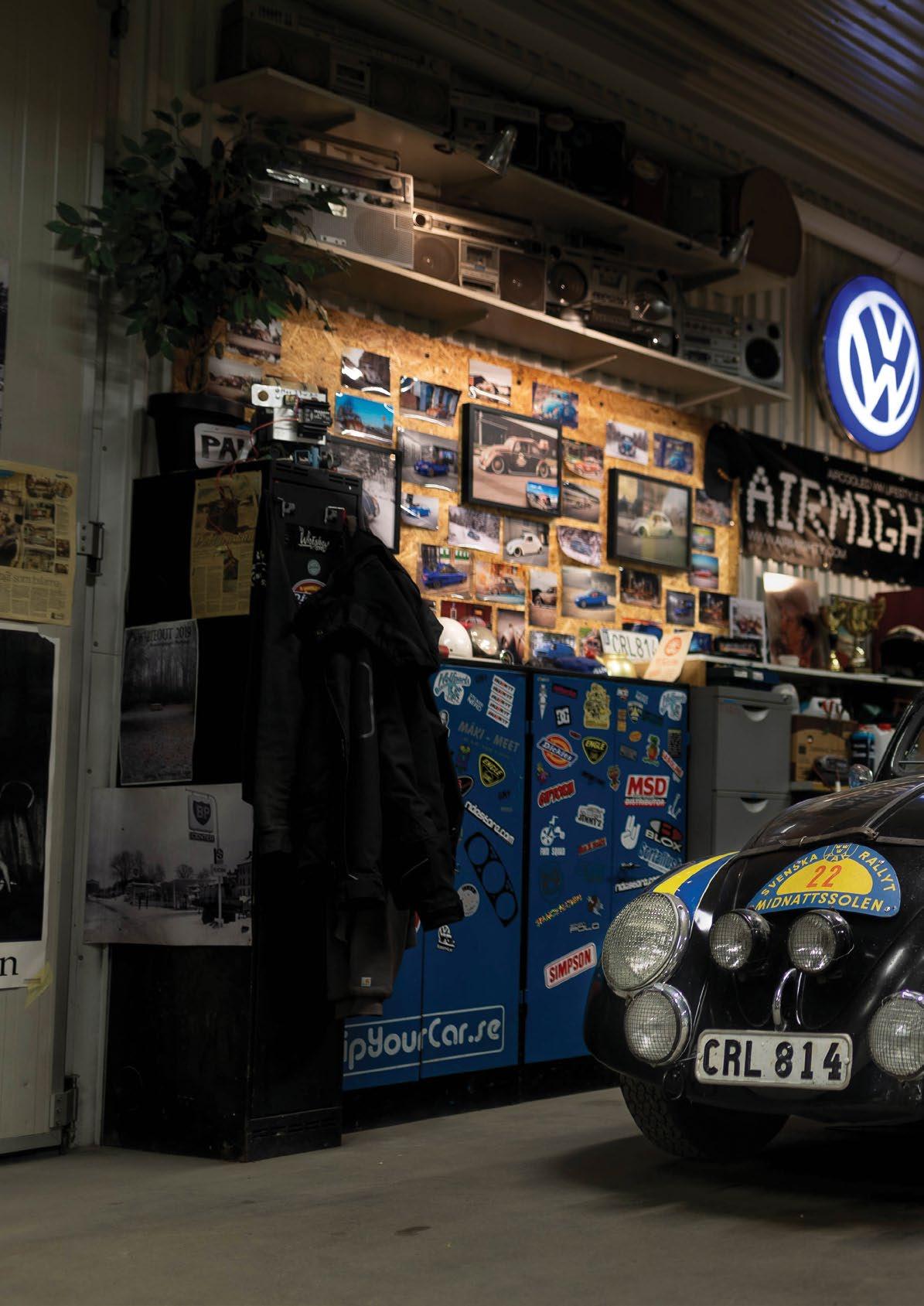
The car is somewhat lowered, with a lowering kit in the front and adjustable struts in the back. The rear wheels have 356 spacers to push them out 2cm, which still makes a big difference.
While driving, Jimmy’s smile is unmistakable. He enjoys sitting behind the wheel of his detail-crafted rally car, gearing up for Cold Balls 2024.
“I also have a goal to go down to Hessisch Oldendorf in Germany,

where a gigantic air-cooled VW meet is held every four years. Thousands of cars come there from all over the world. The whole town is closed off, and you’re only allowed to drive in if you have an air-cooled VW older than ’58, I believe. I know this Beetle would attract attention there too, just as it does from everyone we pass in a snow-covered Gävle.”



In the world of car enthusiasts, there are those who collect cars like trophies, and then there are people like Valentin, for whom every vehicle is a story to be told and an adventure to be had. At 38, this Lyonbased planning manager embodies the quintessence of VW air-cooled passion and authentic style.
Valentin’s passion for cars goes back to his rebellious teenage years, when skate-park trips with his friends were punctuated by punk rock and the frenetic customisation of their bikes: “We were looking for ways to customise our BMXs with cool parts to stand out from the crowd. It never left me!” This taste for
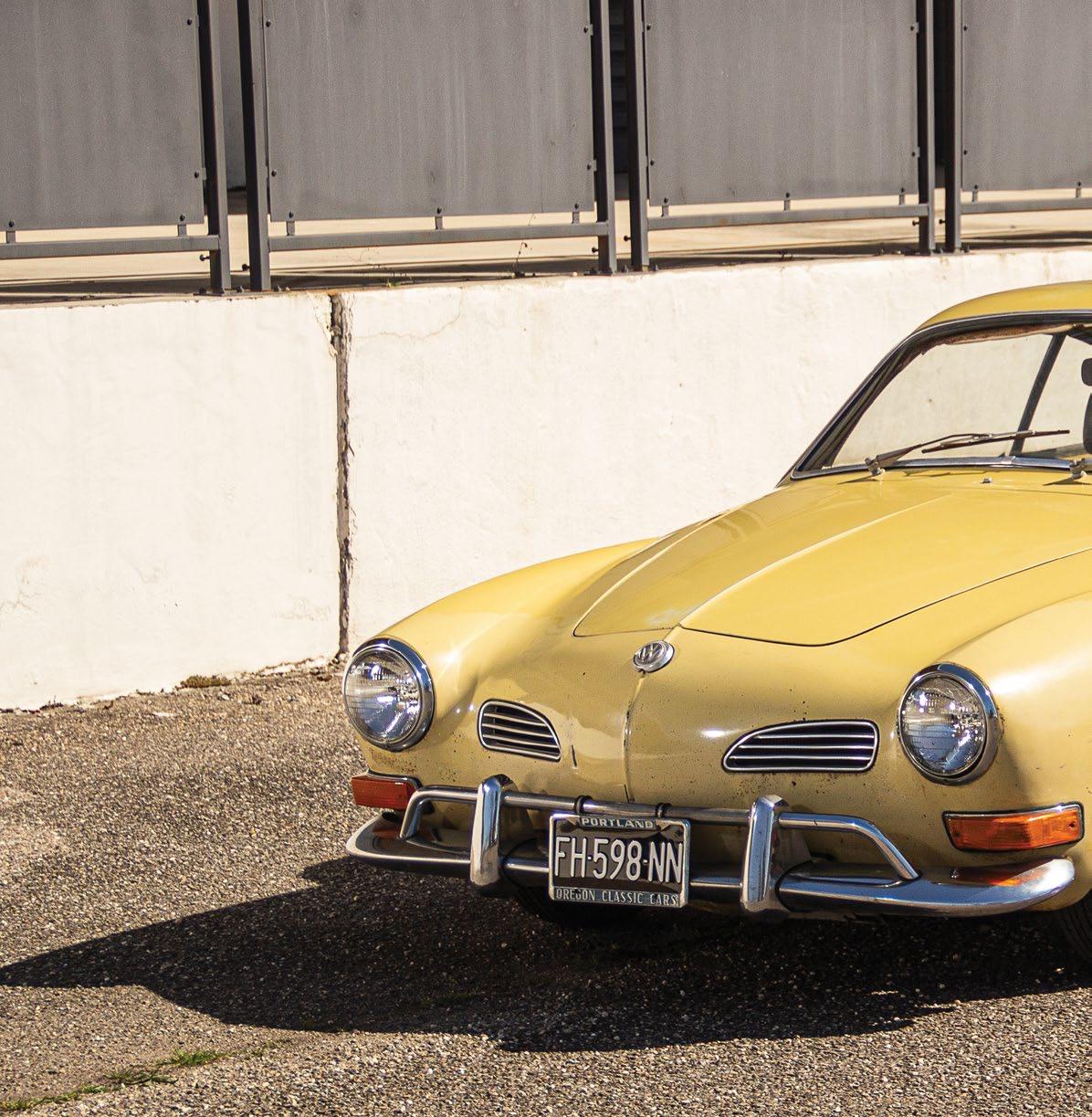
originality and individuality led him to explore mopeds, which he tinkered with and customised with the same passion. At the age of 18, Valentin’s driving license opened up a completely new world of possibilities, and he threw himself enthusiastically into the world of cars. “I already wanted to drive something different, to have a car that looked good. Aesthetically, I already loved the Bug, but at the time, it was a car that was still a bit out of my budget. So I settled on a Golf II.” It was the start of an adventure that led him to own several of the brand’s iconic models, including a magnificent 1979 Golf 1 GLI Cabriolet. Time went by and the idea of driving a Bug had still not left him, and at the age of 30 he bought his first air-cooled. “In 2015 I set out to find my first Beetle. I didn’t know much about it, so I looked for a club around Lyon to ask for advice and came across Volkzwagone Car Club. I wrote an
email and Pierrot met me at his place. He found me a super-healthy Bug just within my budget – an aged two-tone grey and burgundy ’70 with a 1600 twin port.” It was, unknowingly, the beginning of an all-consuming passion. After this first experience, he turned to a 1958 patina Beetle imported from Sweden, a true survivor car.
Valentin proudly presents us with his latest find, a 1970 Karmann Ghia Type 14, acquired after a meticulous search and a veritable treasure hunt. “Originally, I wanted a 1969 model for its little indicators, as many do, but in the end I got interested in ’70 models and fell under the spell of this vintage produced for only two years. I think it has the most beautiful rear end of all the KGs.” It was on the American website Craigslist that his



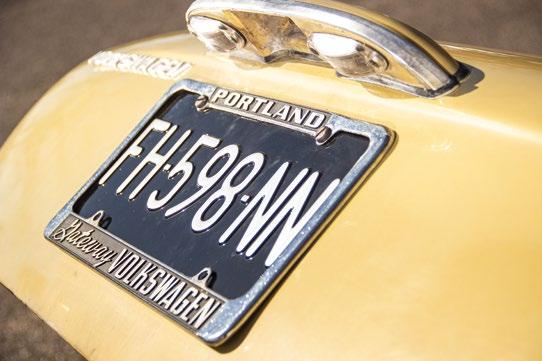
friend Nico found an ad: “Nico showed me an ad for a 1970 KG for sale in the suburbs of Los Angeles, telling me he thought it looked pretty good. And he was right! I immediately wrote an email to the owner, who replied promptly. We agreed on a price, I contacted a car importer, and three months later it was in my garage!” This rare model, steeped in the history of California where he spent his life, embodies everything Valentin looks for in a car: authenticity, style and driving pleasure. This Karmann was a first-hand car that a man had just inherited following the death of his grandfather, who had bought it new at the time. Entirely in its original condition, it had not been driven for 15 years! “The paint was completely faded by the sun, but it was super sound, with no rust, thanks to the Californian sun,” our friend explains.
This Ghia still needed a major overhaul. The tired original engine has been replaced by an almostnew industrial 1600, the braking system has been completely overhauled, and the electrical system

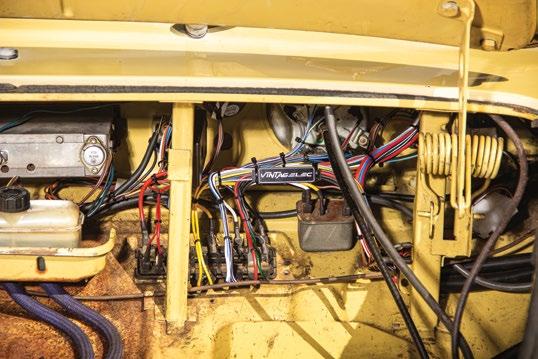
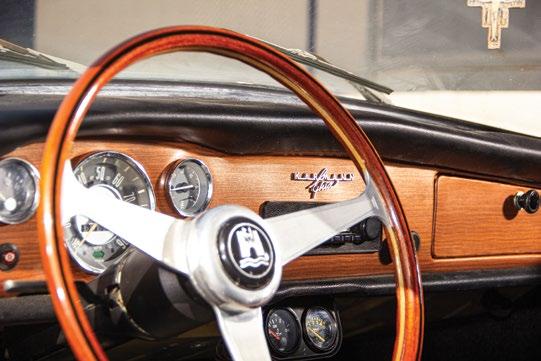
has just been completely rebuilt by Olivier from Vintagelec (France). The bodywork has simply been polished, as touching this incredible patina is out of the question. When asked what distinguishes his passion from others, Valentin mentions “English Style” as his main source of inspiration. “I think I’ve been influenced quite a bit by the patina cars from the English scene; they have a style of their own. I’m thinking in particular of Ned Faux’s ’68 KG. For him, it is a philosophy that goes beyond mere aesthetics; it is a way of life where each car is cherished for its history, character and originality. Stance, respect for origin, and the use of rare vintage parts are all values that guide his choices and shape his approach to car passion.”
Therefore, it is hardly surprising that Valentin focused on the chassis of his VW, with Volksprojects’ 10 cm narrow beam at the front and Limebug adjustable blades at the rear. In this way, the Performance Industries rims are

perfectly showcased. And when you consider how hard it was for Valentin to find this set, it was well worth the effort. On board, as you would expect, there are no frills: a brand-new dashboard, an ISP rev
counter instead of a clock, original TMI carpets and covers, and a vintage Nardi steering wheel. For Valentin, his VW is a symbol of freedom and authenticity in a world where standardisation reigns supreme.
Three questions i’m asked. Tell us about your rims. This was the set I absolutely
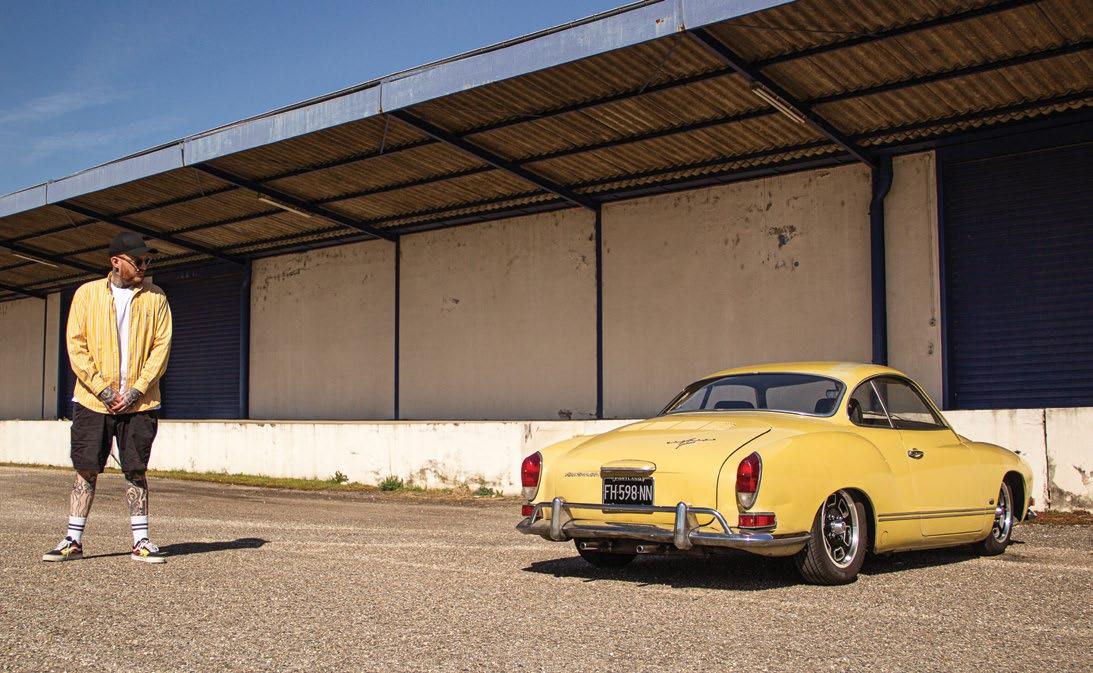
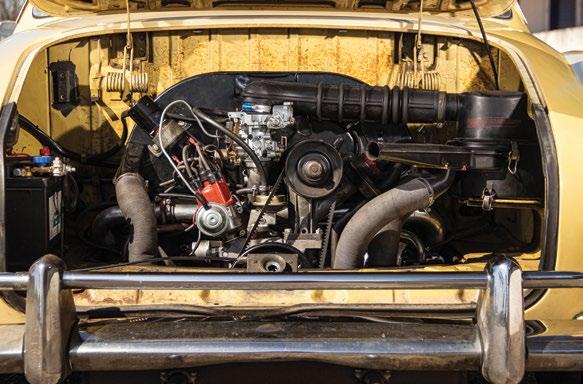
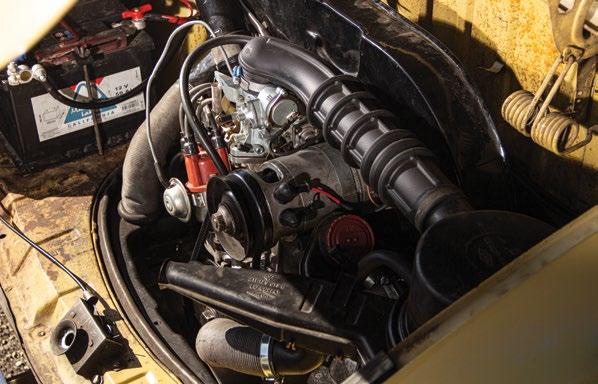
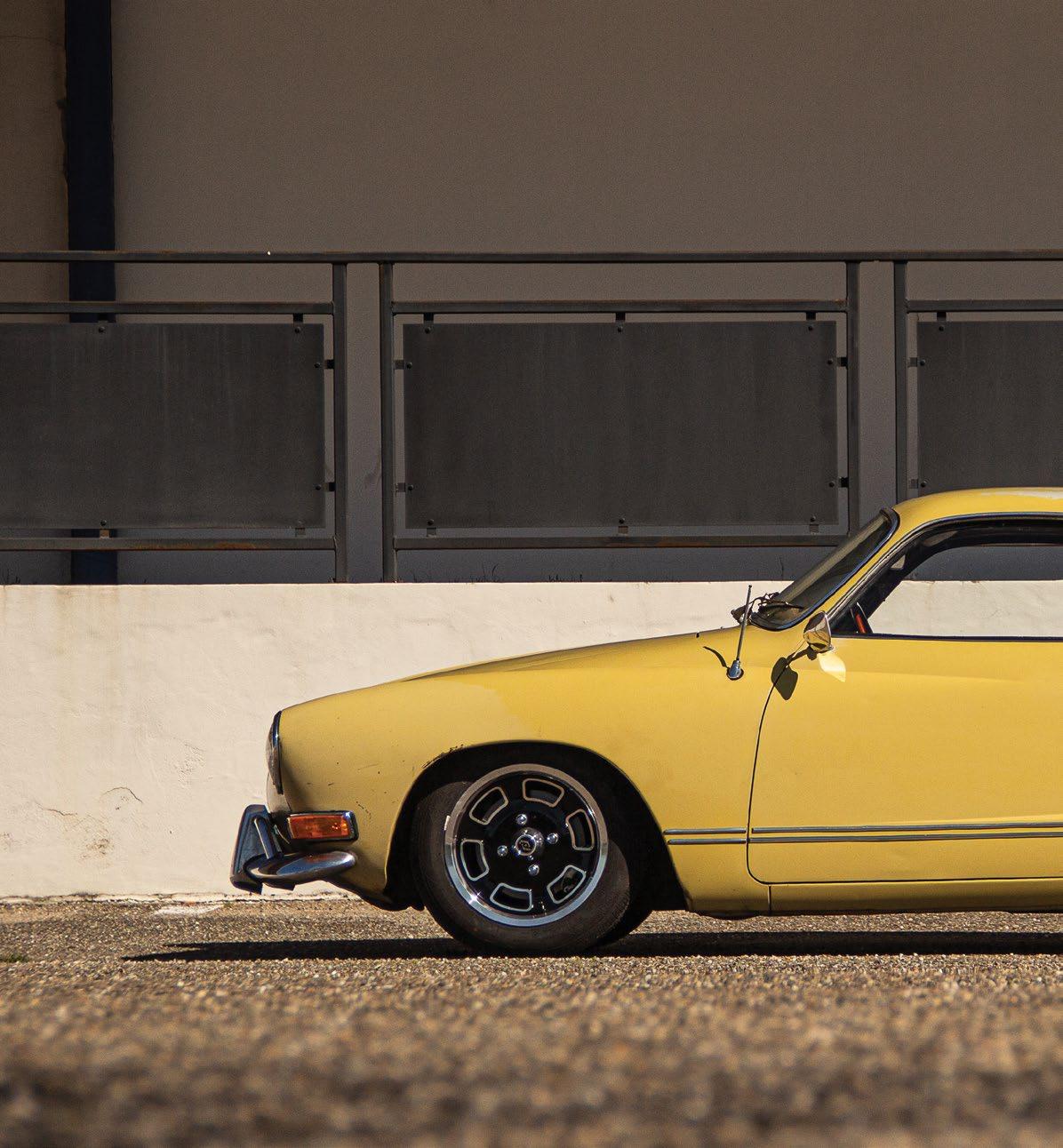
wanted. There’s very little documentation or information available on this model, which was manufactured in Oregon in small series.
After months of research I found a set of five rims in their original condition and had them imported from England. When I assembled them, I realized that there were two different ETs: I received four ET 0s and only one ET 16! The latter are the only ones that fit in the rear wings of a KG. So I
had to resell the four ET 0s and find three ET 16s, the first one in the USA on TheSamba, then the other two, six months later, on an American Facebook group! A story that lasted three years – a real nightmare!
Do you miss your ’58 Cox? Sometimes, especially as it was destroyed in an accident a few months after sale! But if I had to have another VW, it would be a Type 34: I love its sharp lines, its aggressive front end, its elegant
rear. In short I love everything about this car.
Do you do everything by yourself? I try to do it by myself, but it is better to do it with friends! My best memory with my KG is probably a “mechanical marathon weekend” like Monster Garage TV Show, with my buddies Nico, Damien and Arno.

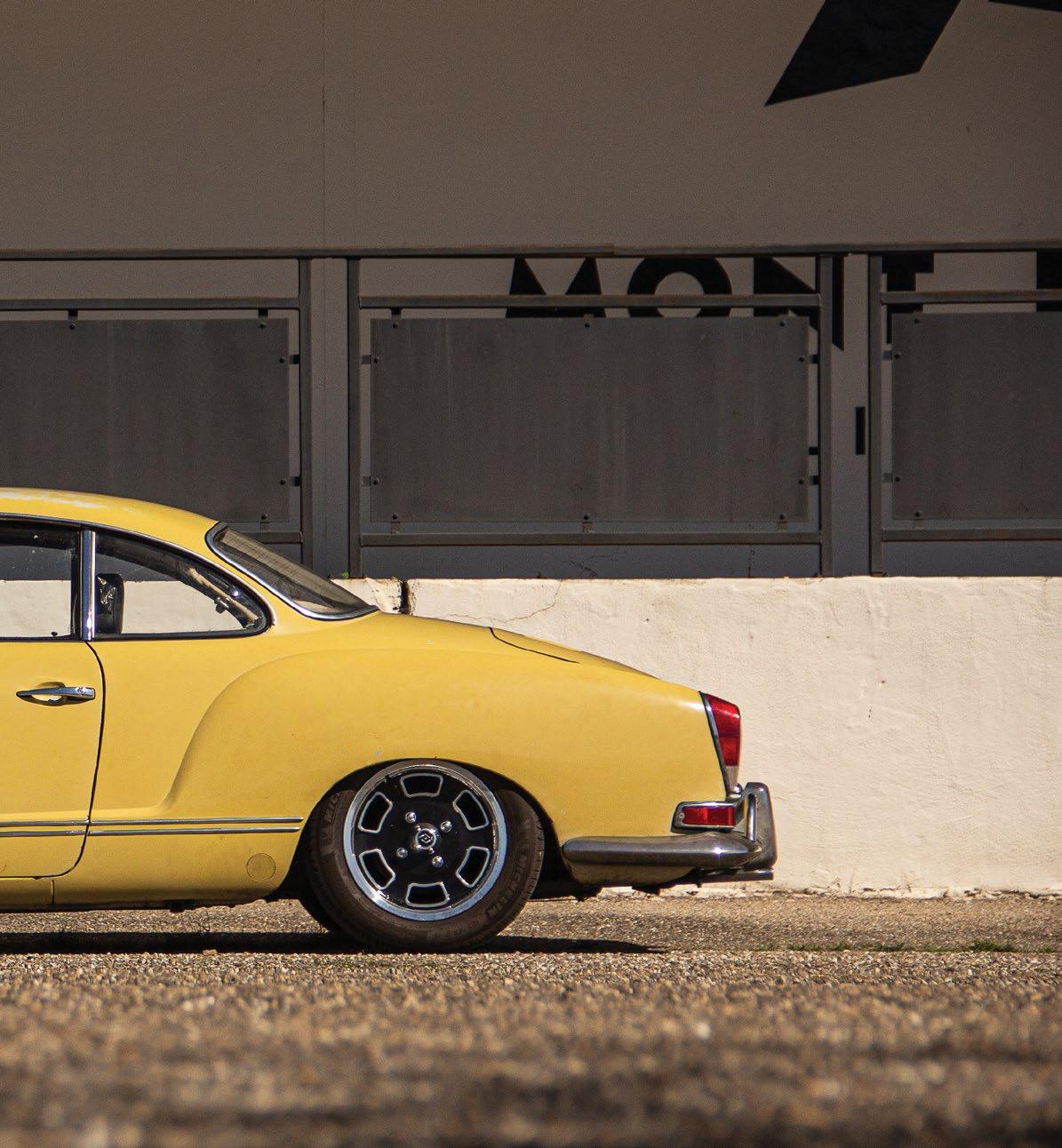
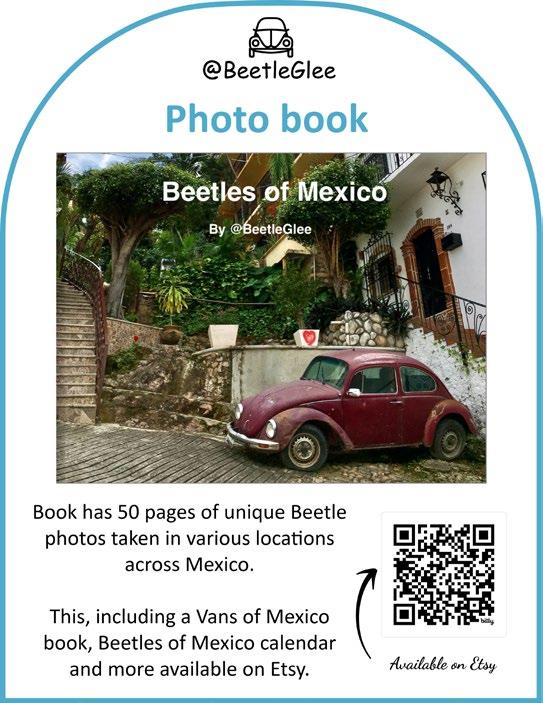

WANTTOADVERTISEHERE?PLEASEEMAILadvertising@hayburner.co.ukFORDETAILS

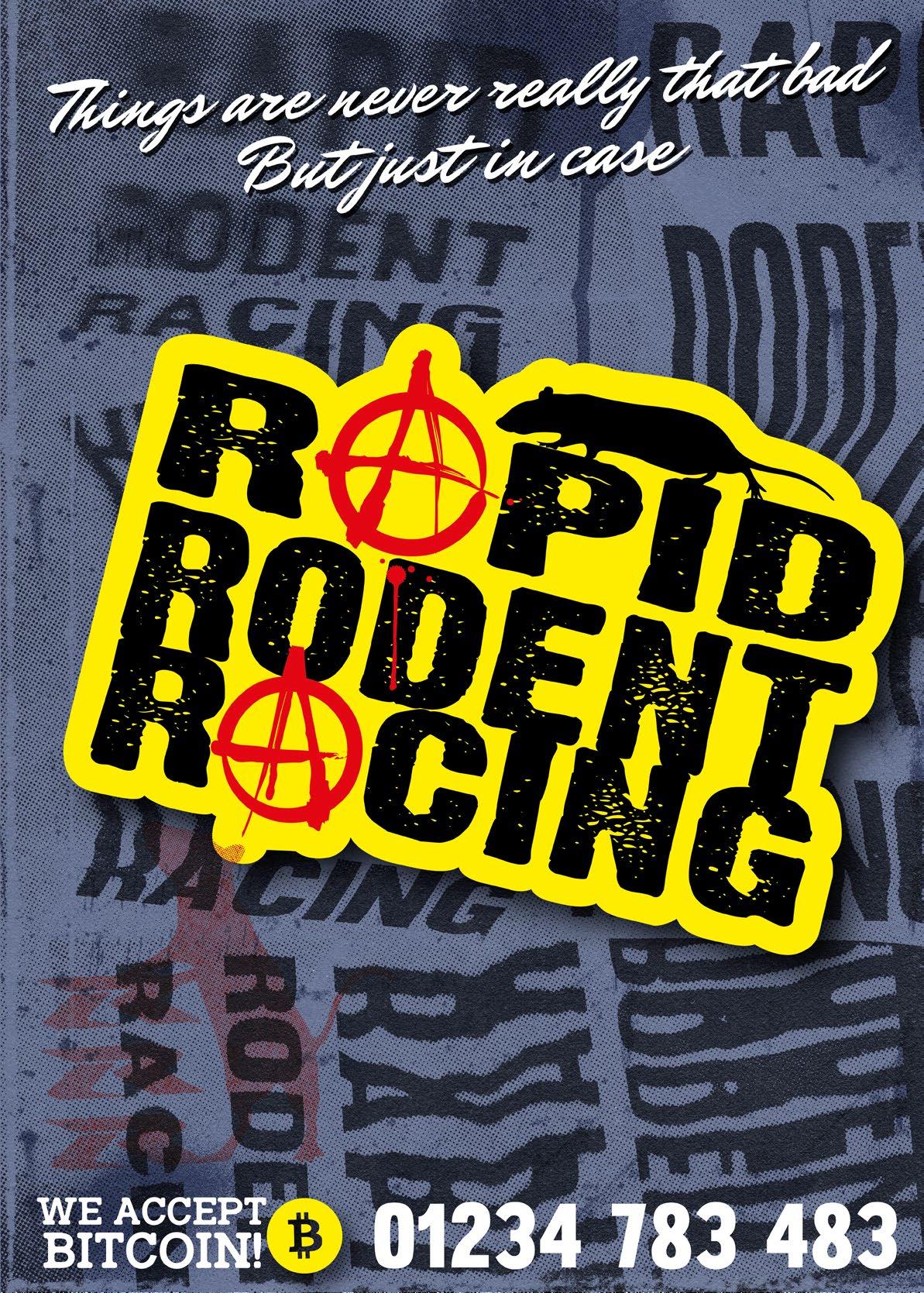


WANTTOADVERTISEHERE?PLEASEEMAILadvertising@hayburner.co.ukFORDETAILS
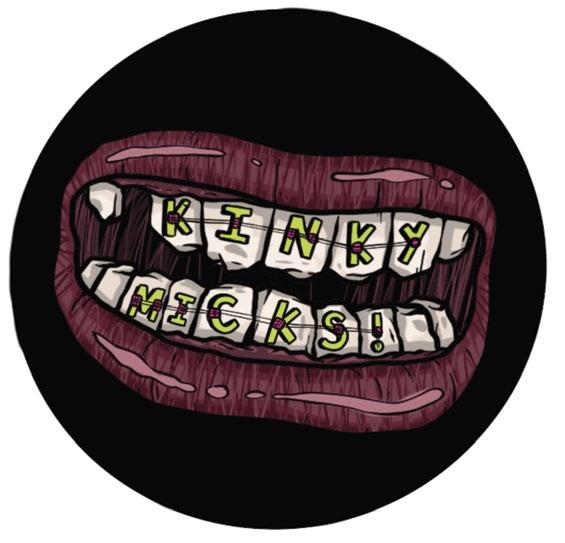

Insure your VW campervan for all of life’s adventures. Call us for a low-cost but tailored quote – customers save an average of 25% when they take out a policy with us*. Whether you’re travelling abroad or exploring the UK, we offer campervan insurance to suit your trip and budget.
Cover can include:
Personal possessions
European travel
Laid-up cover

Breakdowns at home and abroad



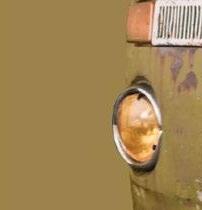
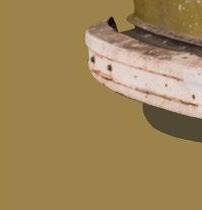

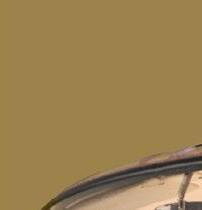

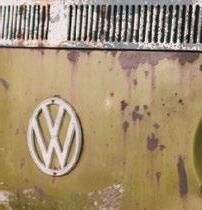
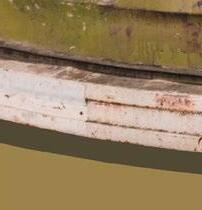
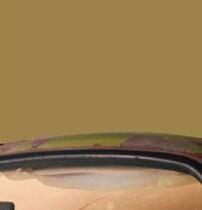
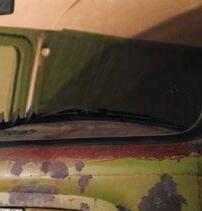

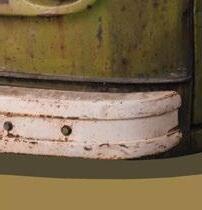
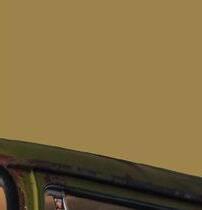
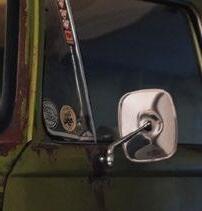
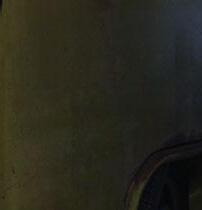
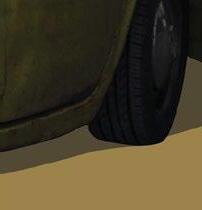



PHOTOS BY DAN DU CROS WORDS BY NEIL MABBLEY
I’m particularly fussy when it comes to our front cover cars. I try hard to choose a car that’s got exceptional qualities. It could be wild or innovative modifications, an amazing rare find, a resurrection, or a history that you just can’t make up. Well, this car has zero of these above-mentioned qualities, so why did I choose it as the cover car? Well … in my opinion this car shines above many others of its kind. The attention to detail on this restoration is about as far as it’s possible to go. Every nut and bolt has been thought about and perfectly executed. The first time I saw this car it stopped me in my tracks and I’m sure it has or will have the same effect on you if you’re lucky enough to see it in the flesh.
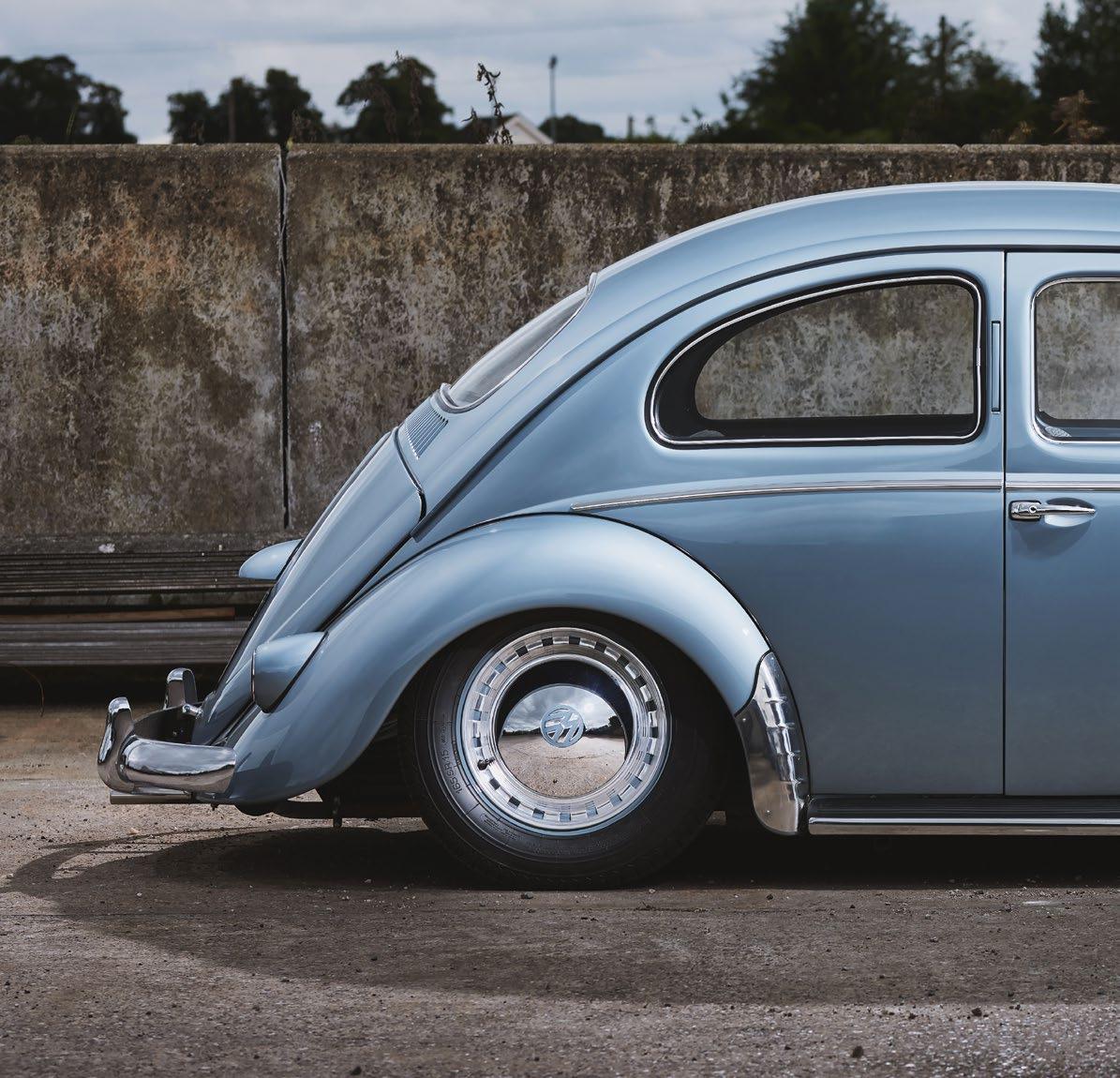
Now I know that Neil built this as an advertisement for his company, Retro Restoration, and what an advertisement it is! So if you like what you see/read and happen to be in the market for work on your pride and joy, make sure you give them a call.
Ned.
Q: Let’s start at the beginning. What’s your name, how old are you and where are you from?
A: Neil Mabbley, 41, from Hednesford, Staffordshire, but I now live in Wolverhampton.
Q: What’s your day job and do you have any other hobbies?
A: Partner at Retro Restoration with my
friend Rich Jones. I go to the gym three times a week. I ran a Sunday morning football team for about 13 years and played weekly till a couple of years ago.
Q: What’s your ultimate VW/Porsche?
A:I’dloveaPorsche356.Theyarethe bestlookingcars
Q: Favourite VW/Porsche event?
A: Probably the Volksworld show because it’s nice to see the new cars that have been built, and Stanford Hall is a nice day out with the Mrs and kids. If I’m on my own or with mates, any aircooled-only show is good. There aren’t all that many air-cooled-only shows anymore which is why me and Rich decided to start the Pre79 Aircooled show a couple of years ago after having
a few open days at our workshop. I’m going to Skeg for the first time this year with a few mates and I can’t wait. I haven’t been to any European shows and need to get myself to some.
Q: What got you into Volkswagens and how many have you owned before this one? Can you list them?
A: When I was a kid I loved “The Love Bug” and “Herbie goes to Monte Carlo”. In my early teens I used to get Volksworld magazine and I remember reading it every weekend at my dad’s working men’s club, sat with my dad, mom, sister and nan. No one else in my family had any interest in VWs. The first show I went to was Dubfreeze and I was hooked. Loved walking around the carpark seeing all aircooleds in one place.


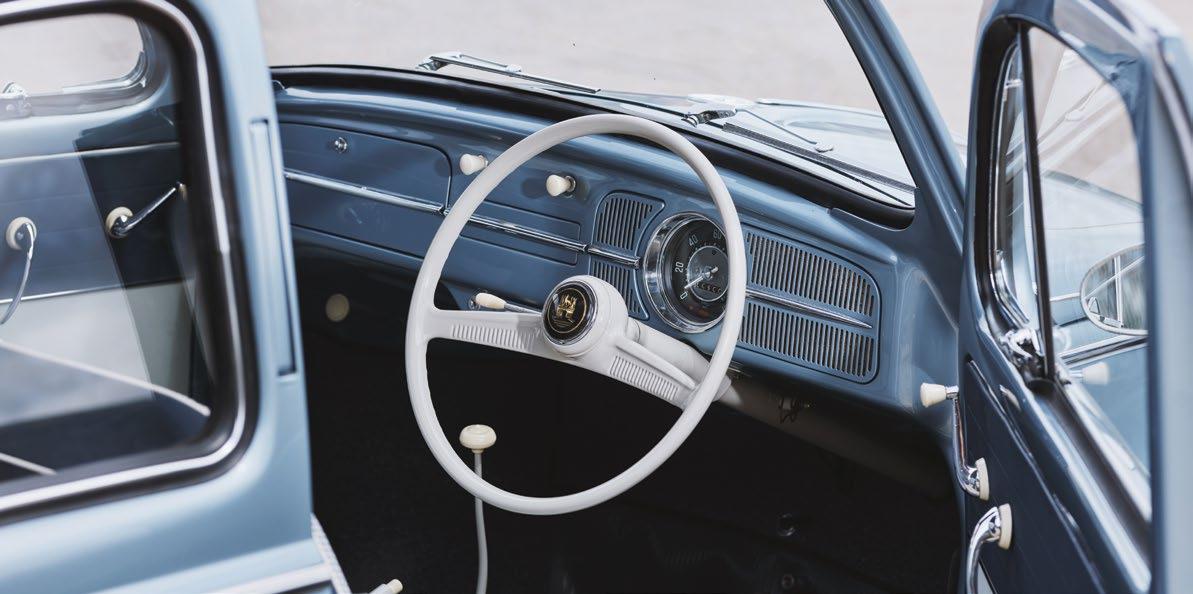
My first car was a ’68 1200 Beetle that was a bodged-up wreck. It was my daily and even though it was a shagger I loved it. It was standard when I got it. All I did was fit a lowered beam, a set of Riviera wheels and a radio. Fixing it on the drive in the snow/dark with a torch, not being able to feel my fingers, so I could get to work the next morning. Scraping the ice off the inside of the windscreen in the morning. Loved that sort of stuff back then.
When it started falling apart, I bought a part-finished project ’67 1500 Ruby Red Beetle. All the welding and paintwork had been done to a good standard by a VW specialist. My friend Deano bought it off a guy who spent a fortune on the metal and paintwork but never finished it before he moved to
America. Deano didn’t do anything with it, then sold it to me. It was a rolling shell so I just put a loom and engine in it, a set of detailed 4-stud baby burners on it, 205/70 Firestone F560 rears, 135 F560 fronts, lowered it, and that was my daily for a few years. I drove it around with a 1776 for a while, then built a 1955cc engine for it with my mate Rich Jones, who’s now my business partner. That ’67 was a really cool car.
While I was at uni I replaced the heater channels, floors and all the typical repairs they need on my ’68 on my dad’s drive while I was driving the ’67 around. I didn’t do a very nice job of it, to be honest, but I didn’t know what I was doing back then really. I just learnt as I went. I sold the ’67 to fund finishing the ’68 and bought a 1990 Scirocco GT2 for a daily, and that was

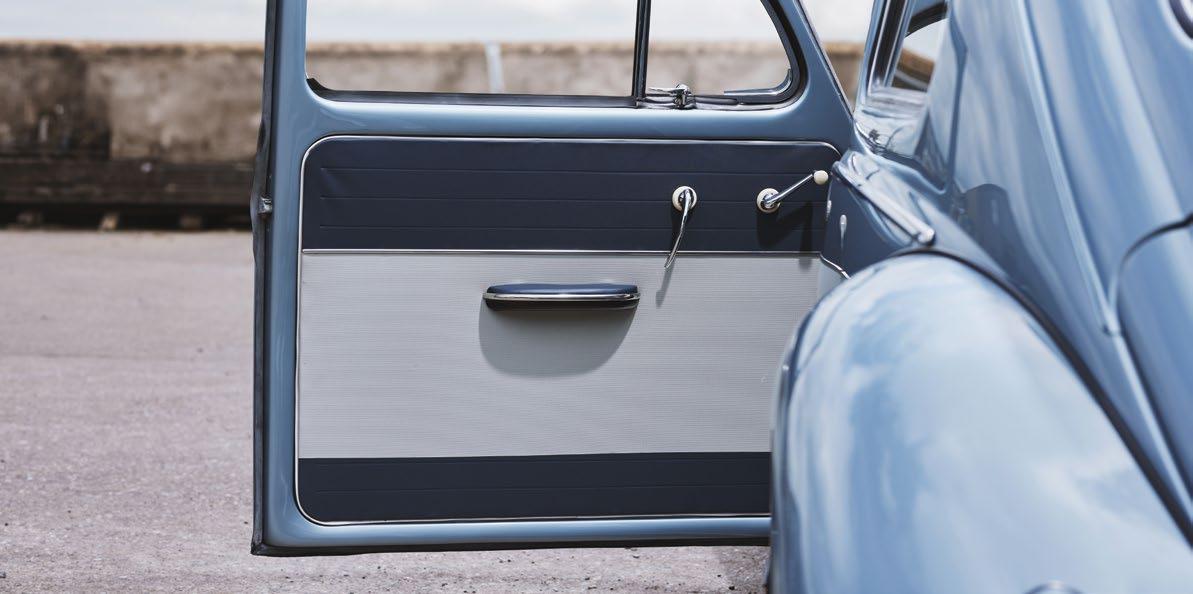
the end of daily driving air-cooled cars.
I eventually restored the ’68 twice after finishing it the first time. I’d done a crap job the first time because I didn’t know what I was doing, but a better job the second time (I fitted the 1955cc engine from the ’67 with fuel injection and turbo), but I wasn’t happy with it. At the time me and Rich had not long started the business, so we stripped it right down and restored it again properly. I built it as an old school Cal Looker. We built a 2276 IDA engine for it with some period performance parts – Magneto, DDS manifolds and linkage, Racetrim breather, Santana pulley, and I had a pair of 5” Formula Vee wheels on the back with 185/65 Michelin XWX and genuine 4.5” thin lip Rivieras on the front with 135 XZX. I ground the spokes off to
match the Formula Vees. Fat biscuit interior, twin quiet pack exhaust. It was on display at VoWo 2014. I didn’t use it much after finishing it as I didn’t really enjoy driving it with the big engine and it didn’t feel like my old ’68 anymore, so I sold it to buy something original and early.
Then I bought a really original 1955 ribbed door Oval from Owen Warlow. It was his partner’s car. He imported it from Sweden for her and it sat in his garden for years till I bought it. It’s a really original matching numbers car with OG paint and next to no welding. I still own this one. Me and Rich bought a really rough 1960 UK ragtop that we were going to restore to promote the business, but sold it because it was a massive job and we struggled to find the time to do it. There were no

channels left in it, and when we picked it up to get it on the trailer to bring it home the door gaps opened right up and the car was all over the place. It was really rough but it was complete. Would have been nice to get that finished – an early UK RHD ragtop would have been a cool car.
I bought a ’61 Mango Split bus and got part way through the restoration but I couldn’t afford to finish it and it was quite a big job. I didn’t have the time at
work to get it done, so I sold that and used the money to buy a ’69 Californian import Westy that was ready to use. We used that for holidays with the kids for a year, then sold it to buy my sister’s ’70 Westy that was mostly OG paint and never welded. It was such a cool bus but we didn’t use it so I sold that as I wanted another project to use to promote the business.
I wanted another Oval but I struggled to find a nice project so I eventually bought
the ’58 from Graham at FBI. It was solid but had been stripped down. I’ll never buy another stripped down car after this one. I geeked out on all the proper ’58-only details and it was a nightmare finding all the right parts. It cost me a fortune.
Q: Who, or what, would you say is your biggest influence in the worldwide VW community?
A: Probably the standard of cars at the Volksworld show. I have always wanted

a car good enough to compete with the best cars out there.
Q: Best moment during classic VW/ Porsche ownership?
A: Driving my ’68 as my daily was by far the best part of VW ownership for me. At the time it was a nail but I drove it everywhere. I used to love driving that car. I put loads of miles on it with a 1300 single port with about a foot of end float. I made loads of memories in it, loads of stories. I loved that car before
I restored it but it never felt the same afterwards. I drove it to loads of shows – RTTS, all the shows at Santa Pod every year – and to Wales (Bangor Uni) quite a bit to see my girlfriend at the time. My accelerator cable broke by the pedals on the way home from seeing her. I bodged it up on the side of the road, sitting in a soaking wet footwell, using the wiring from my radio and a chocolate block connector. It only lasted a mile or so at a time, but I eventually got it back to her student halls. My mom and dad
picked my sister up from school, then drove to Kingfisher Kustoms to get me an accelerator cable and then drove to Wales. Me and dad fitted the cable in the car park in the pitch black and rain. Looking back, those days were the best – no worries or responsibilities. All that was part of the fun of VW ownership for me. Couldn’t do it now though.
Q: Worst moment during classic VW/ Porsche ownership?
A: I put a deposit on a ’56 Oval after
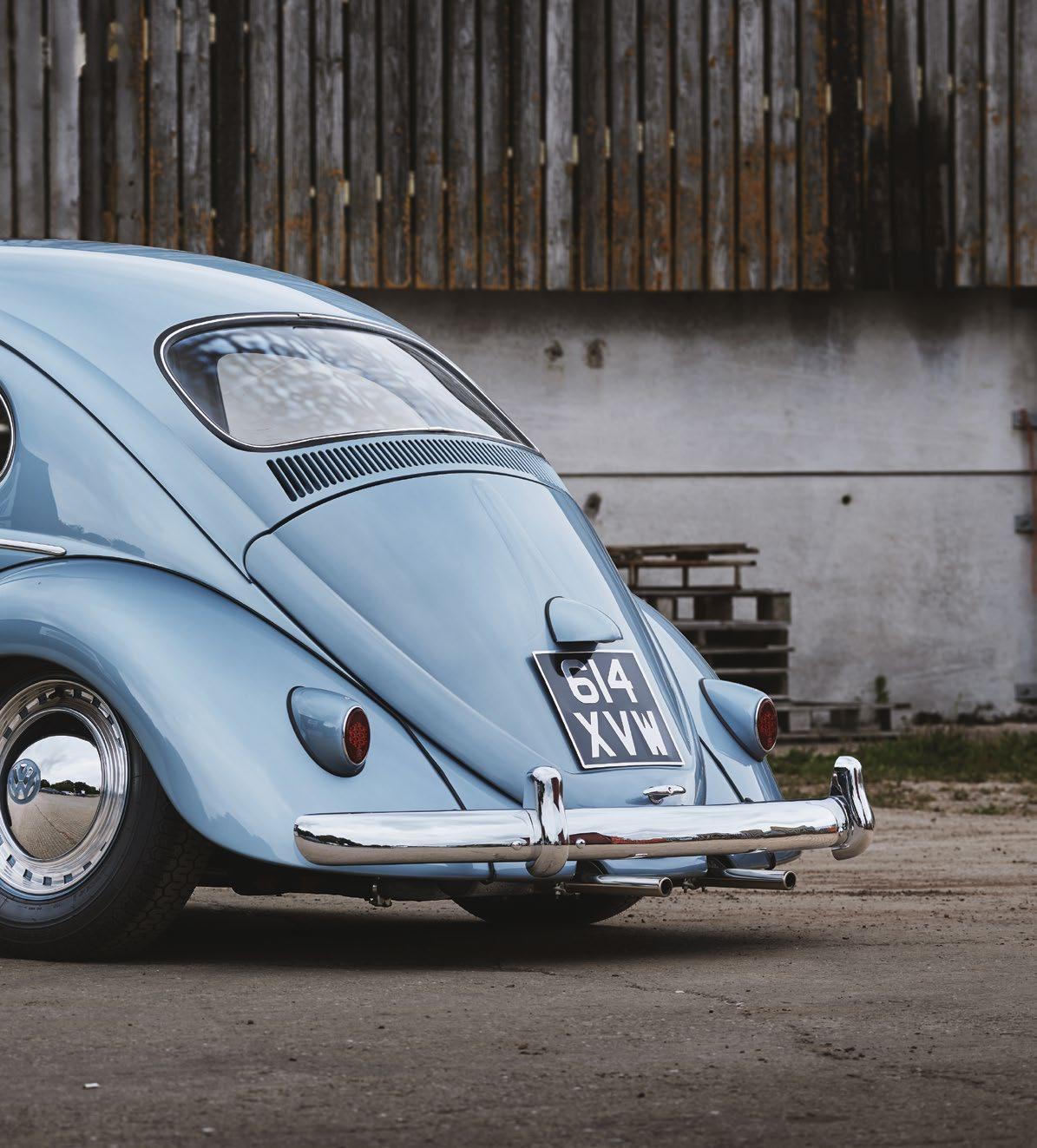

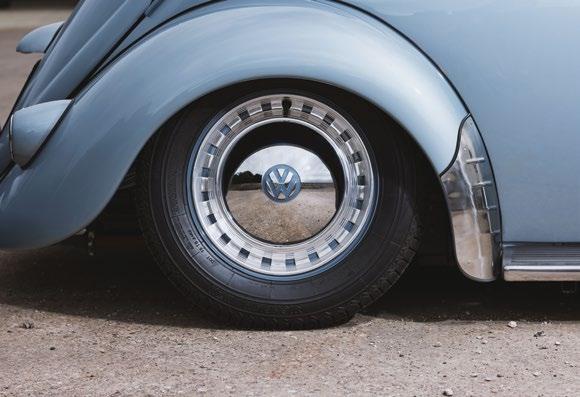
selling my ’68. A week or so later the guy changed his mind and I was gutted. It was a lovely original low mile, never welded Swedish car, but I can understand why he changed his mind.
Q: So, what is it we’re looking at here (year, spec and model)?
A: ’57-built ’58 model Beetle. Swedish RHD in Glacier Blue L334.
100% stock other than the suspension. I spent AGES sourcing NOS parts and making sure everything was right for the year, down to the coil being date correct, all the original date correct hardware, etc.
Q: What’s the story? How did you get hold of it?
A: I bought it from FBI VW as a project. Graham had some amazing cars there. … He had a complete, really solid original Strato ’55 Oval that I wanted but it was just out of budget. Another car he had that I was considering was a Beryl Green ’61. It was the same price as the ’58 and it was a really cool car. It was all OG paint and a colour concept model too but was probably too nice and original to restore, and I wanted a semaphore car so went for the ’58.
Q: Did the car come with any history?
A: No. I found the previous Swedish owner from the log book, but didn’t get any details from them.
Q: Tell us about the condition of the car when you first got it home.
A: Fairly solid. All panels original to the car. Partially stripped. Body hadn’t been off the chassis but the body was stripped down. Inside OG paint; outside had been painted.
Q: Run us through the restoration/recommission. Who did the work?
A: We did all the work at Retro Restoration, Staffordshire. It
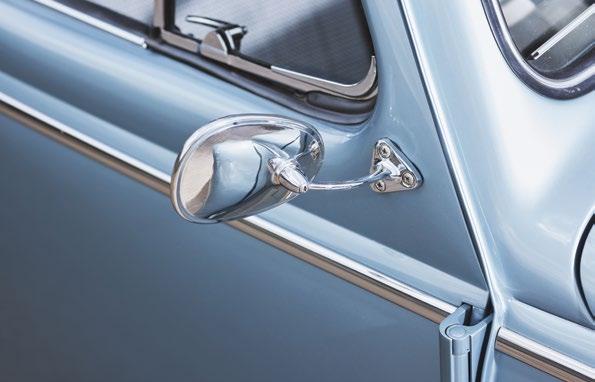
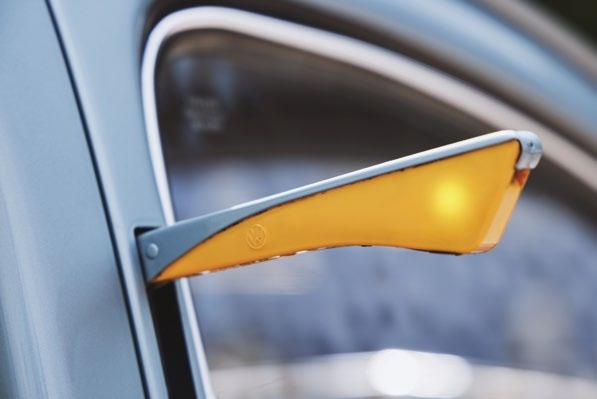
was media blasted and epoxy primed before doing any metalwork. I wanted to keep all the original panels to the car.
All four wings needed repairs; the rears were pretty rough. I made sure I replicated all the details like the ribs on the rear wing mounting face, drainage holes in the wings in the right place, etc.
Heater channels were solid overall but needed repairs. I made the running board mounting panels and replicated all the factory pressings and fitted new channel bottom plates, replicating all the OG spot welds.
Lower front quarters repaired. I spot welded them to the channels as factory. Front end was solid but the front valance and spare wheel well needed quite a bit of hammer and dolly work to straighten out. Repaired the OG rear valance. I cut up an Autocraft valance and welded it below the H section as the pressings on the OG valance are loads nicer, so I saved those. Repaired the original rear bumper hangers and replaced the engine side trays.
The lower rear quarters needed small repairs on the lower section and some hammer and dolly work to straighten out a dent, but overall the quarters were really nice. The floor pans are original but had quite a few holes drilled in them that were welded up. A couple of sections were repaired. When doing the repairs on the car I wanted it to be exactly as it would have been from the factory, with all the proper pressings and details with no visible repairs.
Q: Paint colour (and code if you know it)?
A: Glacier Blue metallic L334, one year only.
Q: Suspension set-up?
A: 4” beam, dropped spindles, and 2” dropped adjustable spring plates from Max at EVA Resto. All powder coated semi-gloss black

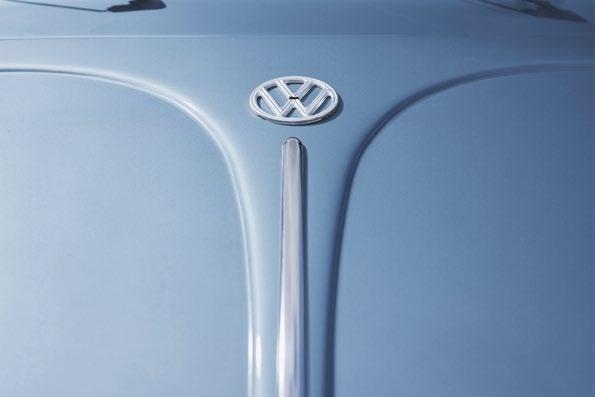
and brakes are all detailed stock. Lowered shocks painted red in the rear as they were from the factory.
Q: Wheel and tyre type and sizes?
A: I had the original wheels powder coated semi-gloss black and painted the outsides in the original L30 Grey Blue and L82 Silver White inners, as factory. The hub caps are genuine VW rechromed. I painted the VW the same blue as the wheels like they were on earlier cars. On a ’58 they should be black.
The trims are period trims which were available in the ’58 VW accessory brochure. The inserts were red but I painted them blue to match the wheels and logo. I have another set of trims, some GHE Happich vented turbo trims, to restore for when I fancy a change.
Tyres are Michelin 135 ZX fronts and 165 XZX rears. I’ve got a thing for matching period tyres. I have a set of 205/70 F560 and 135 F560 Firestones because I wouldn’t mind a bigger tyre on the back. I was going to have a pair of stock wheels widened on the inside so the wheels look stock from the outside and the trims still fit properly and fit those on the rear with the 205 F560s and fit the 135 F56t0 fronts … but I might not bother. I bought some American Eagle 5-spokes but I’m not happy with how they sit in the front arches with the offset. I’m considering fitting a set of detailed Fuchs with the typical 4.5 fronts and deep 6 rears and Firestones. We have detailed loads of sets now and have templates to mask them up exactly how they were from Porsche, so I’m tempted to do that.
Q: Engine and gearbox?
A: Rebuilt 30hp engine with all the correct ’58 parts. I spent ages finding parts like the proper coil with TE6B1 stamped on the top and NOS muffler. All the OG hardware has been re-plated, tinware painted semi-gloss black. I had the carb body and fuel pump vapour blasted and then rebuilt those. We rebuilt the distributor


and re-blacked the body. Re-plated the proper coil clamp.
I have the engine that came with the car in bits. I was planning on rebuilding it with the Wolfsburg West oversize B&P (and possibly WW stroker crank), and either fit Judson or Speedwell Sprint kit and a Sebring exhaust, but I’m not sure I’ll bother now. It runs really nice as it is.
The OG split case gearbox was rebuilt by John Walklett and we fitted all the re-plated OG hardware to it with powder-coated axle tubes, and rebuilt and detailed the OG starter motor.
Q: Have you replaced the electrical system?
A: We fitted a new loom from Volksgoods. It was a nice loom but we tidied it up. The ignition switch and headlight switch were NOS; all the other switches and fuse box, etc. are originals cleaned up. The speedo was restored by Thorsten at Krautclassicparts in Germany.
Q: Were there any parts that you found it hard to get hold of?
A: I bought quite a few parts from Seb at German Junkies. He had the proper Euro headlights for it, a NOS 4 tab badge and quite a few other bits and bobs like switches. Jonny Abbot at Java VW sorted me out with quite a few smaller parts and a pair of the correct link pin pinch bolts with the earlier markings on them. Two of mine had been replaced with generic bolts and I spent ages trying to find the proper ones.
The ’58 wipers are one year only with a fixed blade and arm with separate base, the same as Oval models but with slightly bigger blades for the bigger windscreen. I found a NOS pair in the VW packaging. Surprisingly the rubbers are not rock hard and they work well.
I bought a NOS SG code ’58–’59 ignition switch, then changed the tumblers in the door and deck-lid handle so they all work
on one key. NOS muffler.
Q: Run us through the original interior?
A: I stripped the OG seat covers from the car which were in really nice condition, powder-coated the seat frames and springs, then painted the frames Stone Beige. A friend of mine (Rob Evans) dropped them all off with Sam Trigg on the way to his holiday and picked them up and bought them back on his way home – legend. I asked Sam to replicate them as close to the factory as possible.
Ed Aldridge fitted my carpet kit and headliner. The carpet is Anthracite in the front and Silver Grey in the rear as
they were from the factory, with the Anthracite cord binding and ’58/early ’59 aluminium heater rings. There are a couple of bits that I’d like to redo at some point, but Ed was rushing to get the car finished at my workshop two days before the Volksworld show. He also fitted the headliner as close to factory as possible.
I restored all the original switch knobs and handles, etc. I fitted a NOS ’58-only handbrake gaiter (same as earlier cars but grey) and a repro grey gearstick gaiter.
The only RHD rubber floor mats I could find were not good enough for a show
car and you can’t get repro ones. I sold the OG mats to someone with a patina ’58 and used them as templates to have a set of coco mats made in black and blue in America that my friend brought back for me. WW centre tunnel mat.
I have bought a pair of NOS 1958-dated 2-point “Vattenfall” shoulder belts that were fitted in loads of Swedish VWs by the dealers. I’m planning on having them re-webbed at some point to be 3-point belts and fitting those. The door cards are original to the car. I restored them because the white material is unavailable reproduction and the repro door cars have stitched seams in the top section instead of welded seams like factory.

I had some vinyl paint mixed to match the seat material and repainted the door cards, then fitted new beading. I made a good set of ’58–’59 sun visors from the OG RHD mirror and good used LHD visors and arms.
Q: Accessories?
A: Only the wheel trims and door mirror. The mirror was fitted to the car when I got it. I believe it’s from a Saab 95. I liked it and apparently it was quite common for people in Sweden to fit them to their VWs, so I had the base rechromed and replaced the glass.
I have a hooded reverse/fog light that I’ve had re-chromed that I need to fit.
I was planning on fitting more original accessories but haven’t found anything else worth buying yet.
Q: Have you got a stereo fitted and, if so, what are you currently listening to (either in the car or during those late nights in the workshop/garage)?
A: I’m planning on getting an original radio, fitting a Bluetooth amp and fitting some speakers behind the back seat, but for now I just have a Bluetooth speaker to take with me if I’m on a long journey.
I need some new music. I have worn my collection out – Incubus, Chilli Peppers, Modest Mouse, Offspring, Greenday, Foo
Fighters are still my go-to.
Q: What’s your favourite thing about the car (e.g. wheels, paint, detail, trip it’s been on, memory with it, etc.)?
A: One of the reasons I bought the car was the colour. I don’t think I’ve seen another Glacier Blue car in person. But I’d say my favourite thing is that all the details are right: pretty much every last nut, bolt, washer and screw is the original or replaced with what it would have had when new and plated in the correct colour. I’m quite sad, but I like to look at an engine and see the proper Kamax/Dorn/Knipping bolts in the engine case and tinware. The gearbox is the same. Things like the starter motor,
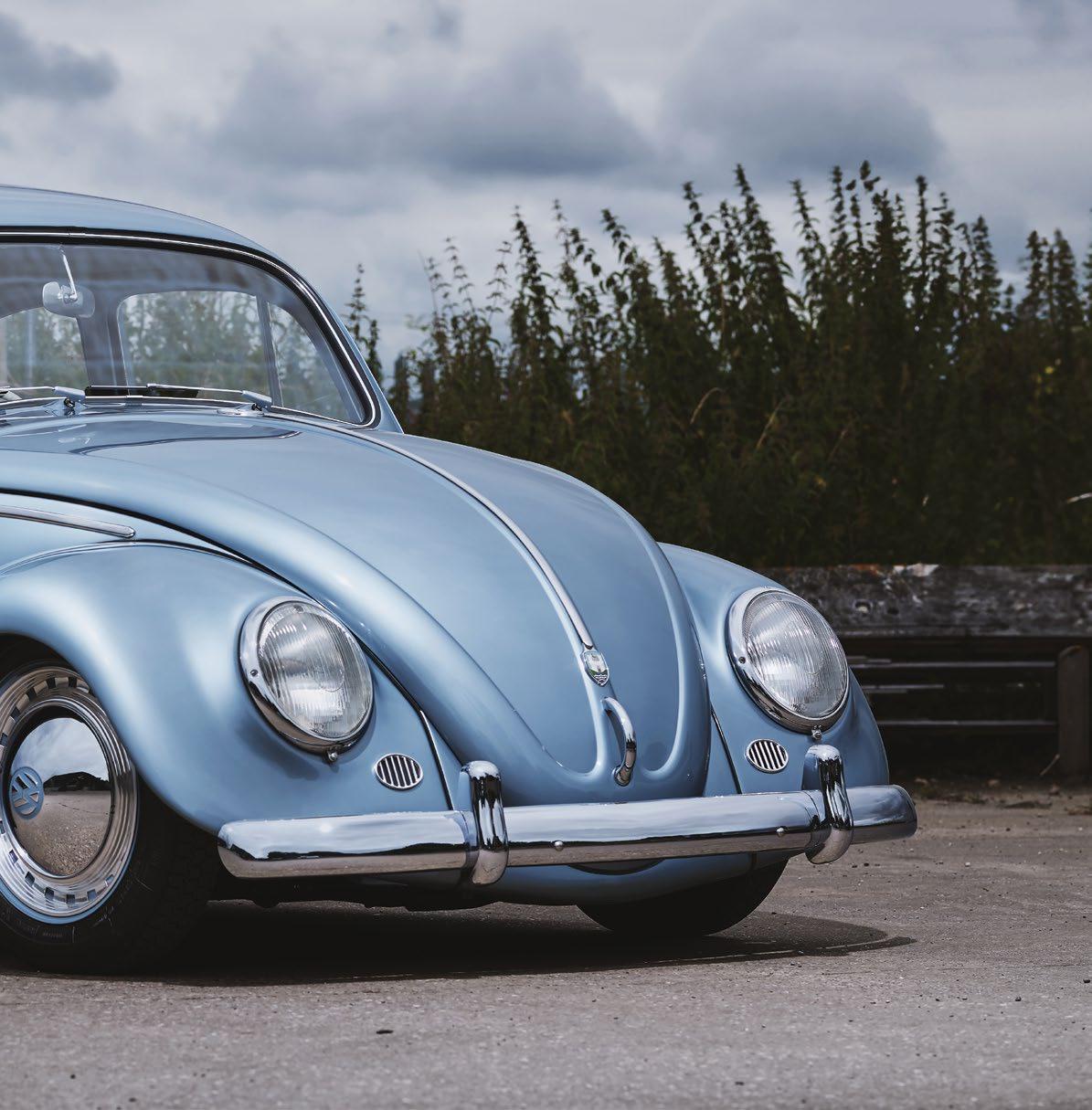
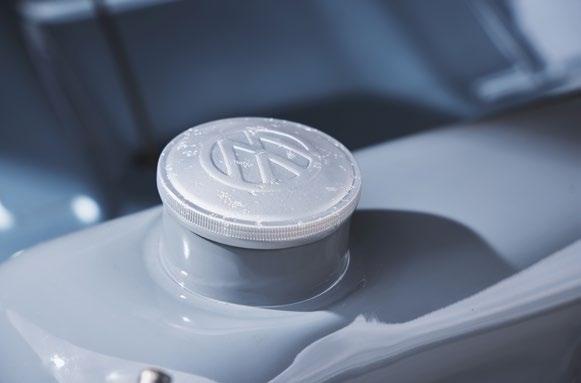
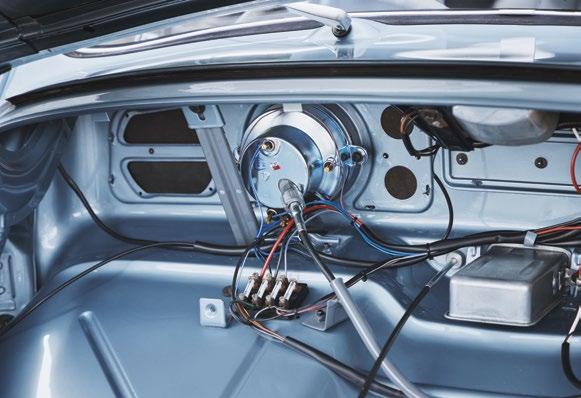
wiper motor, horn, etc. are all OG date correct and restored/ detailed. All the bolts that were painted from the factory have been painted body colour. I proper geeked out on all the details like that when I built the car because to me that’s really important. That’s the sort of details you should go to when restoring a car. I’m pretty sure most other people wouldn’t care, but I didn’t want stainless or generic bolts on the car.
I didn’t want any stone chip on the car and I wanted the chassis painted in semi-gloss black like it was from the factory. It’s loads more work to prep and paint all the non-visible bits like the chassis and inner arches. A lot of people like to smooth the spot welds out or make pretend spot welds to look right but I didn’t want to do that. I wanted all the proper spot welds to be visible to show the standard of the metalwork repairs.
Q: If you had change one thing, what would it be and why?
A: I probably should have built the car with stock suspension as I spent so much time making everything else as it would have been when new, but I didn’t want both my Beetles to be stock height. My Oval is really original, and even though I’ve been saying I want to lower it for years, I can’t bring myself to do it, so I lowered the ’58 instead.
Q: What’s next for you and the car?
A: Drive it and enjoy it. I’m not too worried about it getting damaged, because even though I built it to be an advert for our business, I don’t want an ornament that I’m afraid to drive, or else it was a waste of time building it. I want to get it to Europe next year.
There are loads of little jobs I want to do to it. I’d like a 356 or Vintage Speed engine but I’ll probably leave it as it is as it runs really nice.


I’ve got some better rear bumper irons that are ready to fit, and I need to fit the interior light, and the door card beading needs replacing with some a bit thicker.
Q: How often do you use the car?
A: I’ve only done around 500 miles in it so far. Used it for the commute a few times, took it to Stonor Park and a couple of local club meets.
Q: What’s your next project going to be?
A: I fancy a 914. Wouldn’t mind something stock looking but lowered, 16” Fuchs, and fit a turbo EFI to the original Type4 engine.
Or fit the suspension from the ’58 onto my Oval, put all the OG stuff back on the ’58 and do something with the Oval … not sure what, though.
Q: Who would you like to thank connected to the project?
A: Rich Jones, Steve Anslow, Leon Taylor, Chris Kirms, Matt Elms, Rob Evans, my sister Jenny, and my wife Lindsay for putting up with me banging on about things like do you think I should fit Fuchs?
Chris Kirman brought me loads of parts back from America that I’d bought on several occasions.
The day before VoWo, Rich, Leon and I worked for 24 hours straight, Rich’s brother Ste came to help for most of the day, and Nick the detailer was there all day till about 8pm. Steve Anslow and Dan Crosby came after they finished work and stayed till 6.30am Friday morning.
My car was collected at 7.30am, so I had 15 minutes’ sleep in the office, drove home, got a shower and an hour’s sleep, then

drove to the Volksworld show to meet Matt Elms who had met the transport guy and positioned my car in the show and cleaned it up.
I have made a load of amazing friends through the air-cooled VW scene.


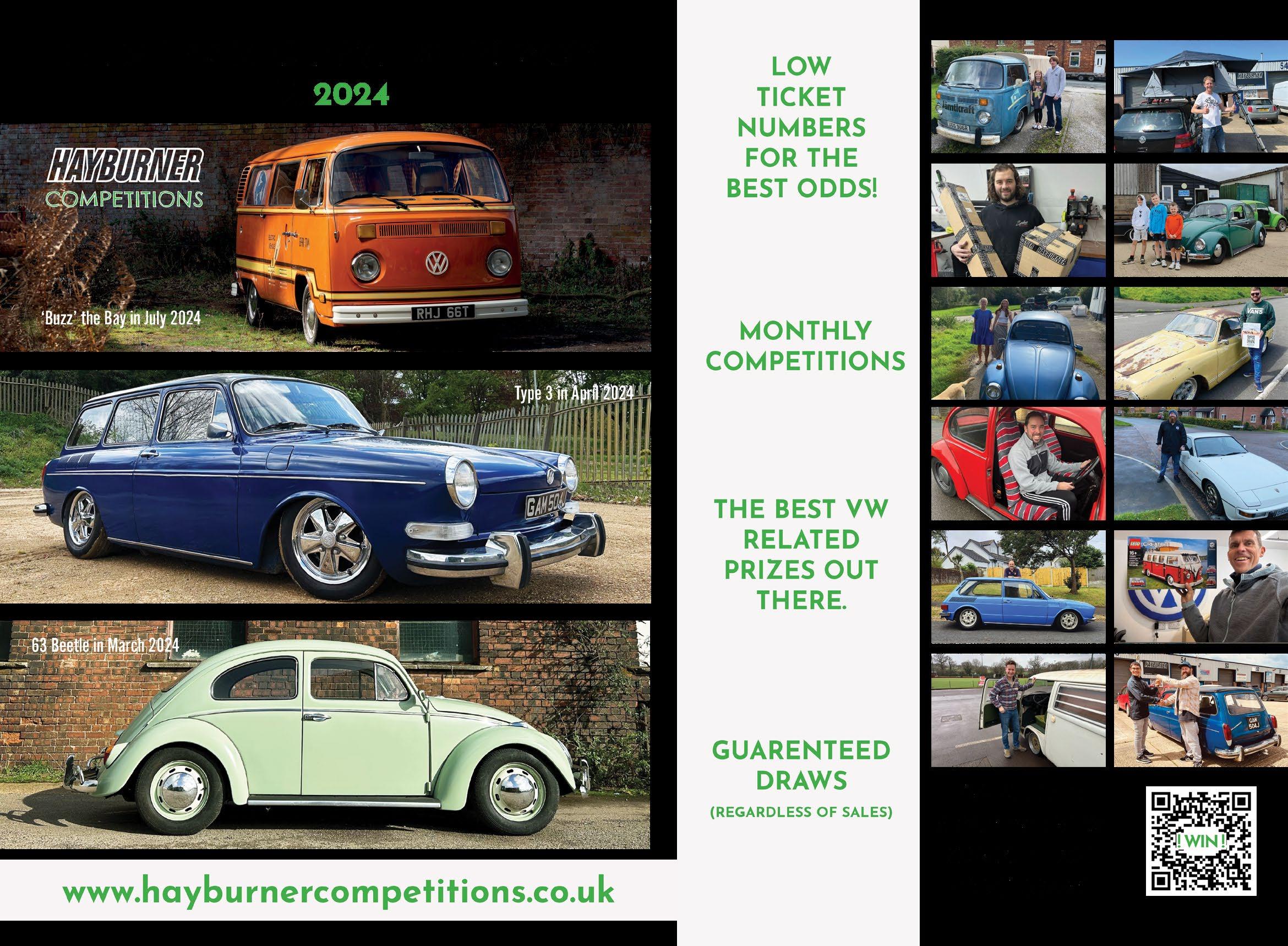

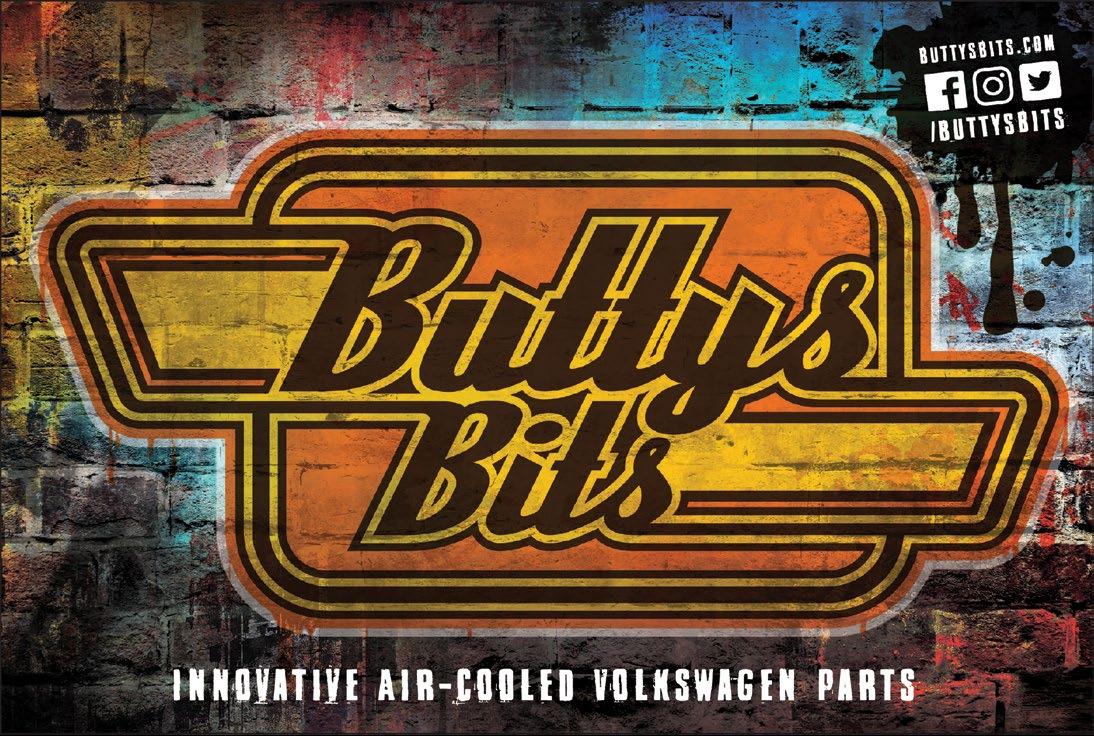



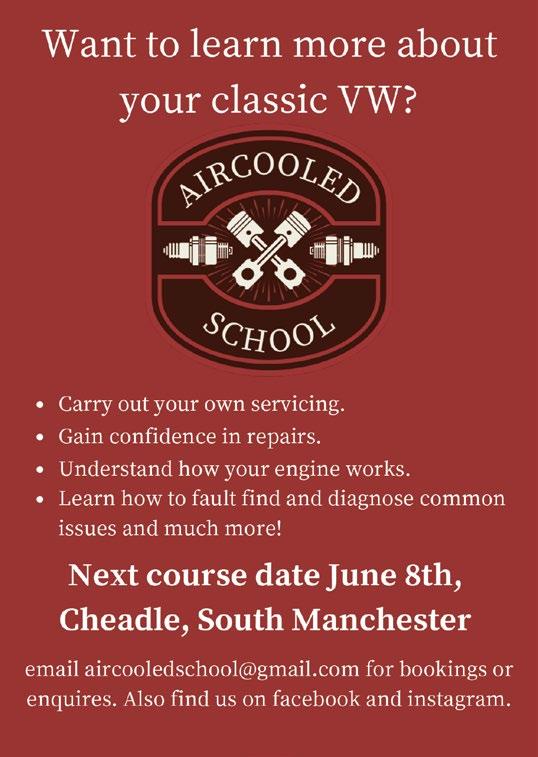
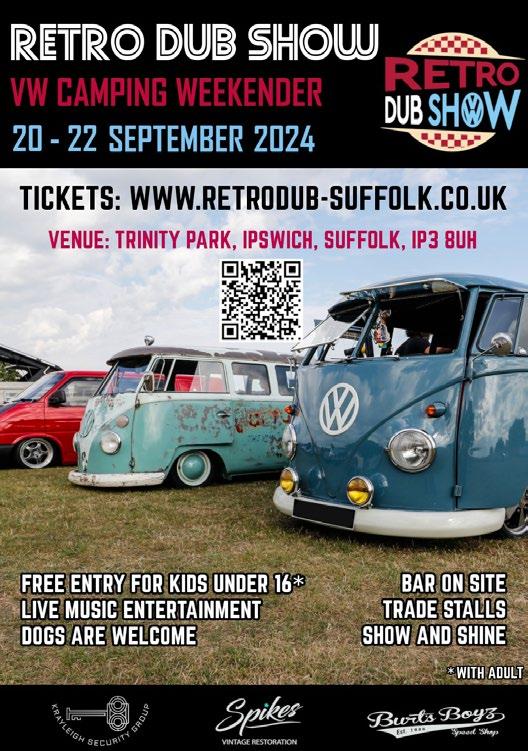
WANTTOADVERTISEHERE?PLEASEEMAILadvertising@hayburner.co.ukFORDETAILS
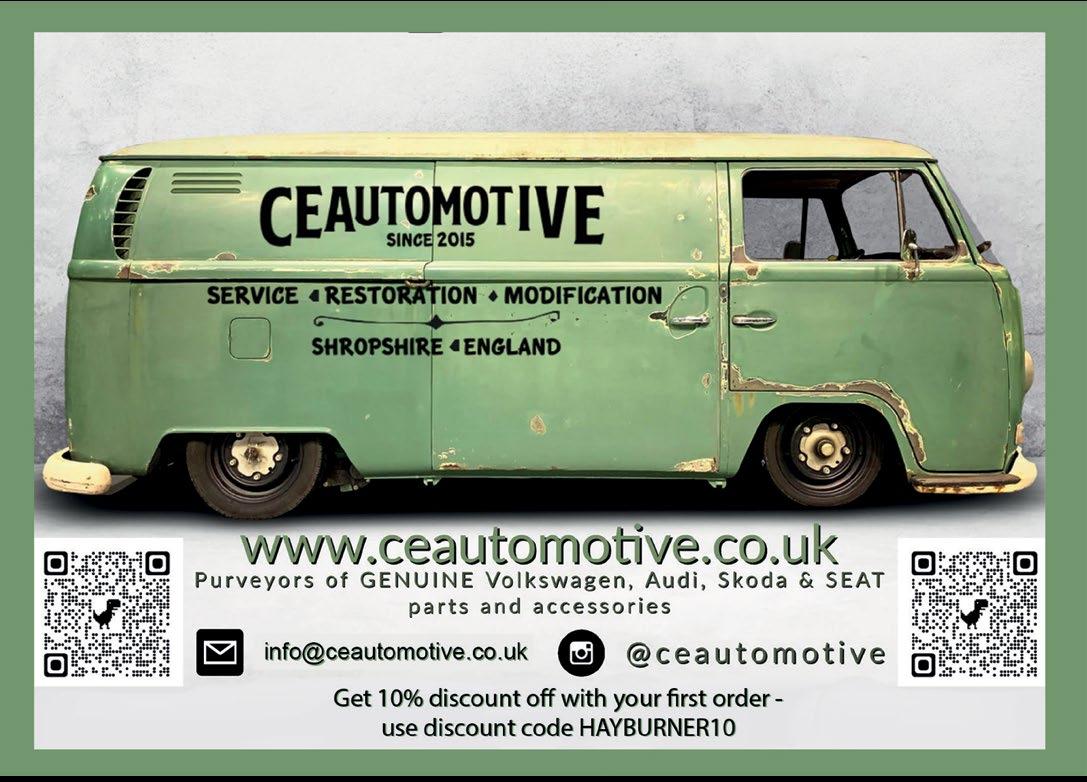

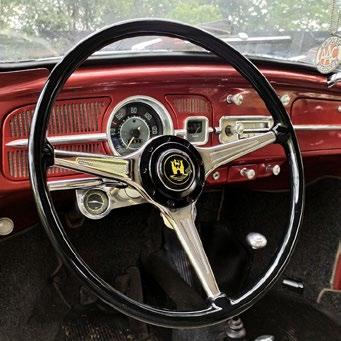
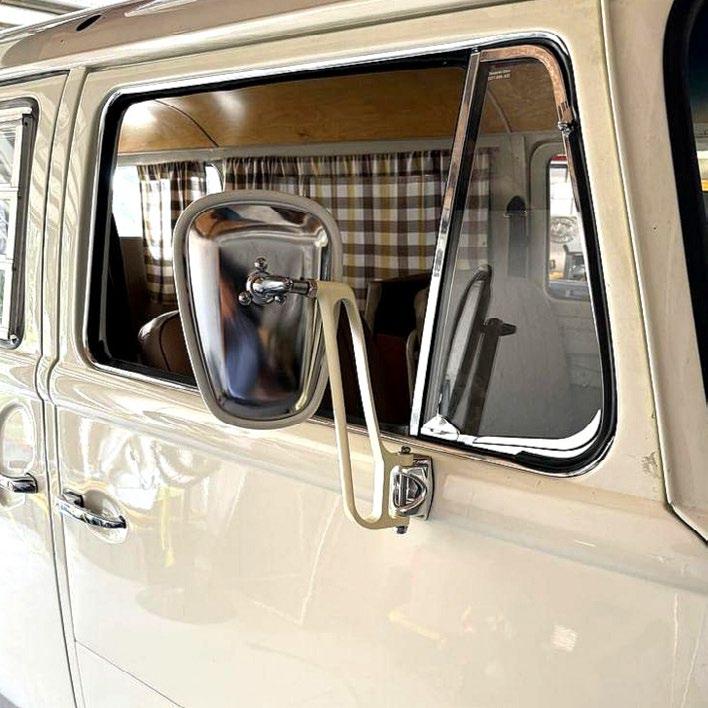
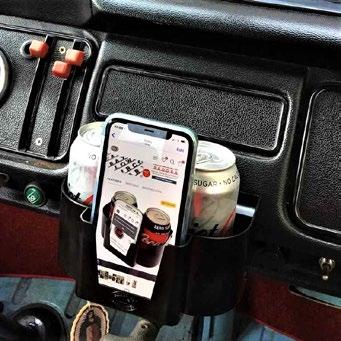
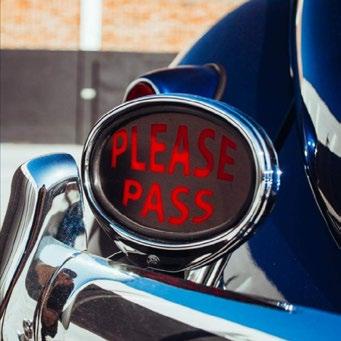
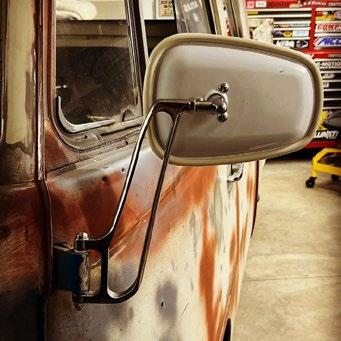
WORDS BY CHERYL DILLEY PHOTOS BY VICTORIA FAUX
Let’s rewind a bit – sixteen years, in fact. I (Cheryl) met Vic Faux whilst we both worked at Pizza Hut. Today, she’s not just the co-owner of Hayburner Magazine but also someone I proudly call my best friend.
Vic became my manager early on into us meeting at “The Hut”, so you can imagine the fireworks. Picture this: two assertive, passionate and ambitious women in a fast food pressure cooker – literally! Naturally, we clashed. I was the annoying know-it-all, always questioning her every decision; she was the bossyboots determined to rule the roost. But somewhere between the ease of handling customer complaints and the buzz of Pizza Hut tips, we realised we were more alike than we thought. The rest, as they say, is history.
So, that’s how I met Vic and Ned, but who is “we”? …
The other half (better half, in my opinion) is otherwise known as Caroline. We met in 2021 and hit it off instantly. When you find someone who shares your love of adventure, sunsets and crazy ideas, you know you’ve found something special. Naturally, I introduced her to my friends Vic and Ned, and they instantly hit it off. It wasn’t long before Caroline and I started dreaming about owning a VW bus together.
With Caroline on board, the search for our perfect VW bus became even more exciting. We envisioned road
trips, camping under the stars, and the freedom to explore wherever the road might take us.
Adventure is and always has been on our minds, and nothing screams adventure quite like buying your first VW. So after years of attending VW shows with Hayburner and witnessing hundreds of vehicles roll through the Fauxs’ driveway, the desire to own our own was undeniable. It made perfect sense to enlist the help of Ned and Vic to find our dream VW as our knowledge was minimal. We gave our “must” list to Ned and he got to work. As always, Ned exceeded expectations so much that we decided to put a deposit down without even seeing the bus in person (while on holiday in Greece, June 2022, I might add).
Meet our beautiful 1979 Type2 Westfalia Berlin, affectionately known as “Nora”.
One of the big-ticket items on the “must” list was to ensure it was authentic, and with the bus being a Westfalia, it naturally made me want to dive into the history of this particular model. Interestingly, the Westfalia story began much earlier than I realised – 1951, in fact. VW commissioned Westfalia to create a camper version of the Type2. Before that, these vehicles were used for slightly less glamorous purposes like ambulances, police vans and hearses. Talk about a glow up!




The model name was chosen with the utmost simplicity. It was named after Westfalia Werke, the contractor from the Westphalia region in Germany. Clearly, the marketing team didn’t spend too many late nights brainstorming that one.
It turns out that this vehicle is part of the golden era for the Westfalia model. They sold over 70,000 units in the decade she was made. So not only is she authentic, but she’s also a bit of a superstar in the world of camper vans.
Driving a left-hand drive classic like this is a truly unique experience. Let’s just say that it’s a whole different ball game compared to your everyday car.
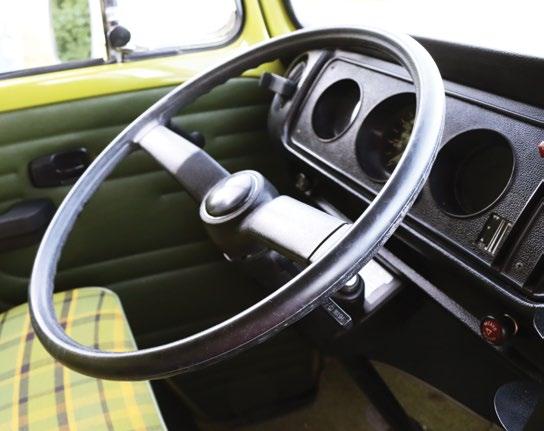
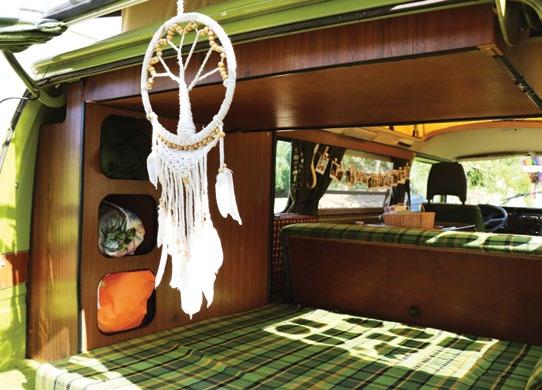

We were forewarned that this vehicle will always cost us, but I can honestly say I’m ok with that; it feels different. We see it as every penny spent is an investment in our freedom and the chance of a new adventure.
Nora has always turned heads. She is truly a looker, and being a part of that is a fantastic feeling. It fills you with pride as an owner. Furthermore, when you’re out on the open road, it transcends into something magical. The constant acknowledgements from the broader VW community, everyone waving at you with the signature hand gesture (if you know, you know) all add to the experience. It’s these little gestures that imbue a sense of happiness when you’re out and about and genuinely give you the feeling of not
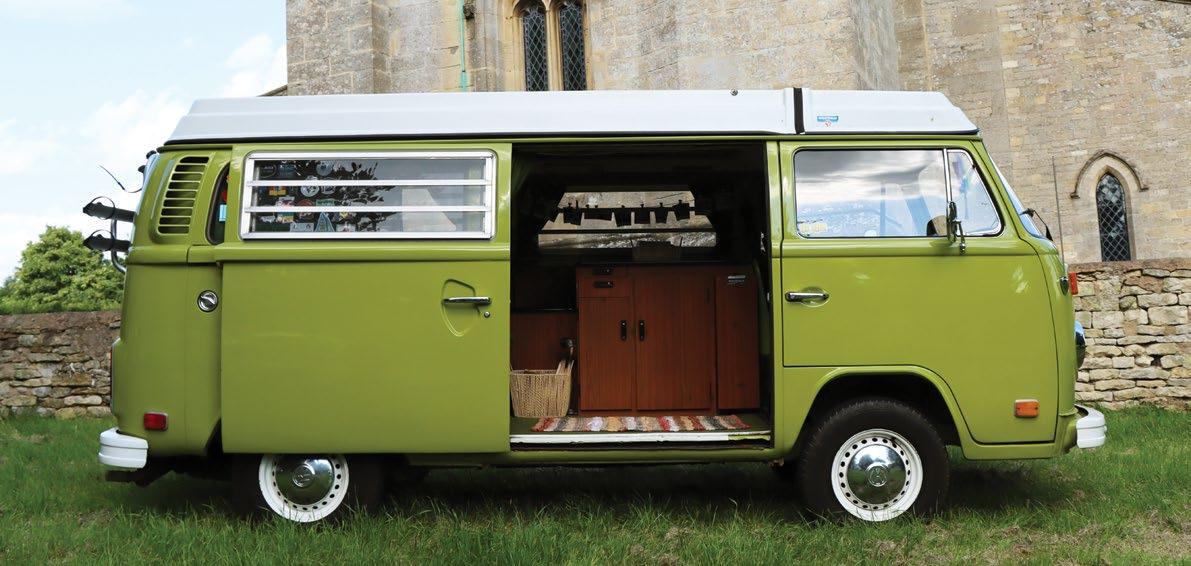
wanting it to end.
Of course, it’s not all sunshine and rainbows (no pun intended).
Nora drinks fuel like it’s going out of fashion and we only really realised this on our group trip to Cornwall with Hayburner and friends. We pulled over for what we thought was a fuel stop, as we were running on
red (having filled up at the same time as the others), to find out that it was only us on the red and the others just wanted a break. Not to worry – Chez was in convoy, albeit in a Land Rover, and he kindly offered his “rapid” services if we took it over to him. I can gratefully say, he did just that. Thanks Chez!
Anyway, fuel topped up and back on the road, the journey – in our opinion – was bliss. Maybe not so much
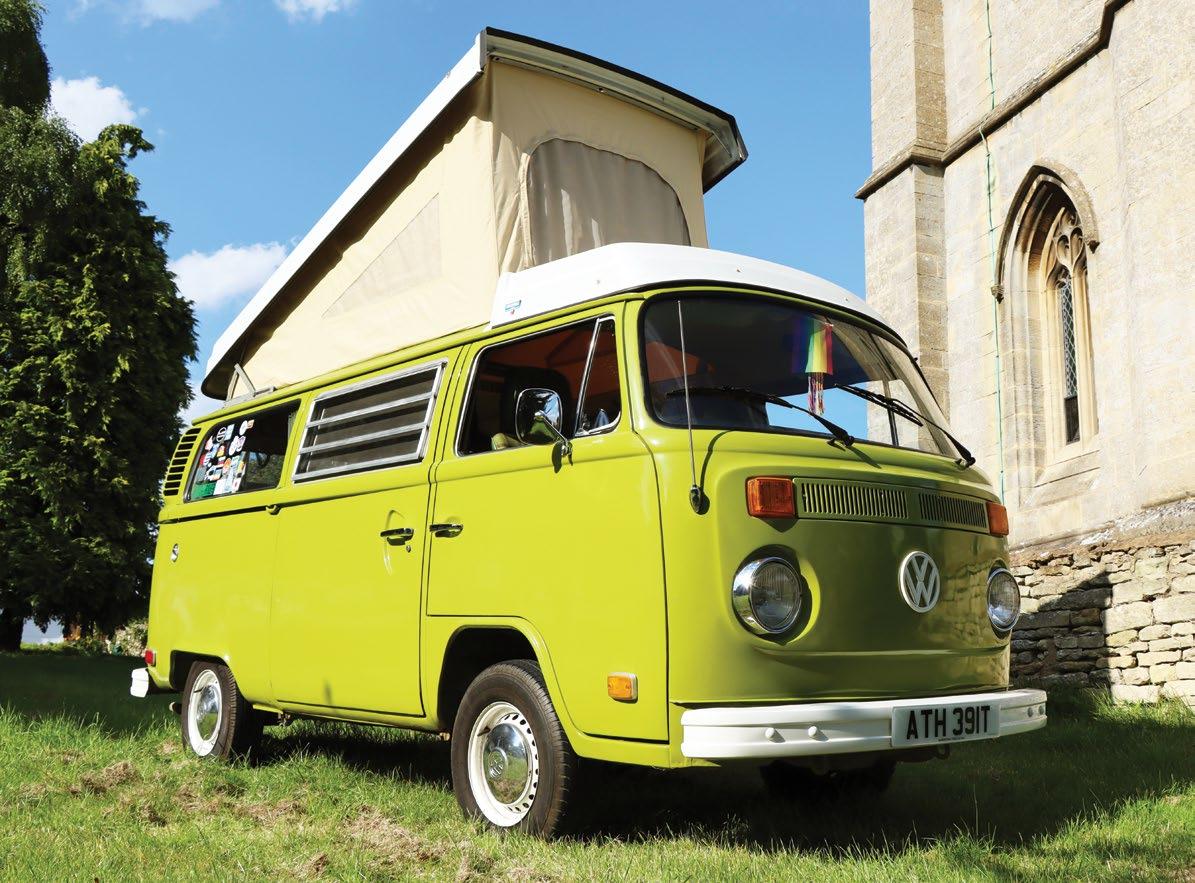
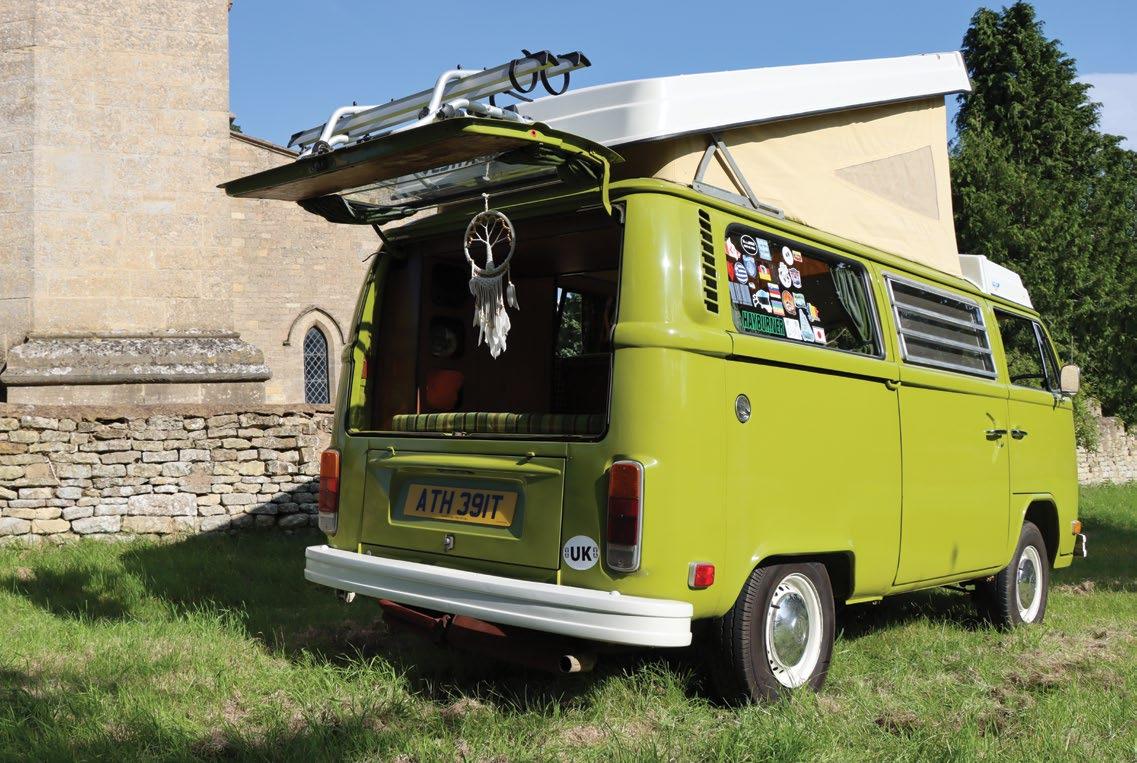

in Ned’s opinion, who got Vic to ring us a few times to say, “Why is Caroline driving so slowly? We’re going at 50mph”. Inevitably we are amateurs in comparison to these guys, but in Caroline’s defence, we weren’t aware that the speedo was showing 5mph less than the actual speed, and one of the beauties of driving these buses is that time feels no issue so a leisurely pace works for us.
The only other gripe we have is her constant dripping of oil all over our driveway; she acts like she’s given birth to 20 children and needs to work on her pelvic floor. However,
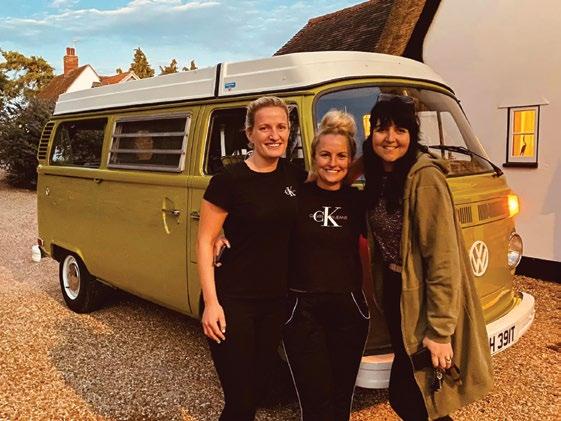
there are worse issues to have in life, so we take the good with the bad and don’t allow these minor issues to set us back.
Some of our best memories are tied to this bus and there is no greater feeling than when it comes to March/April, and I start hounding Vic to say, “Are you taking your bus out of storage yet?” For us as a couple, Nora is more than just a vehicle. She represents happy memories, the reminder to travel minimal, and finding the best in simplicity. Every journey with her is a reminder that sometimes, less is
truly more.
We’ve been lucky enough to drive over to France and explore the beautiful Loire Valley in her, which was phenomenal, especially pitching up in the middle of the vineyards without a soul in sight.
Cheers to Vic and Ned for enabling Nora to be our gateway to freedom and adventure!





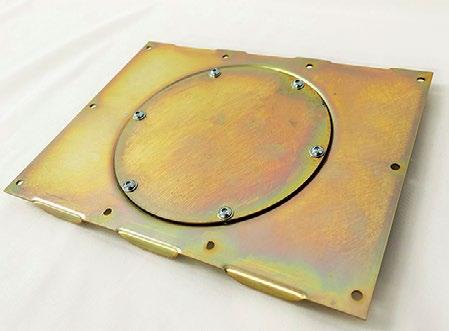
Bespoke, handmade and high quality windscreen cover comes in a range of colours, edge trims.
Quick and very easy to fit these covers will be keeping that early morning sunshine well away from those camping lie in eyes! All our covers also come with a small Hayburner label and fully complete with storage bag.
Custom orders are welcome, please email hayburnersales@hayburner.co.uk
Available front and rear for all year buses.



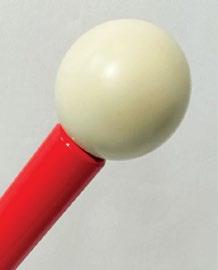

*NEW AND IMPROVED* Bay Window fuel sender access hatch for Late Bays.
A simple solution for busses that have had (or are going to have) a hole cut in the rear parcel shelf to access the fuel sender and laser cut to the correct profile.
Easy to fit, but if you’re not experienced or confident in the procedure please seek professional advice before cutting above your fuel tank.
Watch this space for a split screen version




Bug-Tech made gear knobs, but not just for Bug-Techs.
We now have a whole section on the website dedicated to gear knobs. The new gear knobs are available for all models of VWs.
They are drilled and tapped to fit the standard gear shifter from your car. We can make them for aircooled models and for Type 25’s even T4’s.
Have a look at our range or send us an email to see if we can make one for your car. Keep an eye out because we are constantly expanding the range too.
Dan@hayburner.co.uk







We’ve sourced one of the best suppliers in the UK for classic Volkswagen carburettor kits with some added punch!
Different sets of Weber and Dellorto’s whether for twin-port or single port, standalone or twins, Type 1, 3 or 4 engines - get your replacement carburettors for your Aircooled Volkswagen engine here on the Hayburner store.
We also have a range of linkages and air-filters for all your carby needs.









*NEW* and improved EVA Restos Skid plate - Armour for your front beam that helps skip over bumps in the road. The latest design for our super popular T1 Skid Plate kit, designed to offer unrivalled protection for your framehead bottom plate/edge on your lowered beetles and Ghias.
Fuel Filter Kits - An elegant and safe solution to fit your inline filter. Fits to the side of a stock T1 gearbox using the original fixings and sits inline to join the stock chassis solid line to the engine bay solid line. Mounts the previously vulnerable filter out of harms way, and it’s positioning makes for the most efficient filtration without being dangerously mounted within the engine bay itself.




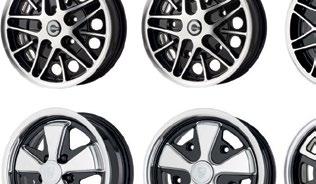




What better way to treat your car than with a new set of wheels!
Wheels, It’s one of the first things we thing about on our cars. It’s also one of those details that can make a car’s look or completely change it’s style. Maximum effect for minimum effort.
We’ve added a brand new wheel selection to our site now with PCD’s to fit the most common models.

Whether you are early or late, split or wedge, chrome or detailed we have something for you. And we are still expanding the range too.


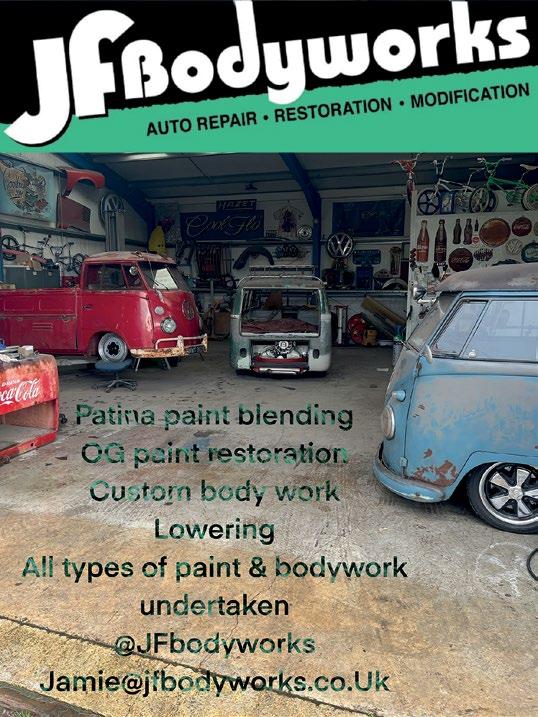


WANTTOADVERTISEHERE?PLEASEEMAILadvertising@hayburner.co.ukFORDETAILS
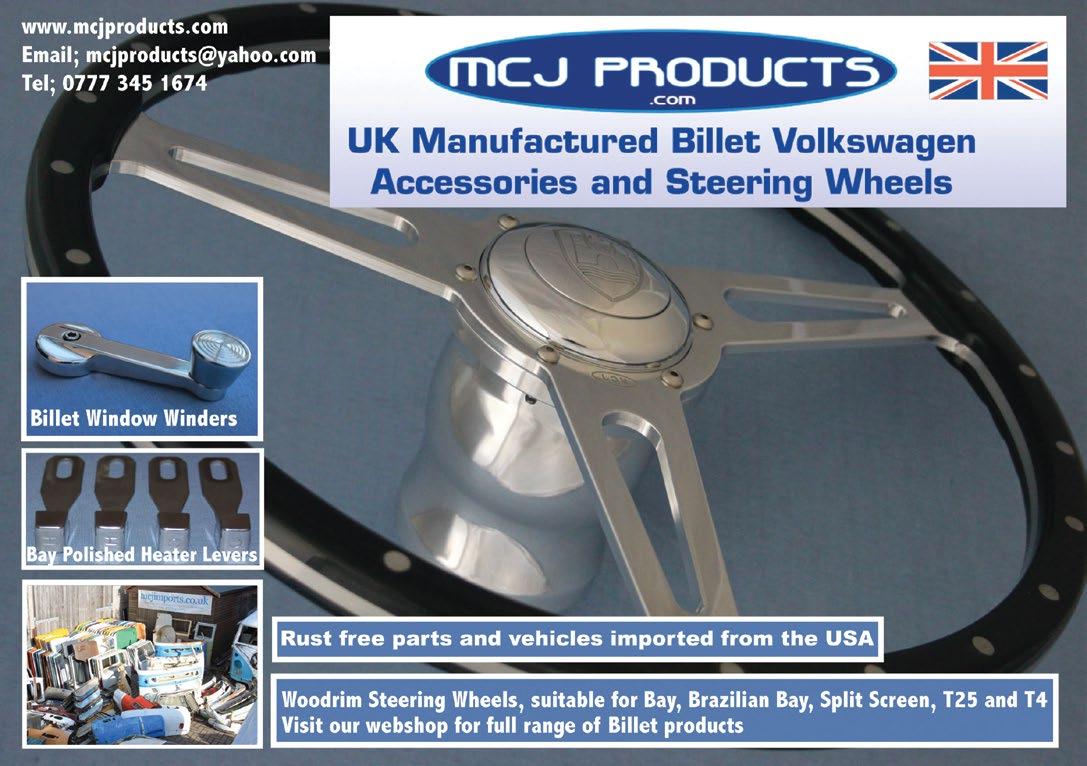


You have to admit that the earlier cars of any marque visually have better styling. This is not a snobby view, it’s not to dismiss later cars (I own a ’72 Fasty and a ’78 Bay), and later cars can be made to look amazing too. It’s just that as time goes by car companies introduce more safety features, bigger bumpers, lights, windows, etc., and this in my opinion distracts from the original design. The same could be said in this feature car’s case, as the prototypes of the 1930s were even more minimalistic.
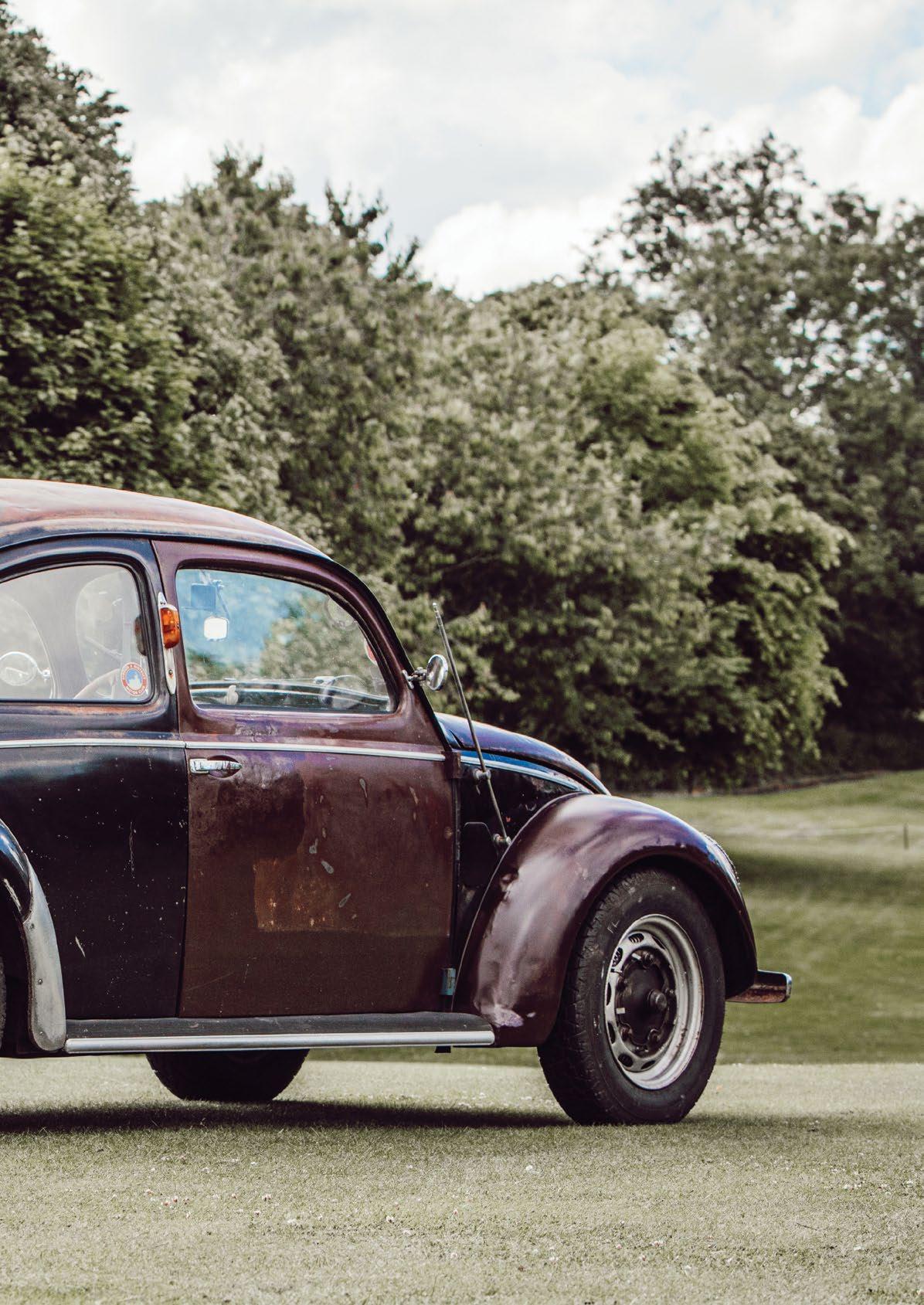
But this isn’t your average 1951 Beetle. Paul Blofeld’s car is a nod to the Old Speed Racer styling and tuning, with tonnes of cool custom touches Paul has added through the years which you will read about later. Paul has owned Beetles since the 1980s, starting with a ’66. After that car he was hooked and just kept buying earlier and earlier cars. This may have something to do with the fact that I mention above?
Paul restores high-end antiques for a living. His creative skills certainly come across in this
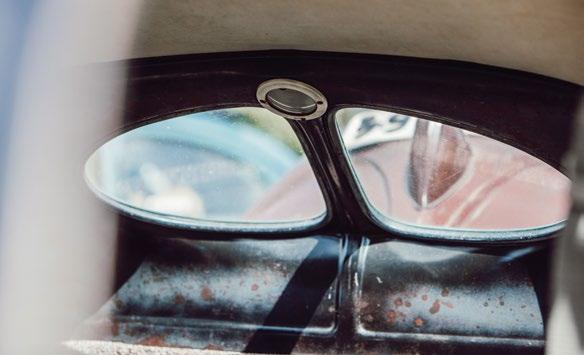
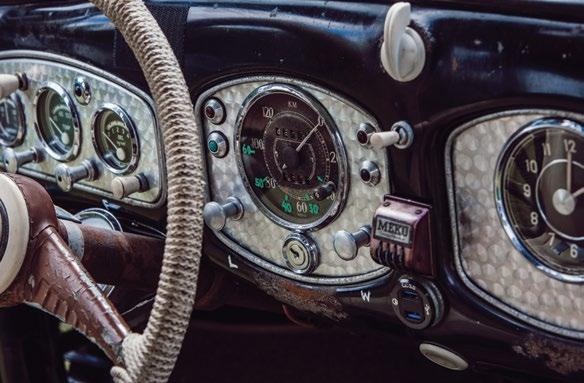
build, as you can see all the little trick bits Paul has fabricated and added to the car, to give it that distinct Old Speed Racer style that it oozes by the gallon. As mentioned, Paul had owned some pretty cool cars since getting into VWs in the 1980s, including a ’54 sunroof Oval and ’46 Beetle! He also has some sweet British bikes – a ’59 Triumph Tiger and a ’33 BSA Blue Star.

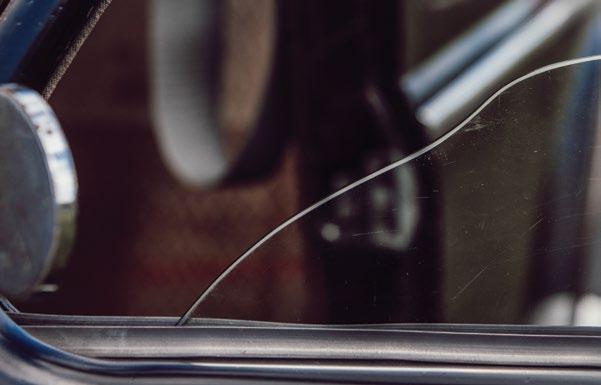
The genesis of this car was in 2014 when Paul was on the search for a Split Window Beetle project, with a desire to build a daily driver on a budget. His friend Sebastian Knowles had just bought a Split in Sweden and his contact had “a few other project cars” available, as you do in Sweden. It was October and winter was closing in, so Paul, Seb, and Paul’s son Rory (demonlung66 – another talented artisan


of metal) headed off to Sweden, to then drive eight hours up country. On arrival, Paul took a look around the guy’s yard and made a quick decision on the remnants of a ’51and also a misshaped ’50 as a parts donor.
The team then spent 16 hours levering the ’51 out of the ground and dissecting the ’50, with son Rory

skilfully wielding the petrol disc cutter. It was then back to the seller’s workshop to get Seb’s car and the ’51 rolling in readiness to board the boat and make their way back to Blighty.
The cars and parts arrived two weeks later at Tilbury docks to be collected in style using a horse box and trailer, high-tailing it back at 40mph to
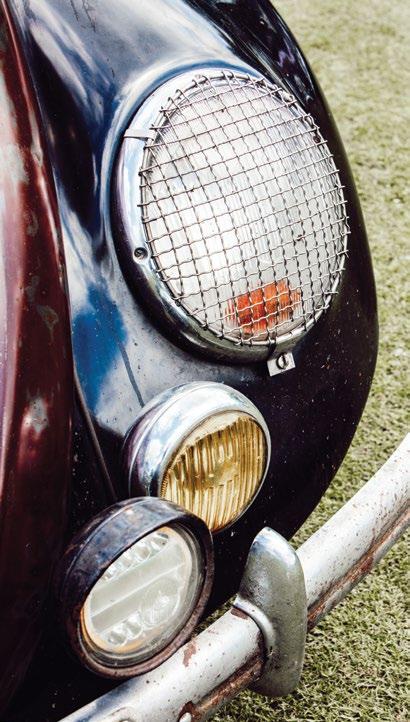


Gloucestershire. The ’51 was towed into Paul’s workshop by sadly missed friend and inspiration Geoff Sumpter, in his WWII Jeep.
The ’51 had been hacked up in a pretty brutal fashion in the Swedish woods and robbed of most of its parts before being abandoned. Paul saved as much of the original metal as possible. What wasn’t there, he made or found during the resto. The metalwork Paul undertook on this car is amazing when you think
that every decision was made to save as much of the original car as possible. There were repairs to the frame head, tunnel, fuel line and guide tubes. New floors were added. The front clip was severely mullered so Paul carefully straightened that out. The rear was rotten so new metal was let in on the bottom three inches. The rear lights had been cut out using a Stihl saw, leaving massive square patches to be replaced. There was also, let’s say, a generous hole where the rear split window and
air vents used to be. This is where the ’50 comes in; the window, vents and section of roof were stitched in. This is why you see two different colours of panels –L41 Black and L51 Bordeaux Red – as Paul wanted to retain as much of the original paint of both base car and donor as possible. As with a lot of these early cars rescued from Sweden, they were dumped and in this case rescued in a pretty gnarly fashion. The ’51 was lifted from its grassy graveyard by telehandler, unfortunately straight
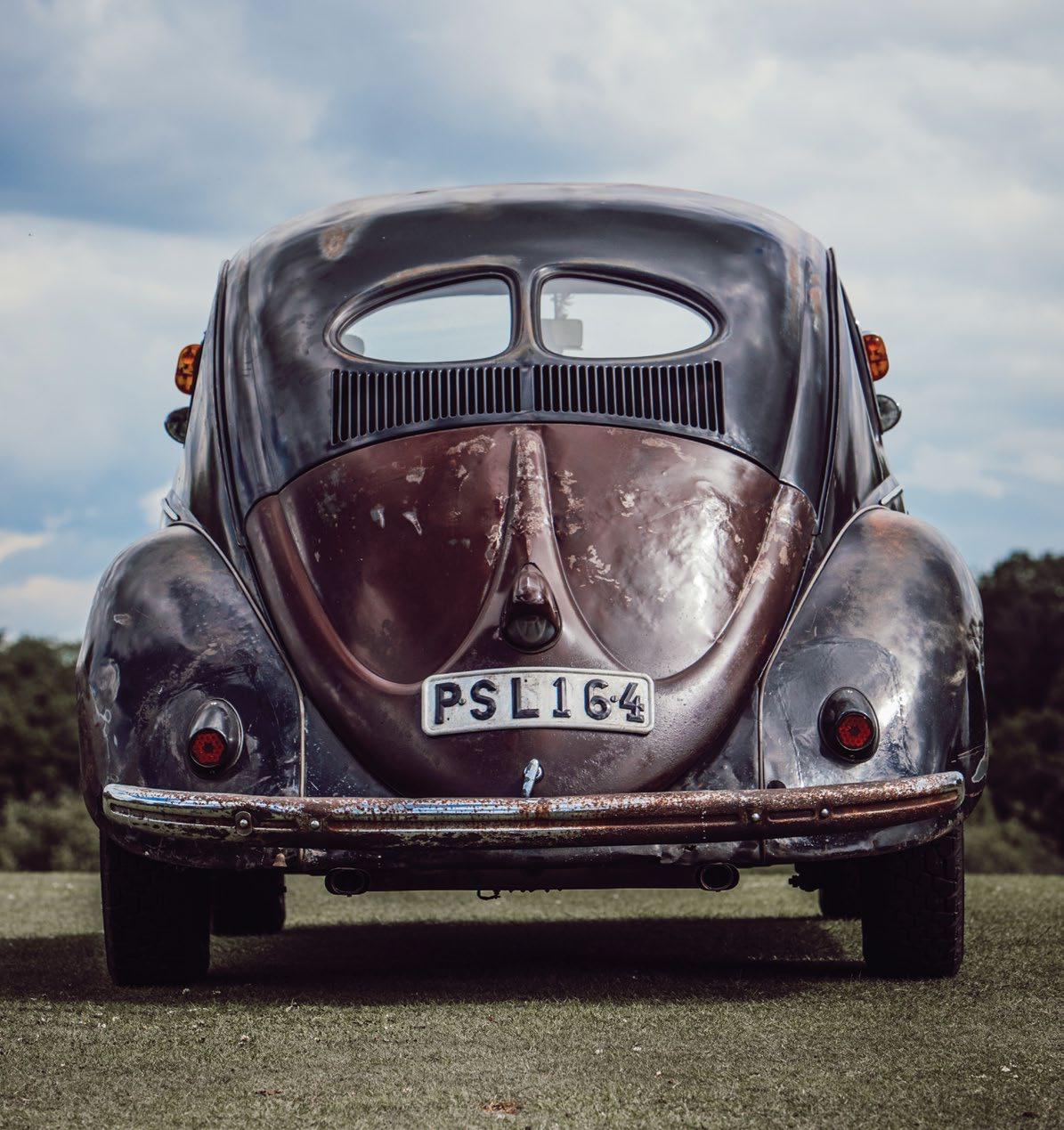
through the front windscreen. By doing so the roof had been stretched, and there was a 10mm gap at the top of the screen. Paul made a template and had a laminated screen made to fit the hole.
The interior hosts as much of the original as Paul could save and that was left in the car. The original steering wheel surprisingly was still there although cracked and damaged, so Paul bound it with cord as can be seen in
the Otto Matte race car in the Prototyp Museum in Hamburg. The interior is that of an early Oval, and Paul did a trade for some seats and sourced some door cards and bits to complete. The carpet was salvaged and repaired from another donor – a Swedish ’52 Split. Every component was missing in the dash, giving Paul the space for a bit of creativity. As was to be expected, he made all the dash pods and gauge panels from scratch, using aluminium
finished with engineered swirls. They play host to VDO oil temp, pressure, amps and tacho. The speedo was modified to add a trip counter. These all look so at home that they could easily have been done in the 1950s. The lap belts are genuine VW, sourced at Peppercorn 20-odd years ago. It’s not all period accessories in the cockpit: Paul has a Bluetooth mini rig 3-speaker tucked away, and a usb charging port which fits perfectly in the cigarette lighter.

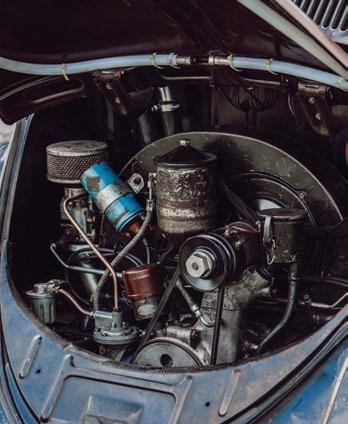



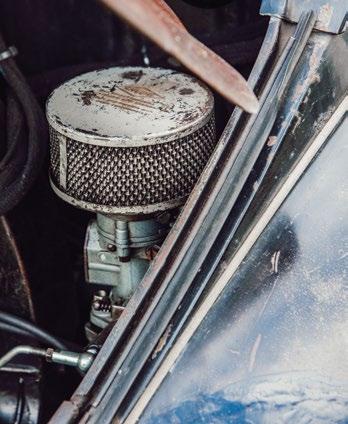
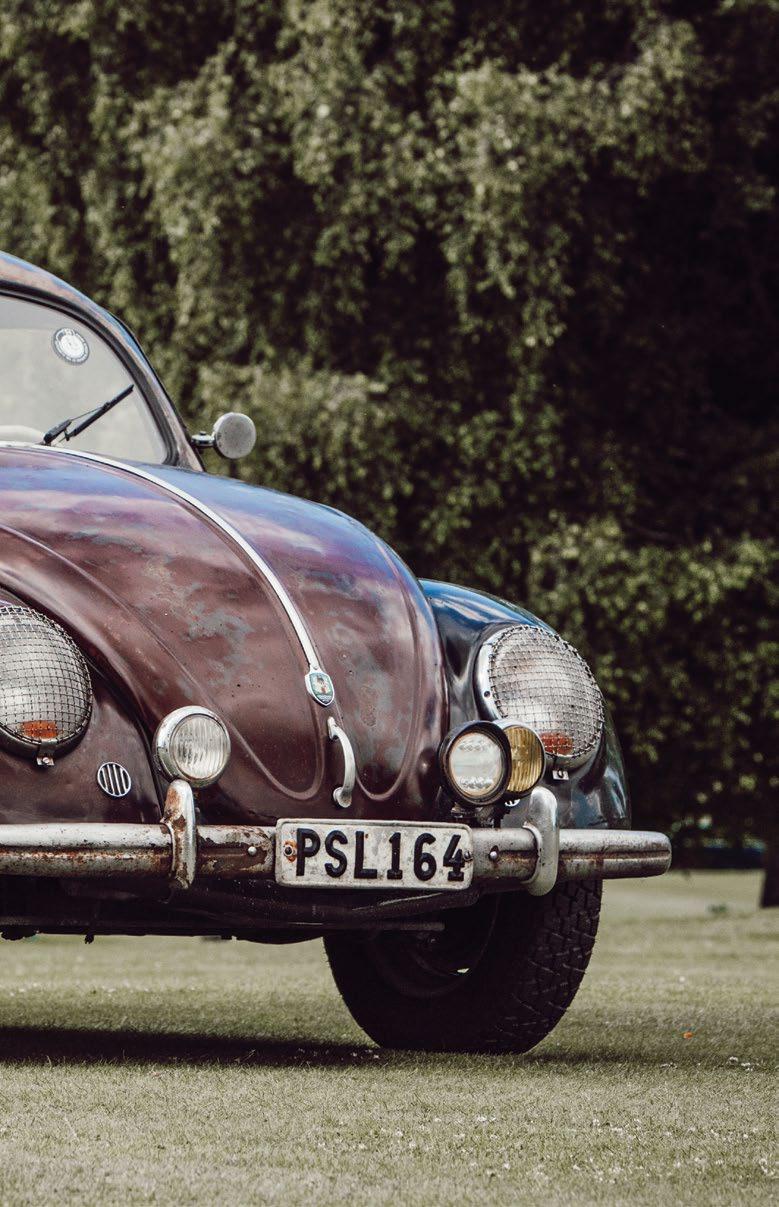
The running gear consists of Avo shocks front and rear, CSP beam braces and antiroll bar, Porsche 356 Lemmerz 4.5” x 15” wheels clad in Verdestein Snow Classic 165 86Q tyres. Pulling everything to a halt are ’58–’64 40mm Sebro drums from CSP with aluminium cooling fins cast onto the drums, which Paul made the pattern for and then a local foundry did the casting – literally a very cool touch.
The first incarnation of the engine was a 30hp with AMR500 supercharger, which Paul says was fun but problematic. It melted piston number 3, broke the manifold and pressured the case which blew oil everywhere. It eventually broke the crankshaft … but still ran! The second generation is a 30hp-based 1500cc again, all built by Paul. This engine consists of 69.5 Okrasa crankshaft and cam, 2-piece pushrods, reworked 30hp heads with bigger valves and ratio rockers, 38mm pistons, lightened flywheel, 32 pbic solex carbs, Bosch 383 distributor and Porsche dynamo, running about 60hp. The gearbox was a collaboration between Paul, Pete at Cogbox and a local engineering shop – Split case Oval 3 synchro fitted with ZF limited slip differential.
After three years of evenings and weekends, the car was ready for Hessisch Oldendorf in 2017 and the Peterman Muller Rennen hosted by CP at the Prototyp Museum. The car has been in regular use and evolving since then.
Paul would like to thank friends Seb, Carlos Fandango for their continuous support and enthusiasm, son Rory for his metal working genius skills and always being at hand when needed, and the engineering and long-term friendship of Cogbox.
Paul is one of the most genuine, humble, down-to-earth and friendly people I know. His hardcore ’51is a great reflection of his skill and creativity – such a cool car, used as intended, always raced and rallied.




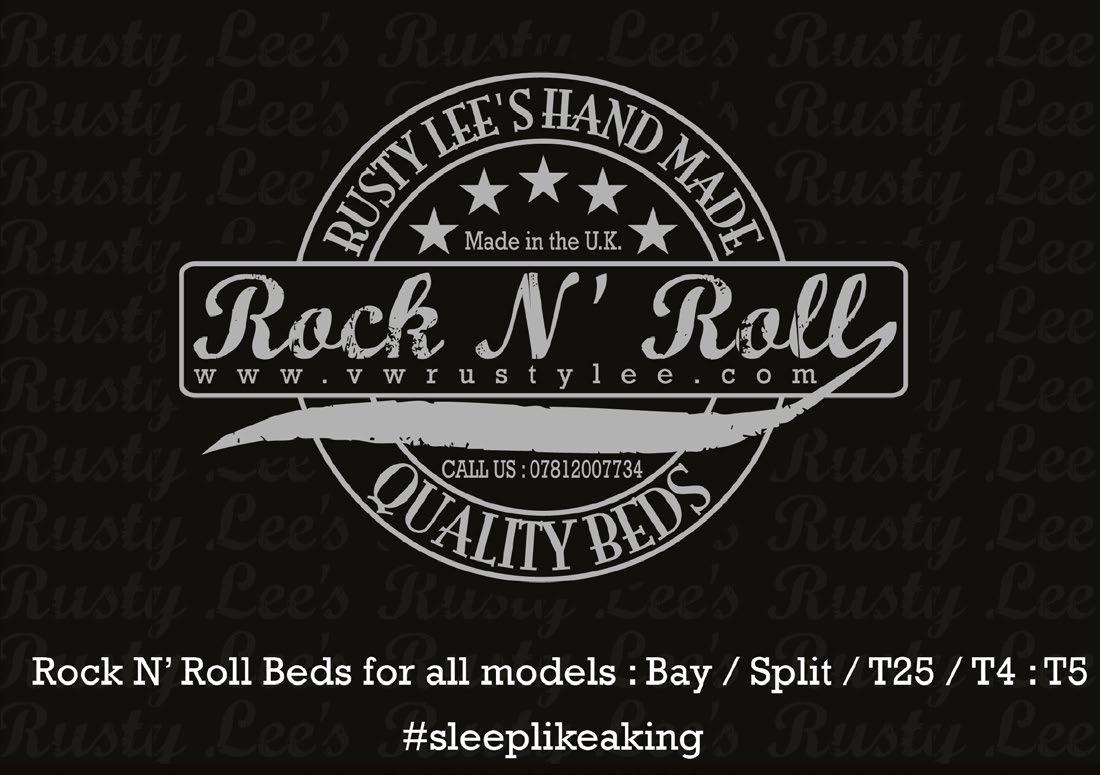

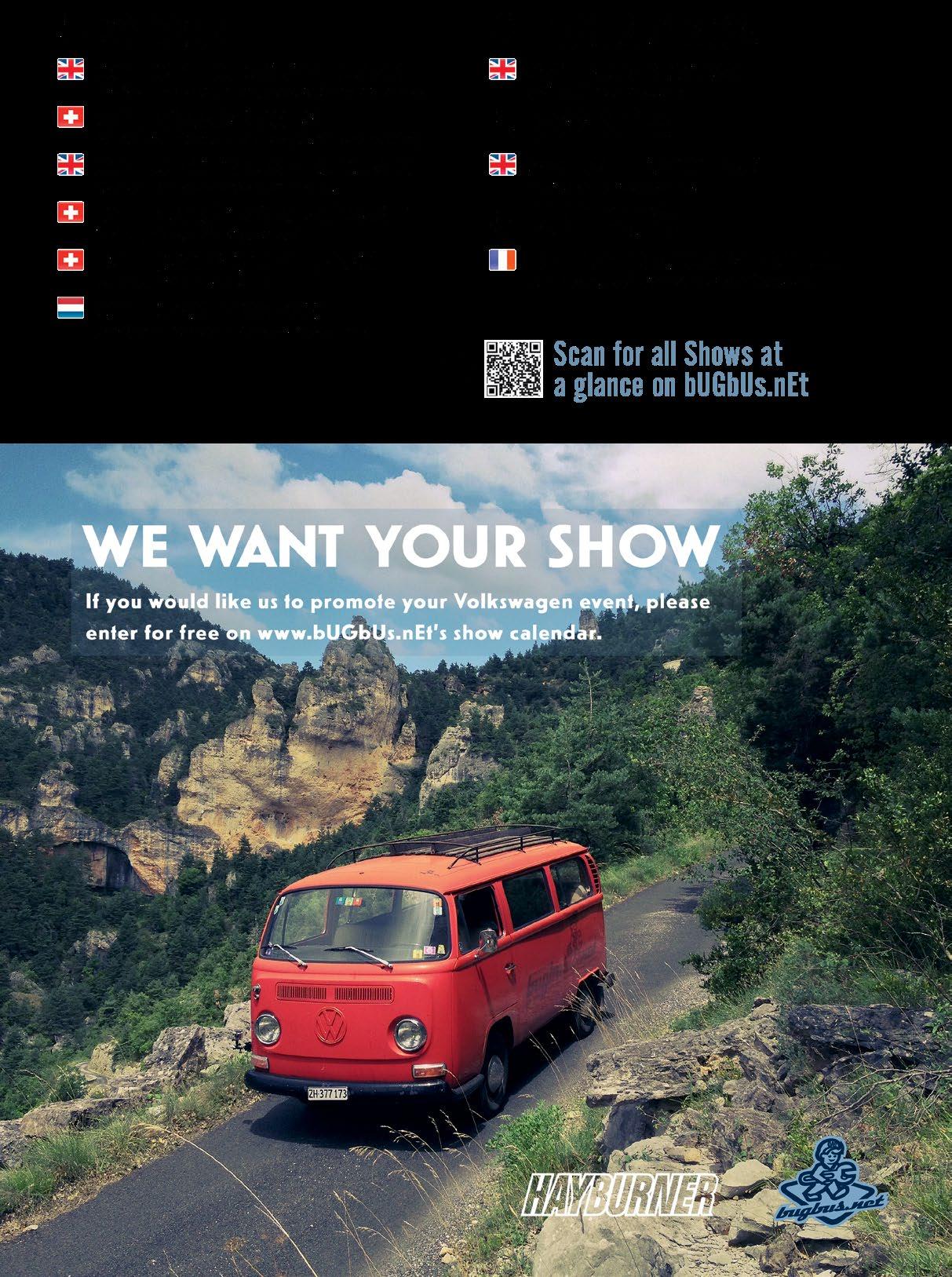
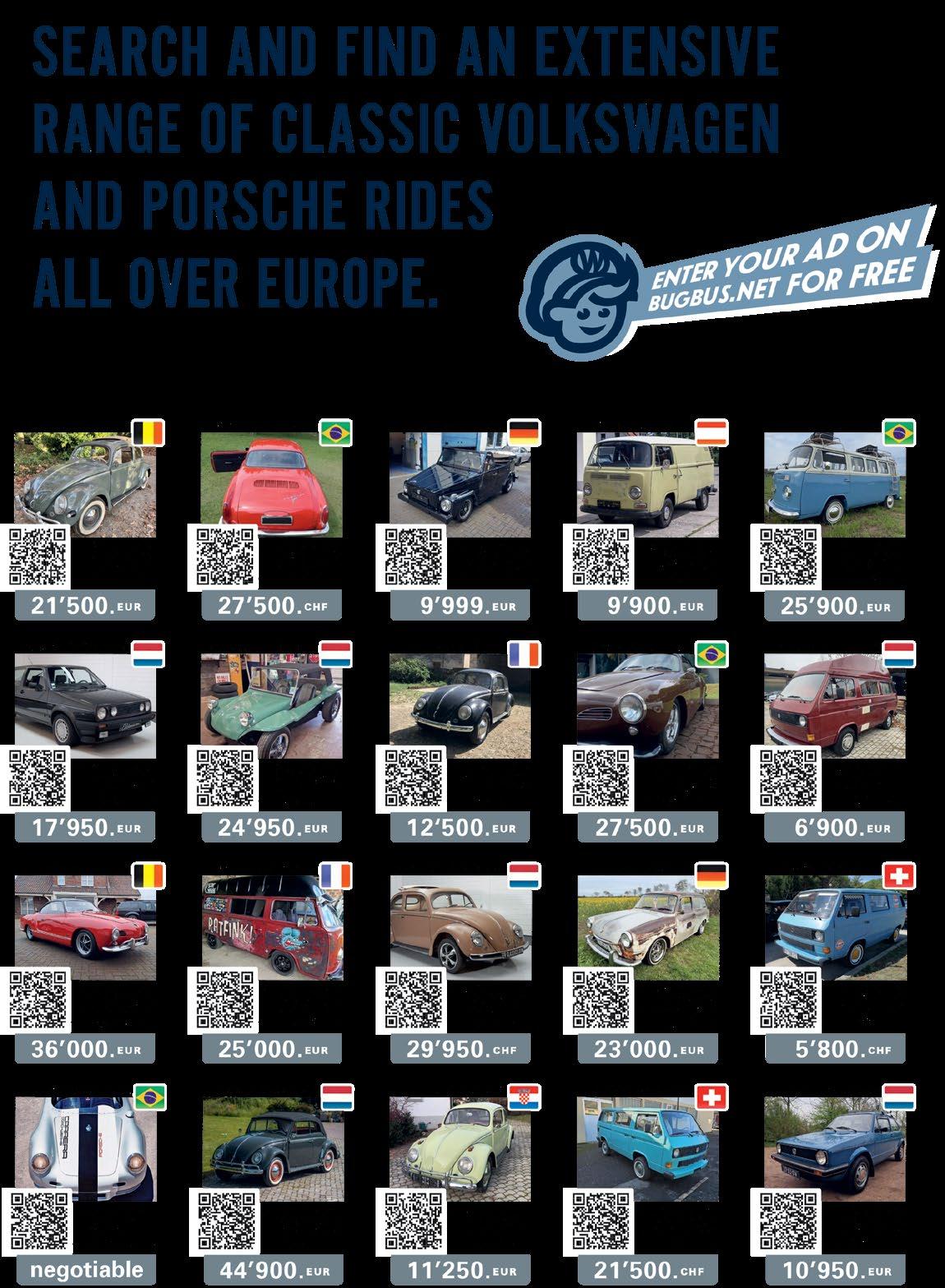







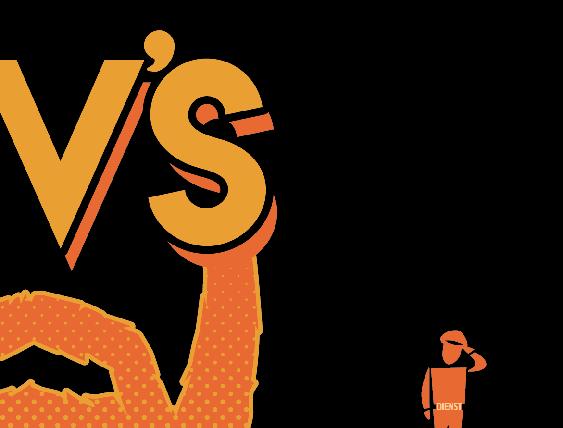







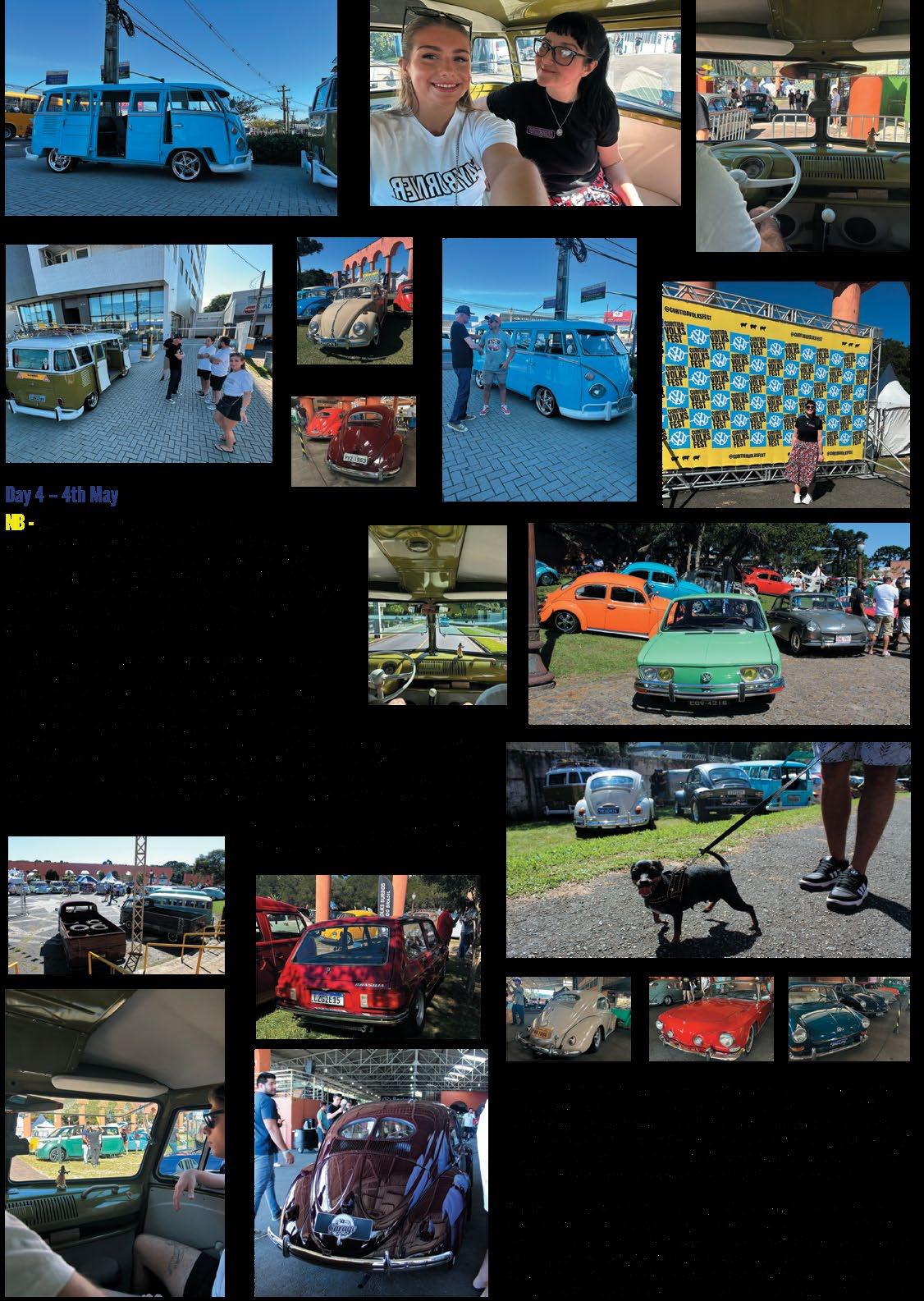


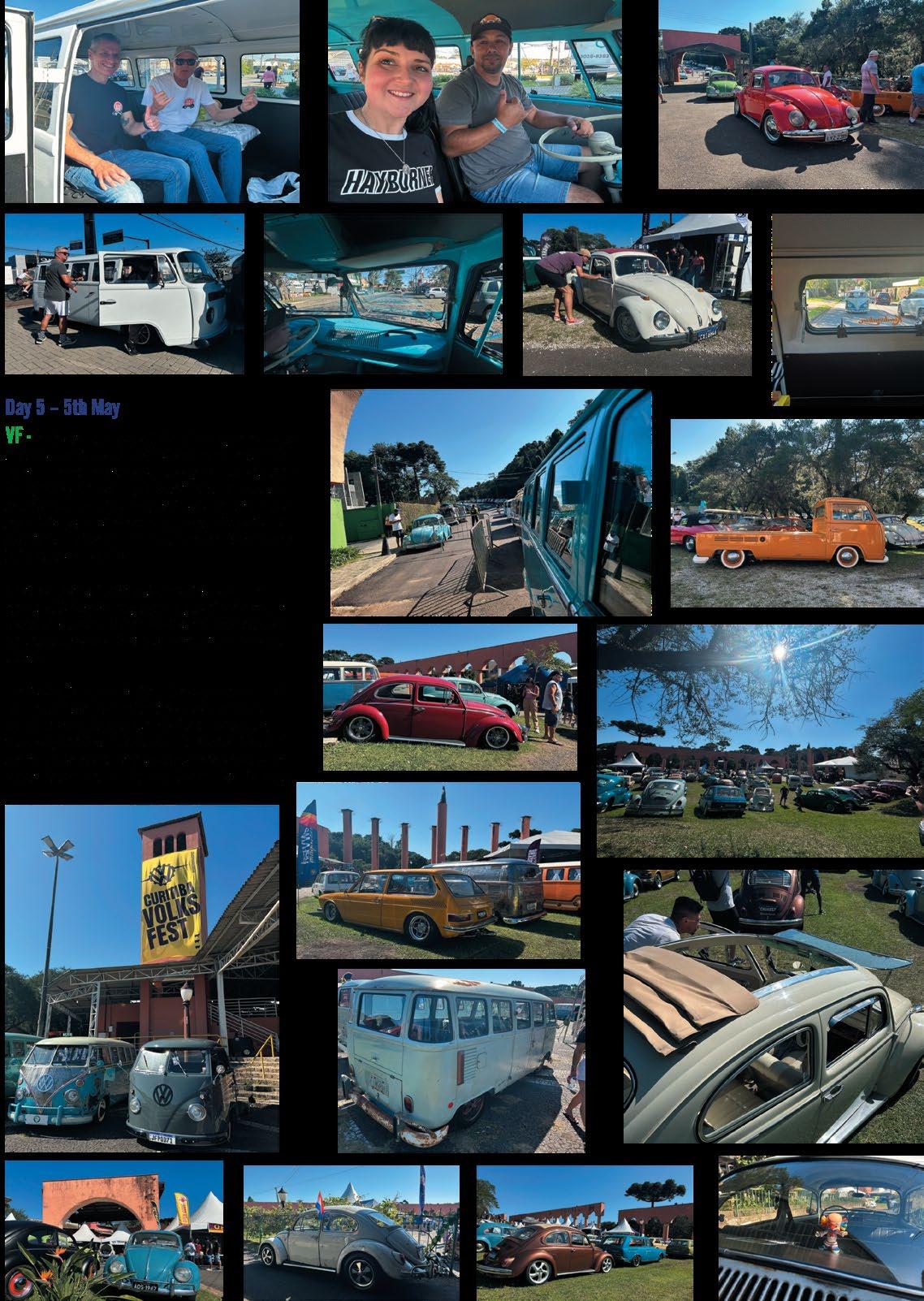
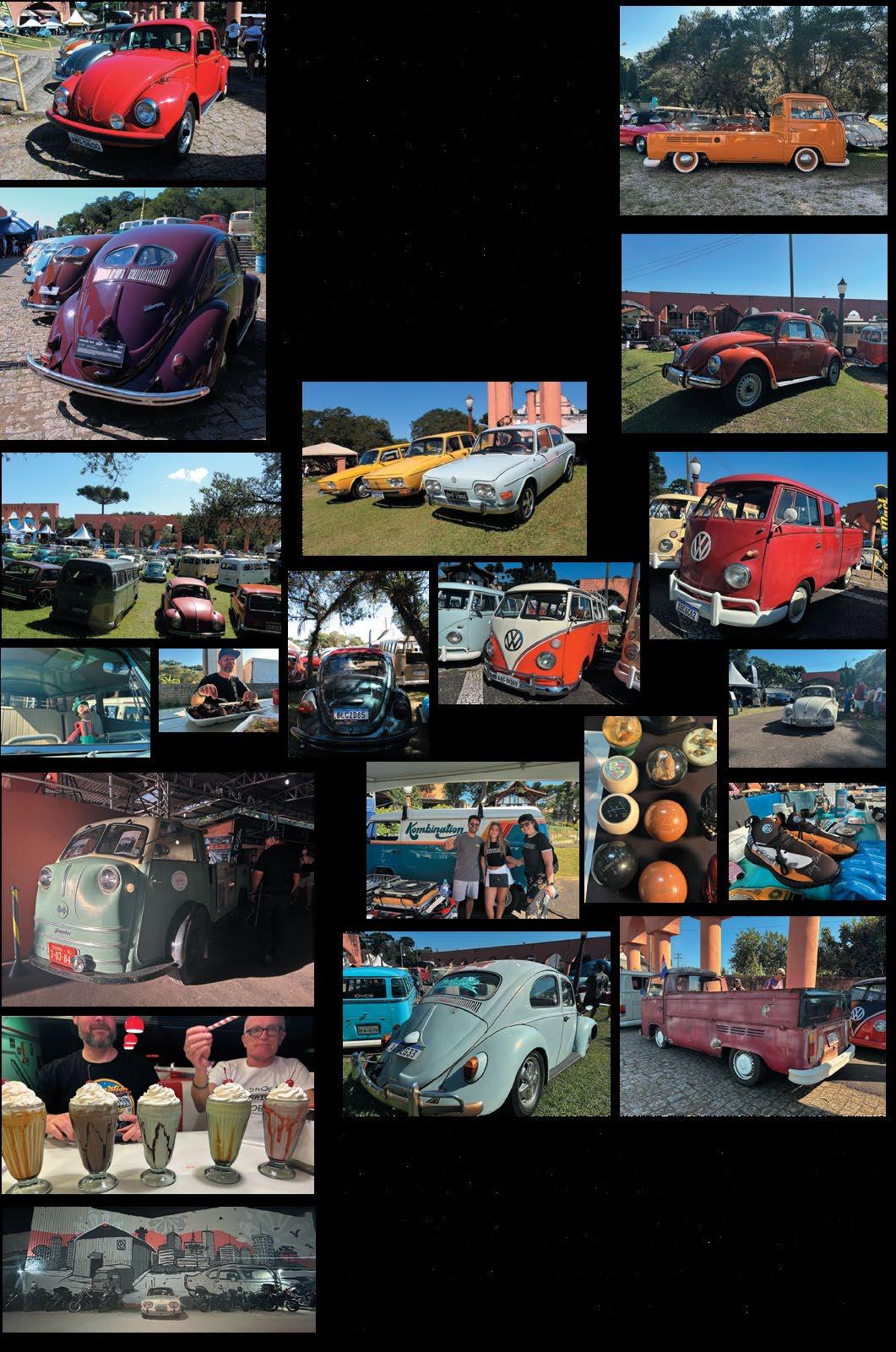

Restoring aircooled VWs since 2001
Servicing, inspections and MOT’s
Lowering and mechanical upgrades
Modification and fabrication
Auto electrics, split charge systems and 240 volt hook-ups
For all air-cooled VW’s and transporter generations
Vehicle valuations
Call for FREE friendly advice
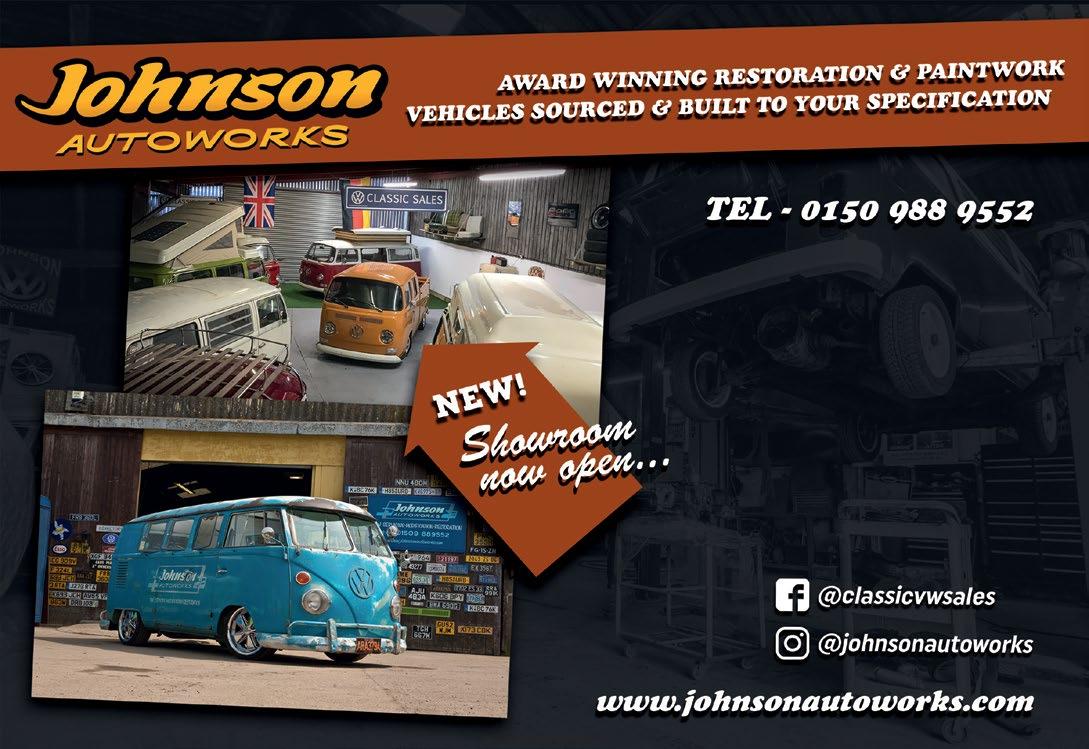


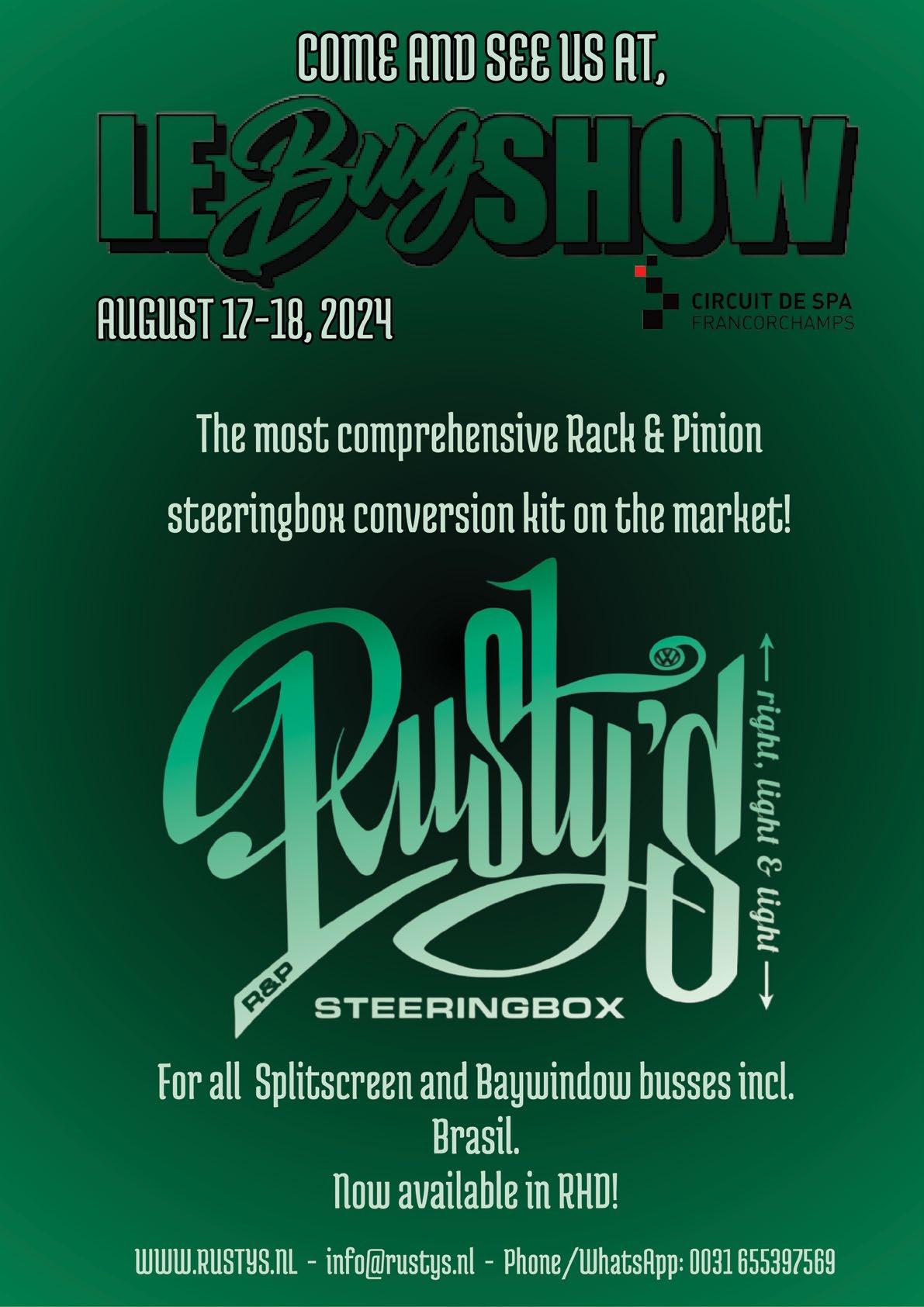

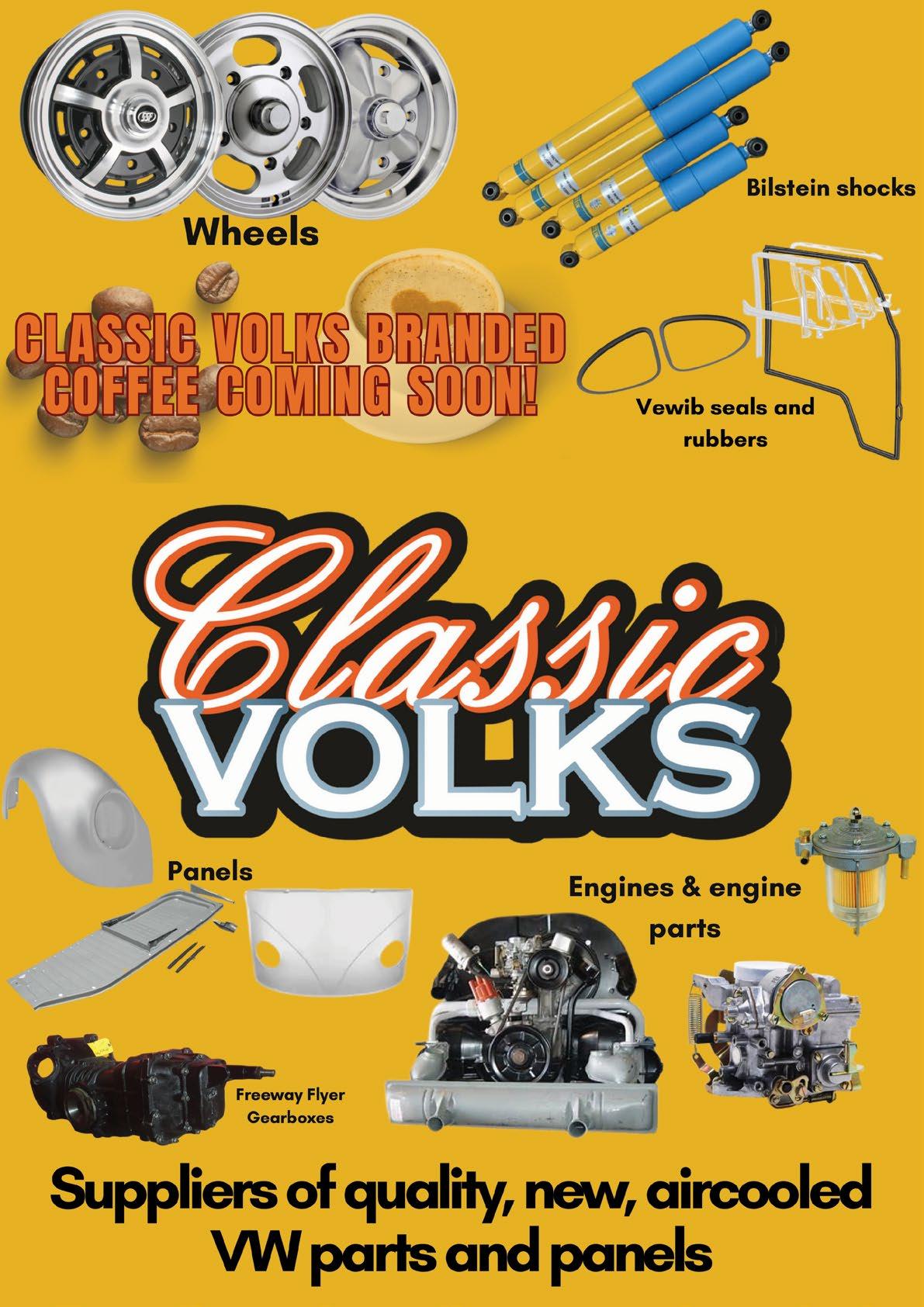
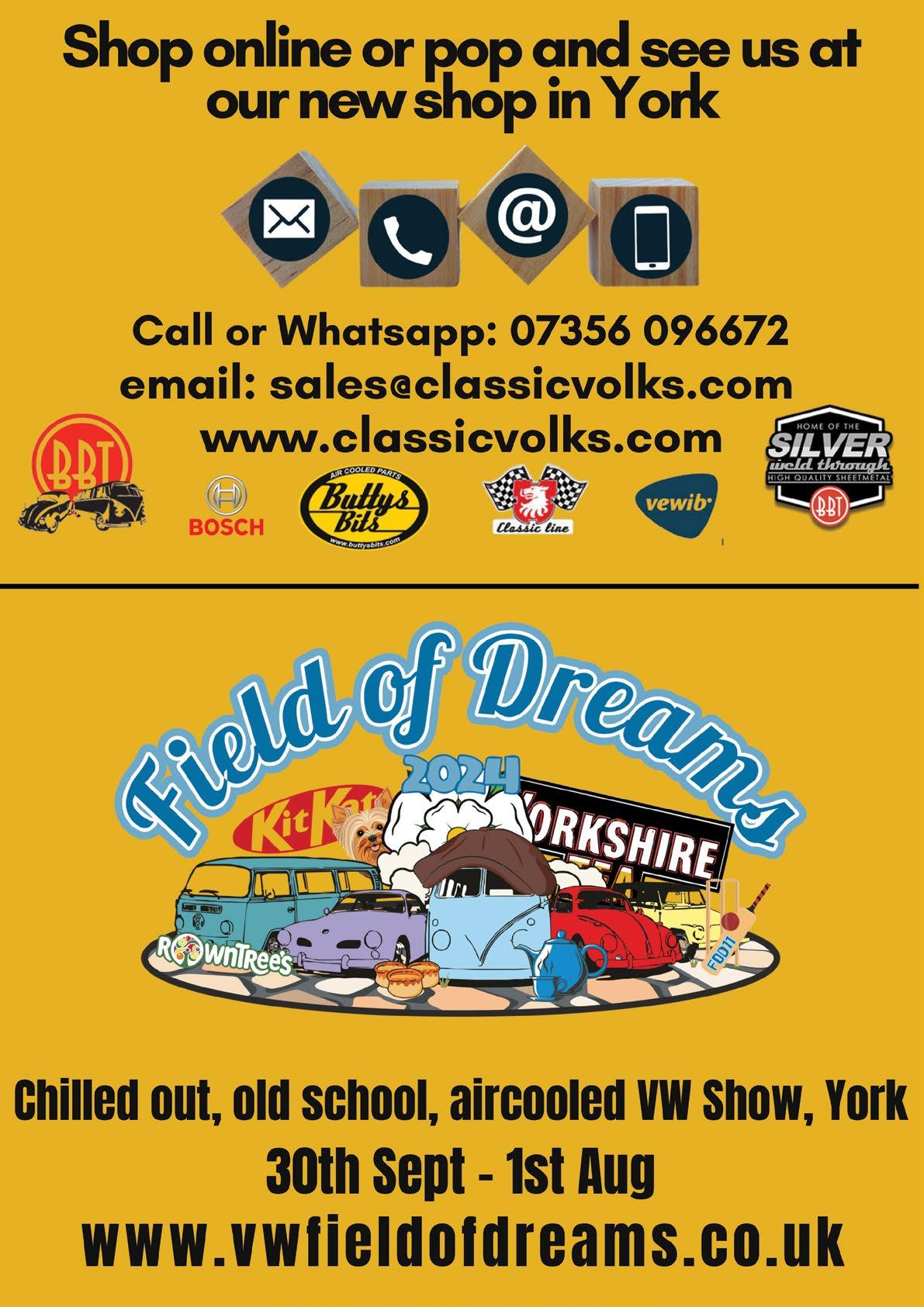


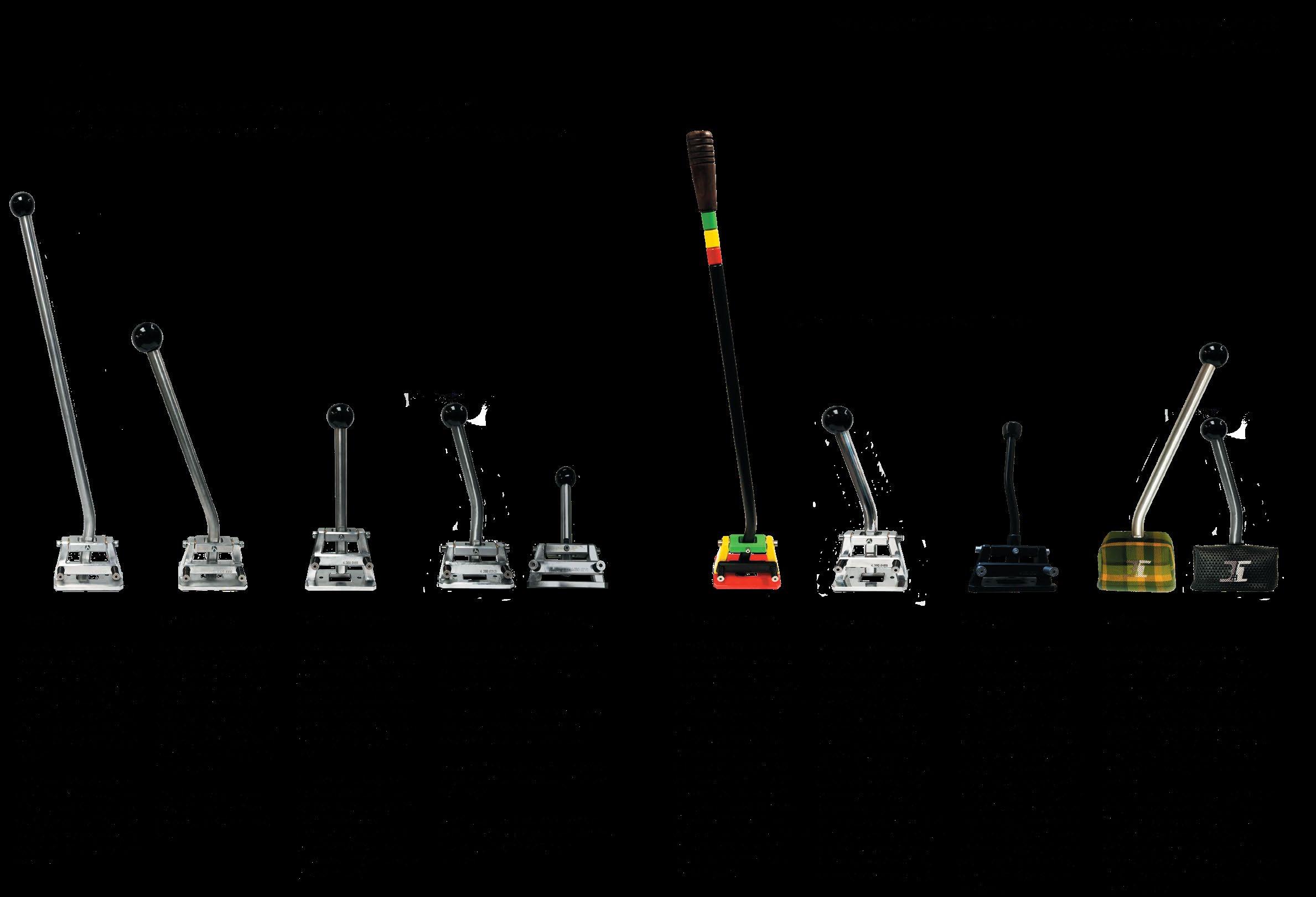

PHOTOS BY NIELS TIMMERMAN WORDS BY AIRMIGHTY MAGAZINE
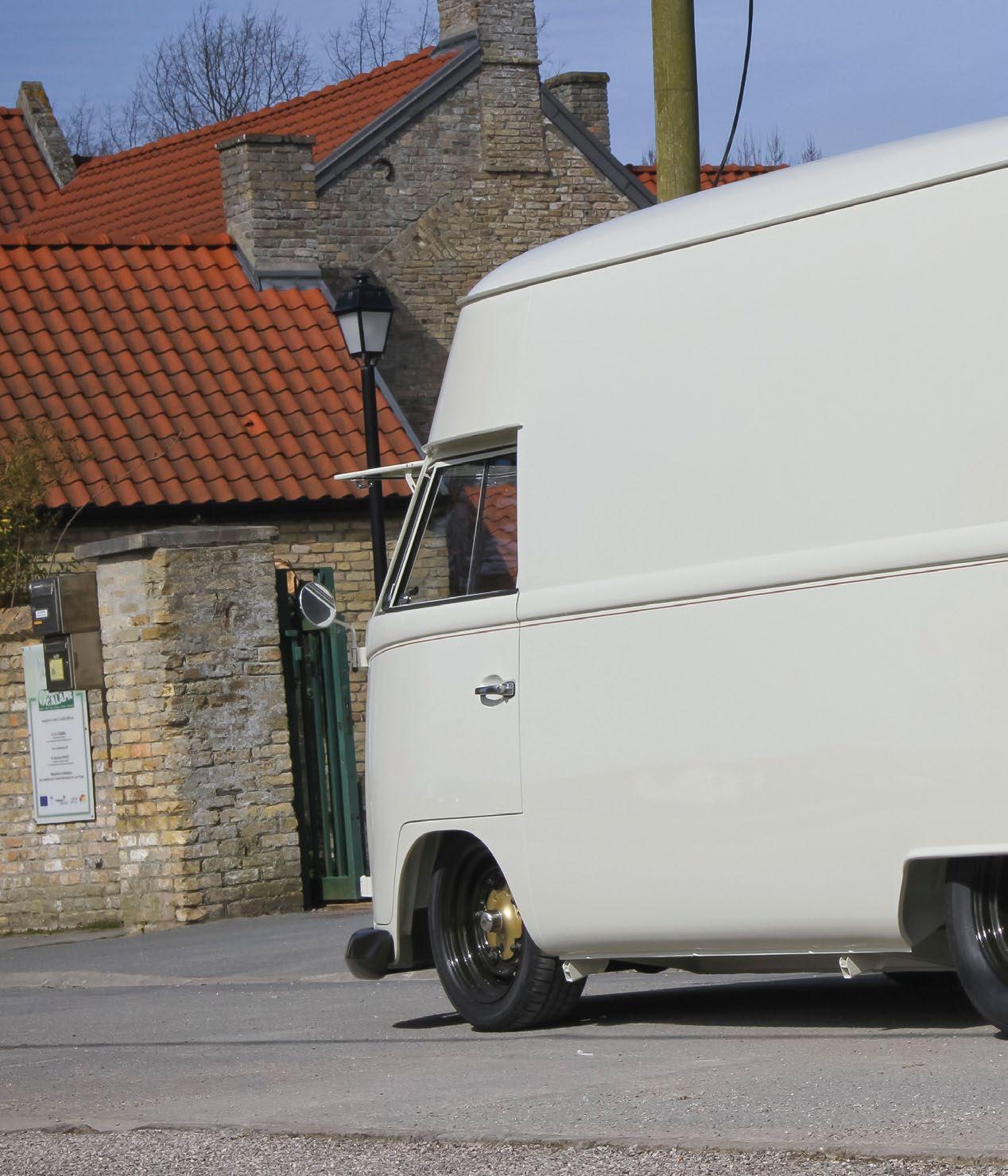
Highroof Panels are pretty scarce. Most of them led a tough working life and simply didn’t survive. This showwinning example that just went through a photoshoot in our in-house studio started out as a light grey workhorse, destined for Portugal.
After having done its duties for a decade or so, it was savagely converted into a hip camper! This involved some
windows chopped into the sides – accompanied by the odd roof air vent here and there.
The Portuguese owners used it for a while until it was merely a broken-down, beaten-up Type2, and then it was simply parked up and abandoned like so many buses were back then. Years went by, and Maurice Klok and Gert Kieft,
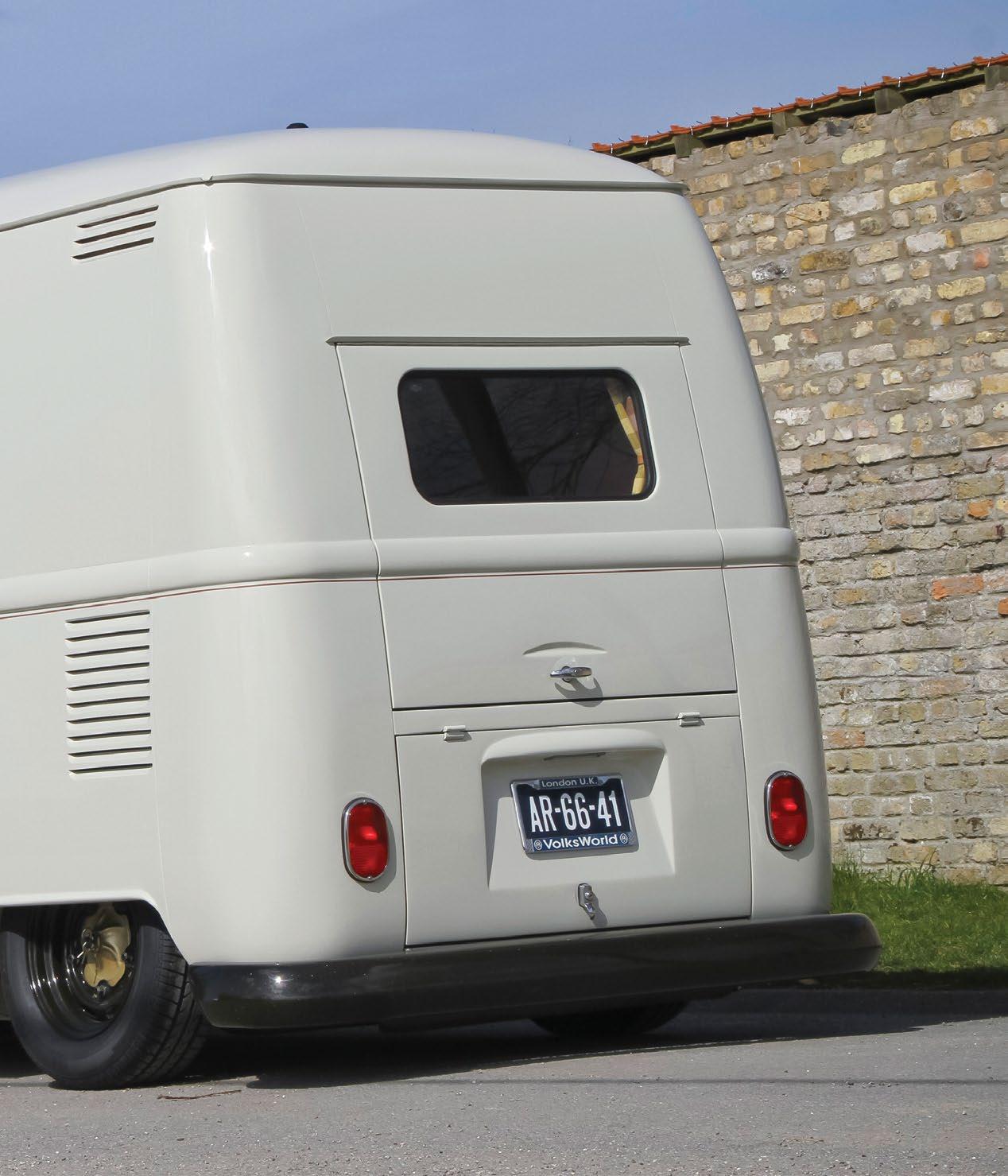

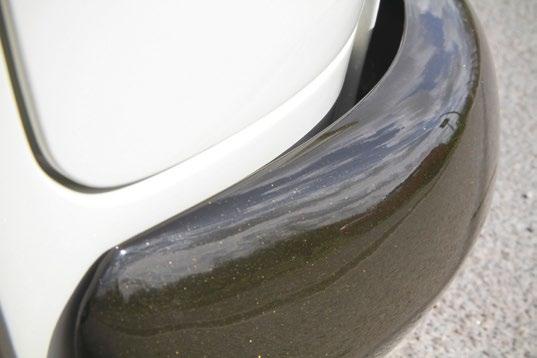
trading company out of Holland, picked up the 1967 Highroof. It was indeed in a sorry state and in need of a complete restoration.
Meanwhile, the current owner of this now fabulous Highroof, Eric van Dooren, was vacationing in

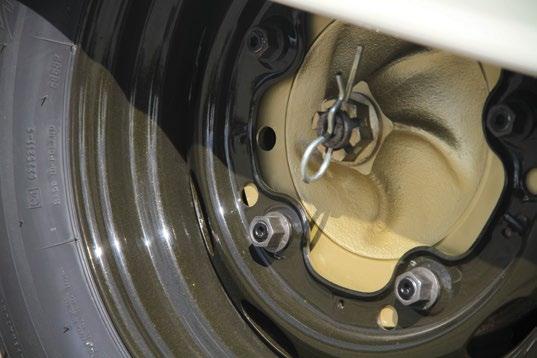
America, having just purchased a nice SO42 Westfalia and enjoying it to the fullest, travelling around and camping with his family. “I had owned an SO42 before and always regretted selling it, so this one was going to come back home with me after our holiday,” said the 44-year-old plumber from Tilburg.
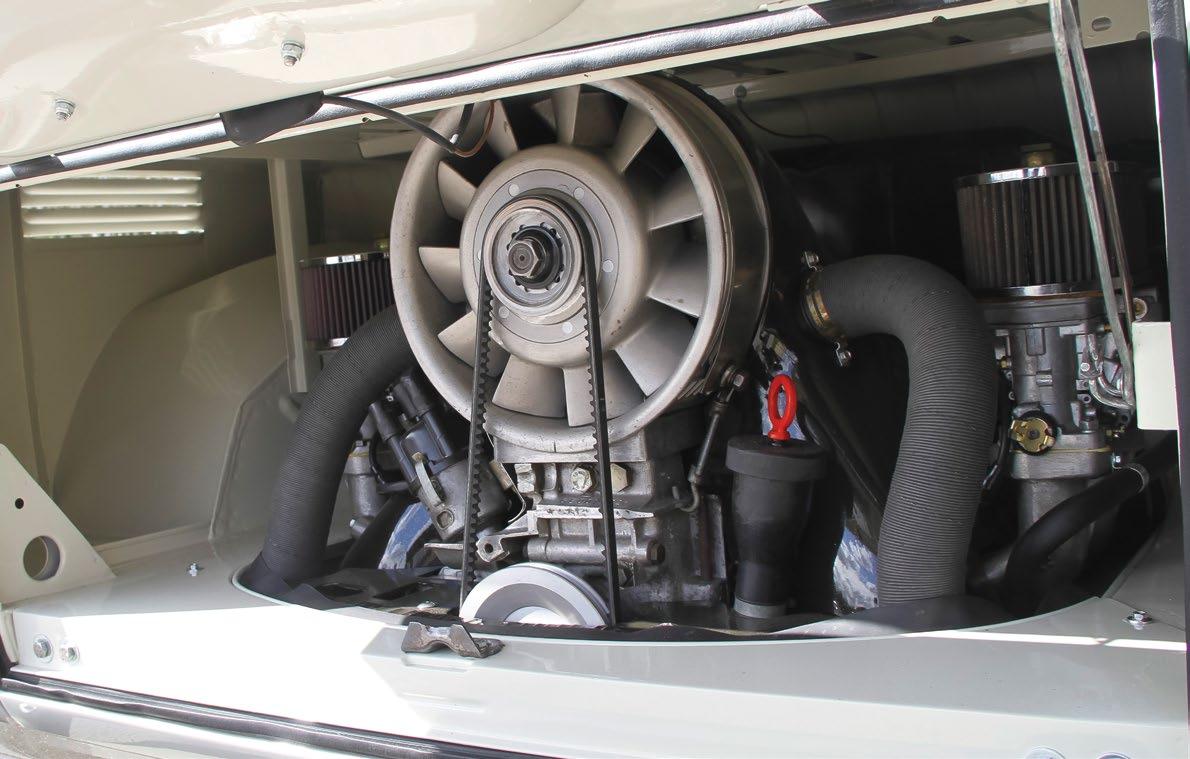

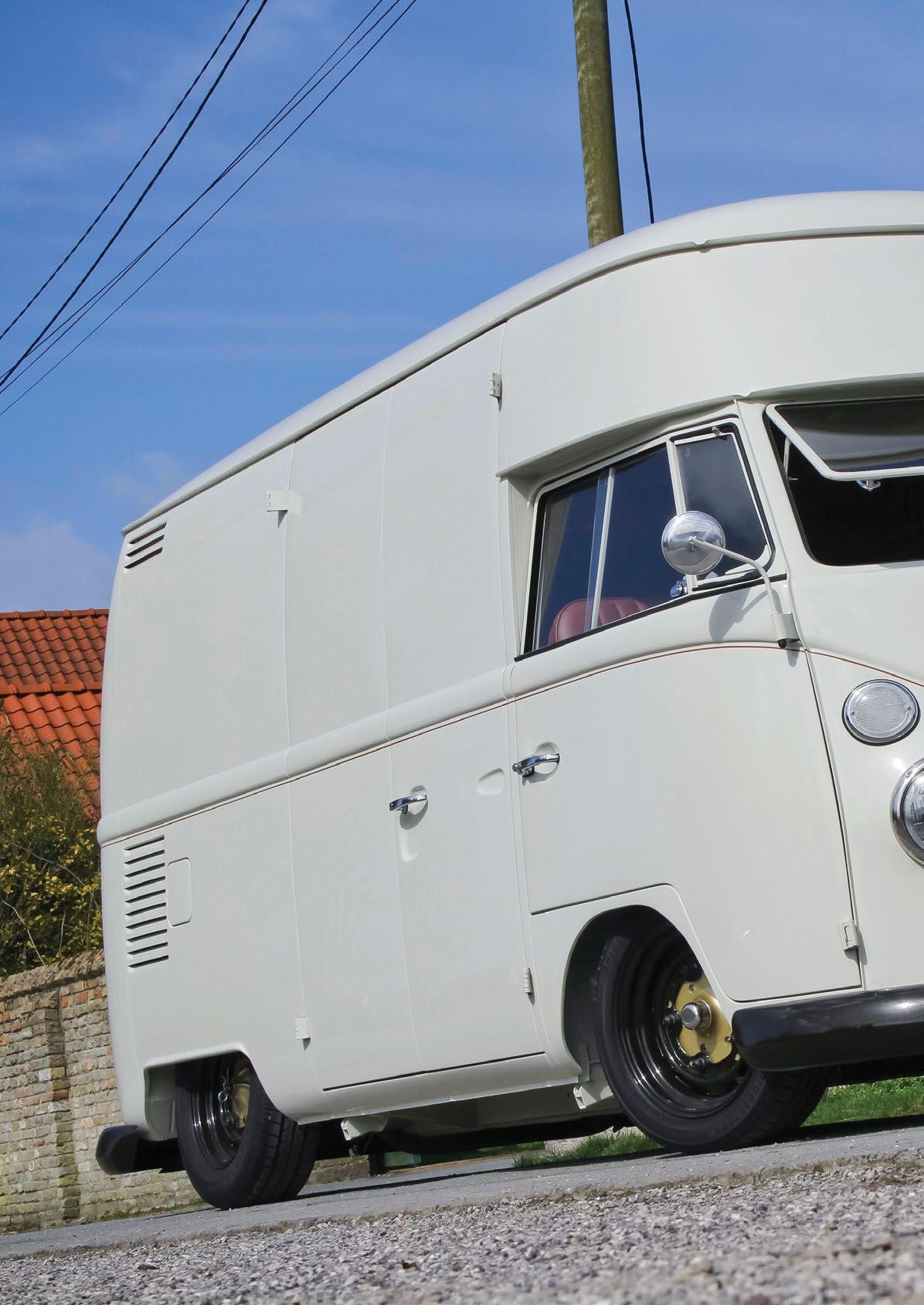
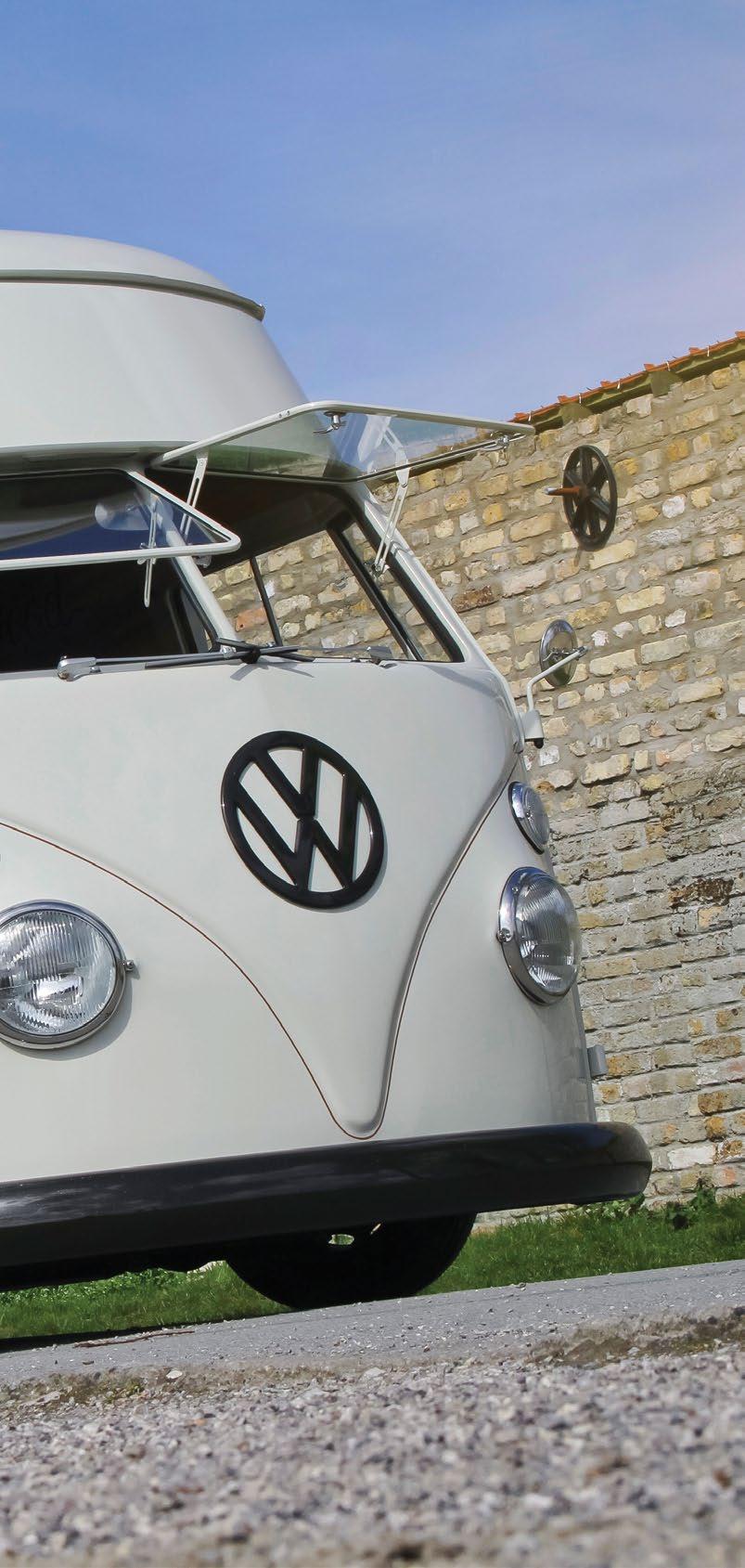
“But, you know how it goes. … I’ve owned many air-cooled VWs over the last 26 years. Oh how time flies when you’re having fun ….” However, once the holidays were over and he’d settled back home, Eric made one of his routine checks on the Kieft& Klok website – and spotted the Highroof, just in from Portugal.
“I called Maurice, and he asked me if I was sure I wanted it, and that I’d better come over and see it in the metal. It was indeed a bad one, even a bit worse than I had expected!”
However, Eric just couldn’t let go of the idea of owning a rare Highroof, and the more he thought about it the worse it got, visualising how cool it would look, slammed and fitted with a nice all-wooden Westfalia camper interior. Several phone calls with Maurice later and he’d done it: he traded his SO42, in good usable shape may we add, although still somewhere halfway out on the ocean making its way back to Europe, for a new and not so small project.
“Being a plumber by trade I’m not afraid to get my hands dirty, and there isn’t much that scares me when it comes to restoring VWs. But my plumbing company does take up a lot of my time so I knew I wasn’t going to be able to do it all single-handed. Luckily I knew the right guys.” Having stripped the Highroof of everything, he took the bare shell to his friend, Maarten van Geet, who’s an excellent metal craftsman.
With the help of a shed-load of Autocraft sheet metal, he performed his miraculous work and welded up the bus. He even made the large side panel himself because you simply can’t get one for a Highroof.
“I knew from the start that I wanted Andy Finch of Spike’s Vintage Restorations to do the prep and paint; there’s simply no one better in my opinion!”
We’ve featured several cars he’s had a hand in here in AirMighty, and we have to say that Andy’s a god with a spray gun, the master of mile-deep paint! “Over the years I got to know Andy, and he became a dear friend of mine, and so for
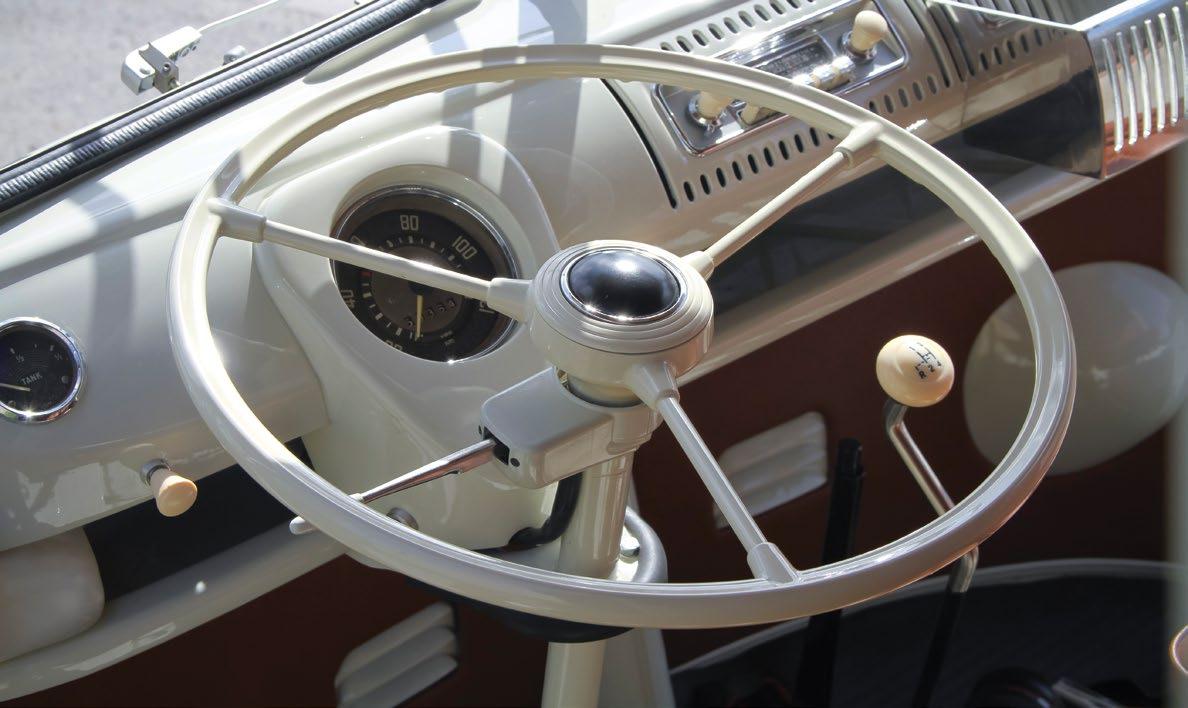
me it was a no-brainer to ship my bus over to the UK to have him do the paint there,” said Eric.
By now it was quite clear that this was not going to be an average build of an air-cooled VW, and while the Pearl White paint was drying, Eric got his buddy Marco de Waal, our own Mr Techtip and head
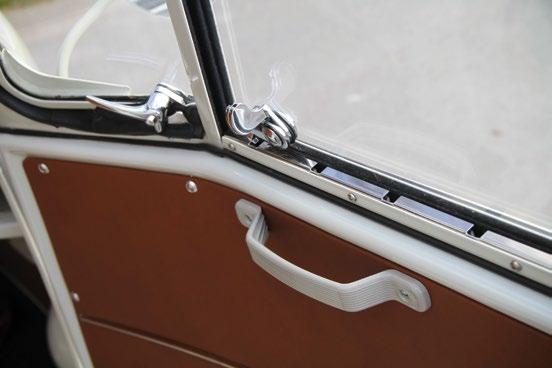
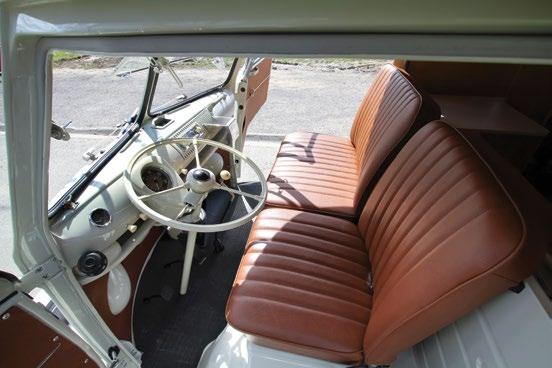
honcho of MarCo Supplies, to give the running gear some serious consideration. Marco came up with all the ingredients to sort out the all-important stance, and while they were going through the suspension and brakes, Marco was offered a Beetle built in the ’80s. “It was one of those forgotten cars from a few decades ago, but it had a fresh Willibald engine!” This


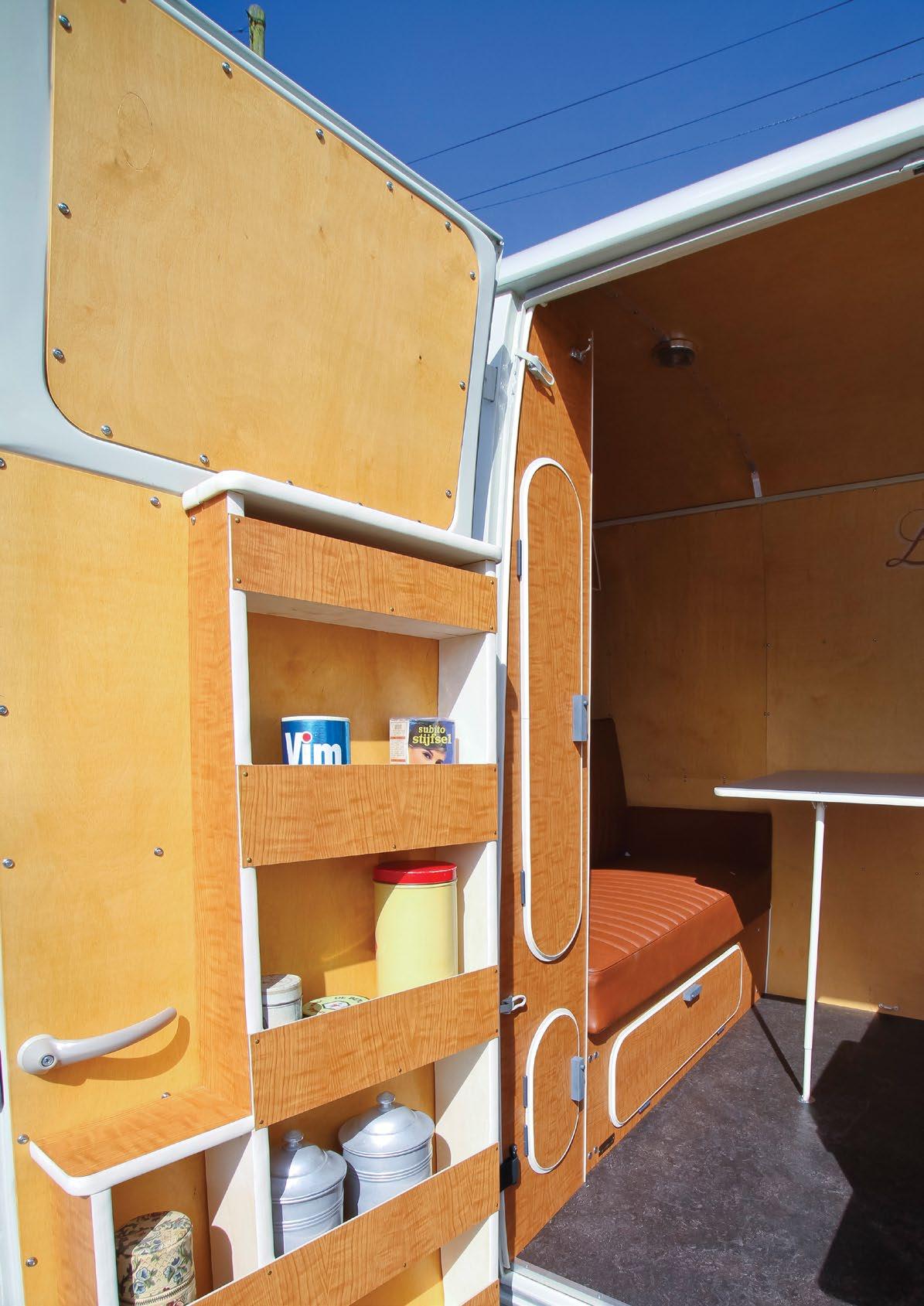
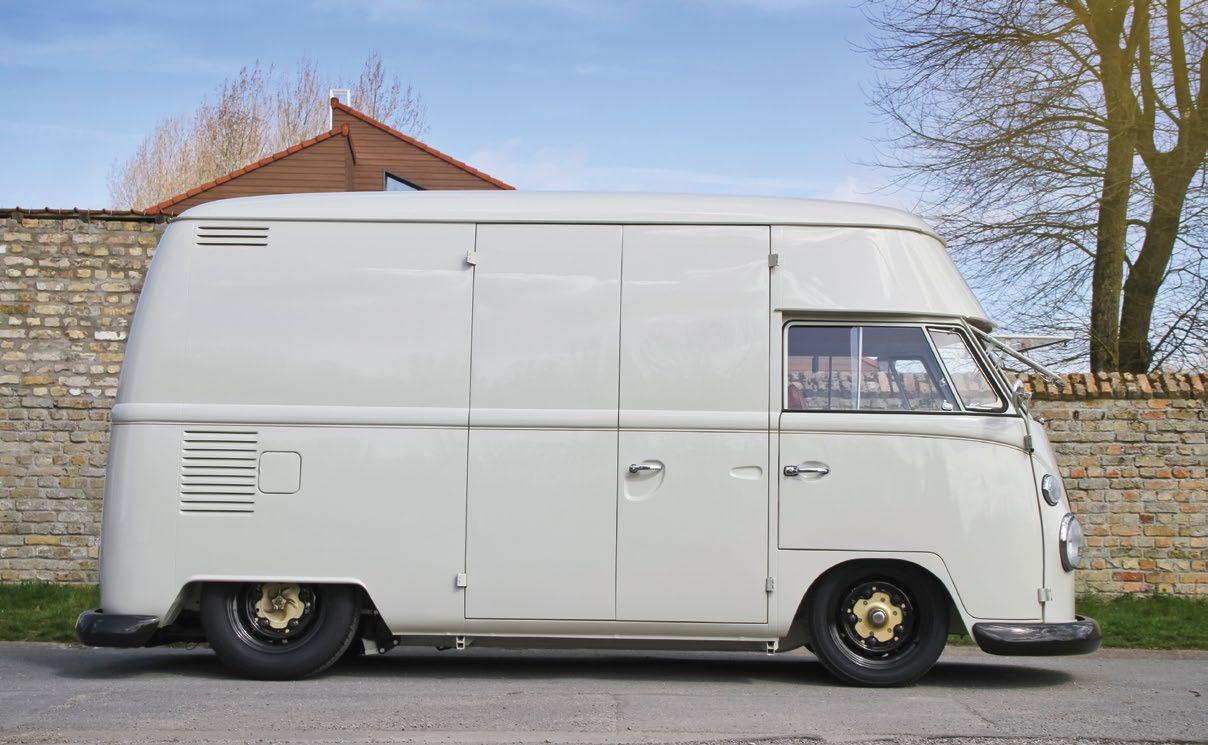
was a 2.4-litre Type4, built back then with a Porsche 911 cooling fan and all the bells and whistles on it. All it needed was to have the fan shroud painted to match and a cool exhaust fitted.
By September, Eric had picked up his bus from Andy,
and he was more than thrilled with the result. VolksWorld Show: the deadline was set! All that remained was to piece it back together. But then in November Eric bought a new warehouse for his plumbing company, which was bad timing to say the least. Busy with relocating the company,
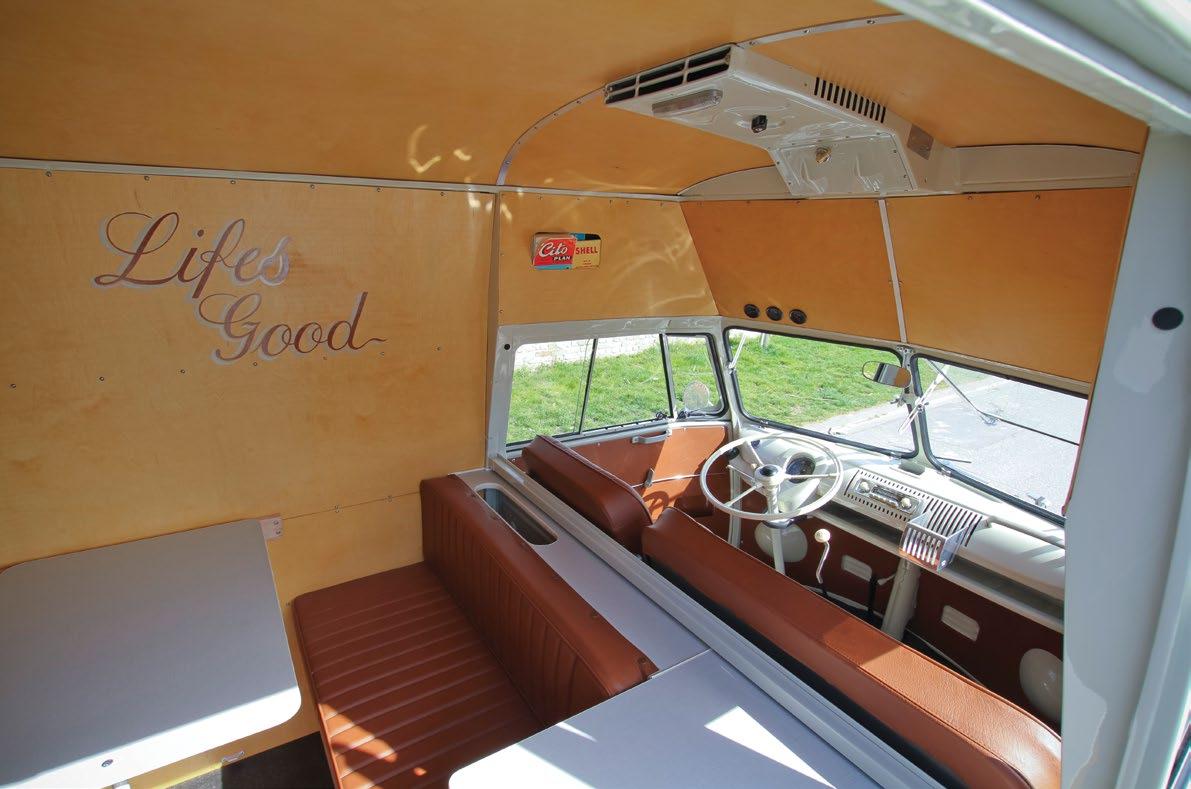
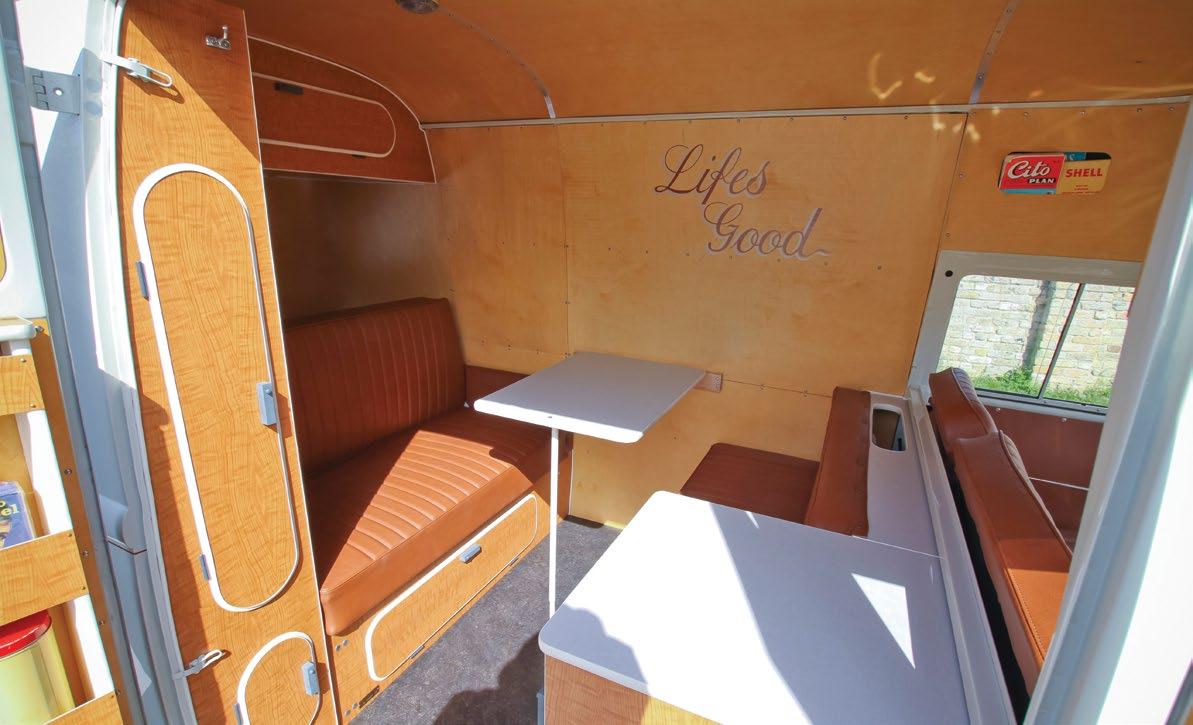
Marco was put in charge of assembling the Highroof: “I could have done it myself, but it would have probably taken a year longer.” Another Dutchman was called in to work on the project: Marcel Miller, the man for custom upholstery! Out of the Miller Kustom Upholstery workshop came a gorgeous
chocolate-brown interior. Now Eric wanted to have a camper interior, and the best guy for that is another Dutchman, Ruud Rams, who’s perfected the art of making brand-new Westfalia interiors that are virtually undistinguishable from the real deal. An interior for a Highroof was a new challenge for Reprowesty. “The
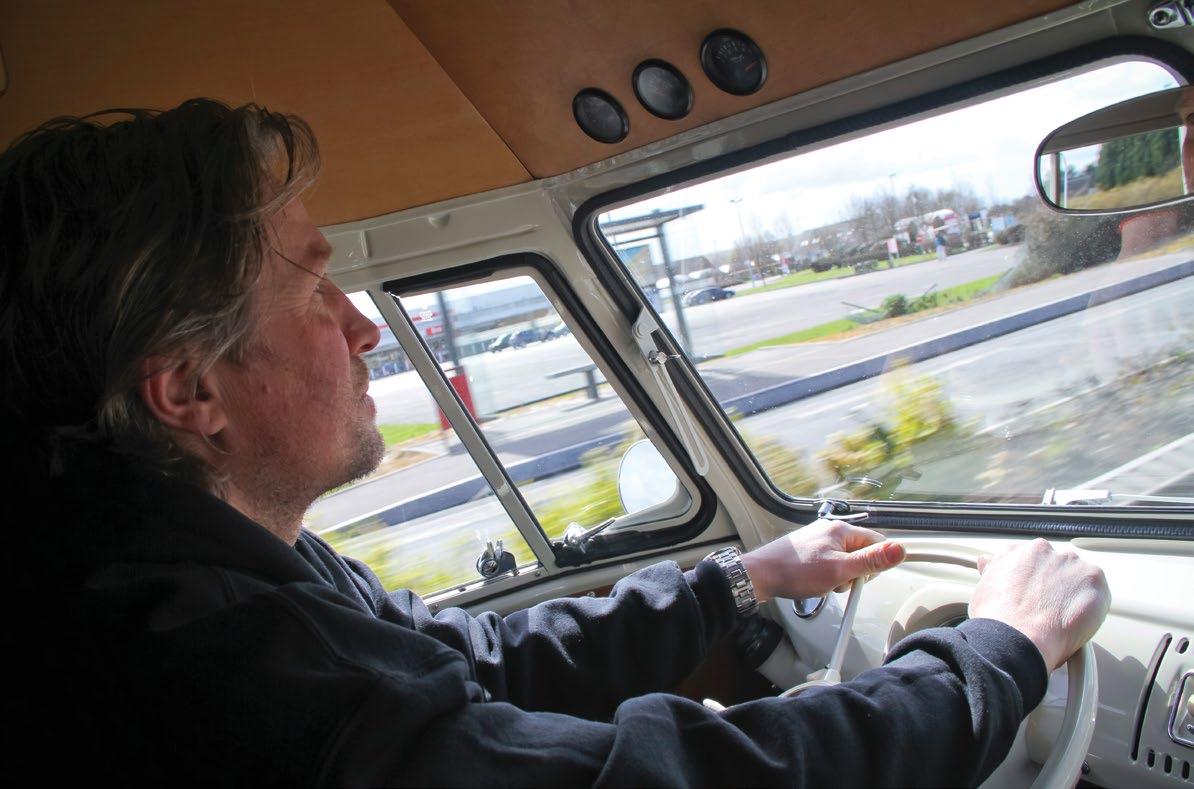

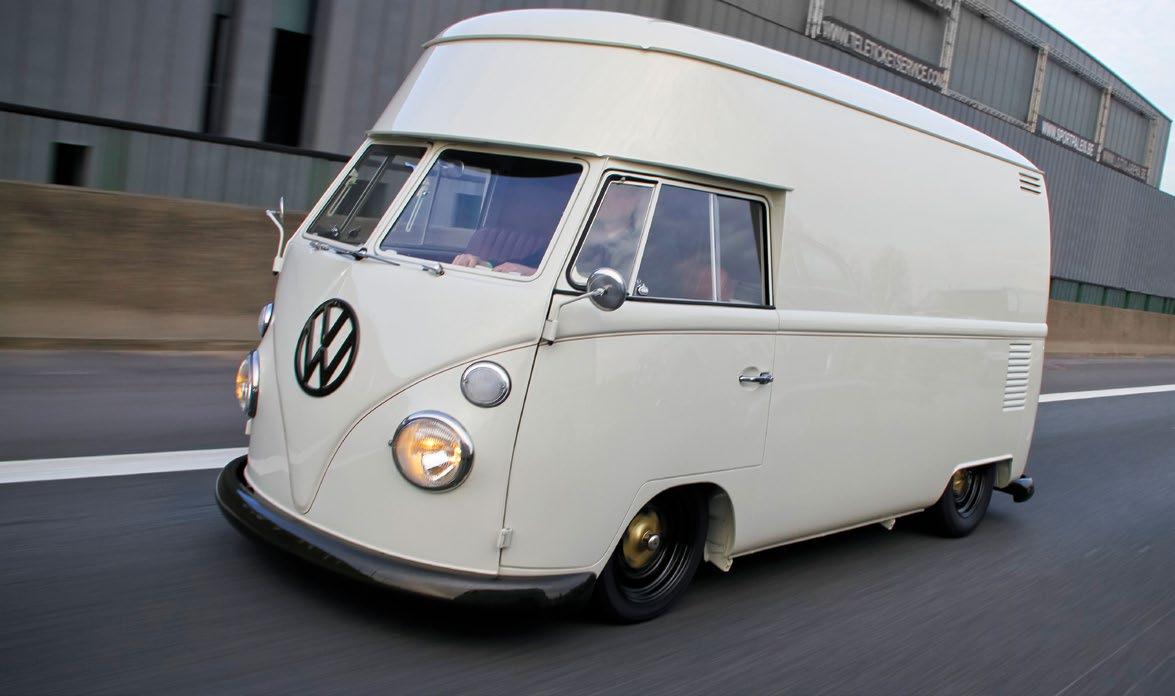
result is just amazing! It’s exactly how I’d envisaged it.” The VolksWorld Show deadline drew ever nearer, but Marco had achieved his part of the job with three weeks to spare, and Eric took his bus home and spent the next two weeks sorting out the last little things. A few days before the show he took it back to Andy for a final pre-VoWoSho paint buff, and Simon “Nefarious”
Pollok RIP applied a hand-drawn chocolate pinstripe beltline: it’s all in the detail! The result was a welldeserved VolksWorld Show Top20 Award. What else did you expect?

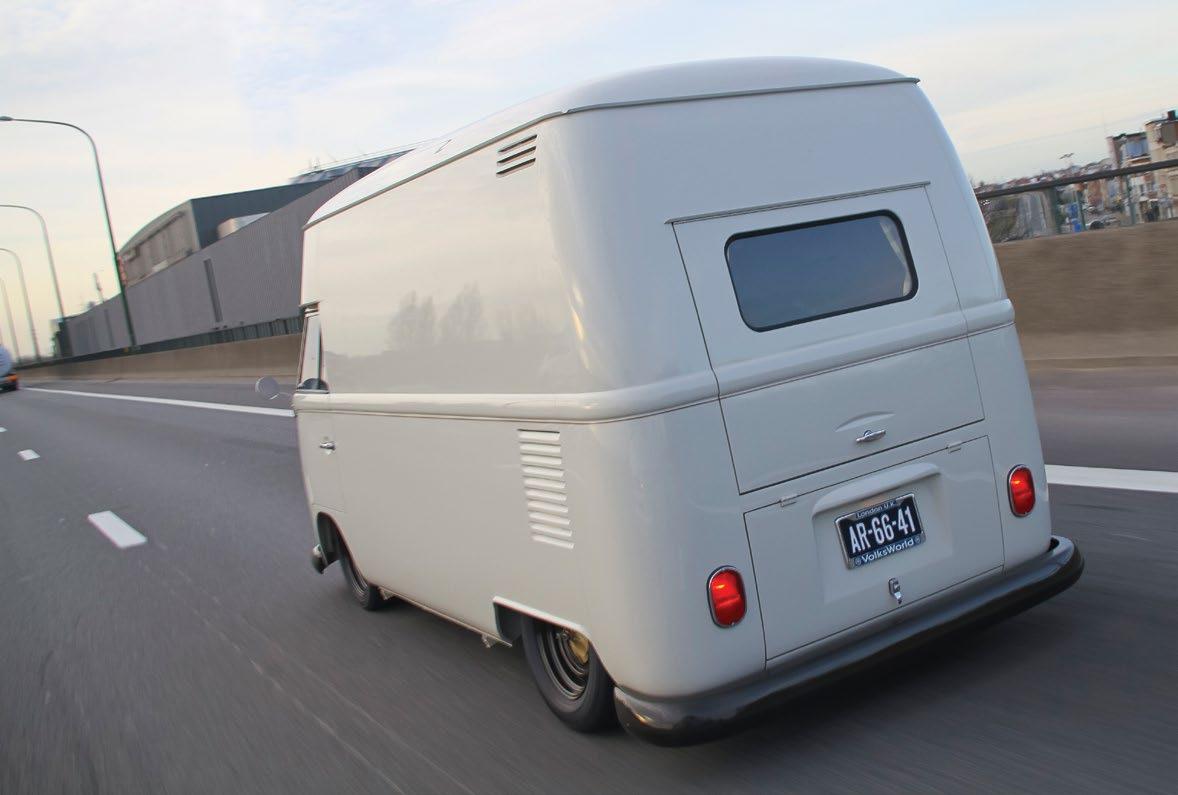


WORDS BY CHEZ WILLIAMS
I have just returned home from a very long weekend. I’m sat in my workshop in something of a daze, wondering what happened. How time passes so fast when I’m having fun has always amazed me. I’ve been at a festival that I attend every year called Boomtown. It’s not that far from me in driving terms, but it’s like stepping into an alternative reality for a few days. I can still see flashing lights when I close my eyes and have permanent drum and bass music pounding around my brain. I’m sure I will eventually land in a few days’ time, but at the moment I’m still in festival mode. Lack of sleep and many miles of walking and dancing have taken their toll on my body, but every year I return because it’s always my favourite thing to do.
This year, however, was very
the years I have been to many chapters of Boomtown, starting in 2012. I have also taken a lot of different vehicles there. The Kemperink went first and sunk up to its axles in the muddy field. Ned was kind enough to lend me Canada Dry one year when I was without a bus. I have taken a T4 and even my Land Rover Discovery with the back seats all folded down to make a dwelling. This year, however, it was time to try something new. I’m going to be honest and say that as I’m getting older I do envy people who have a well-kitted-out camper and an array of creature comforts.
At the beginning of the year, my friends Ben and Mo decided to let go of their trusted T4 motorhome. It’s a 2.5 TDI on a W plate (2000) with about 90,000 miles on it. We have always called it The Iceberg
always had a real soft spot for it. Never having owned one in my life, I have nevertheless loved the idea of a motorhome for quite a while, so after a little bit of negotiation we settled on a price and I was the new owner of something I knew very little about. Left to my own devices I have naturally gone for the double mattress on the floor conversion and all my clothes in a bin bag. Having a proper bed and wardrobe was very exciting.
Ben and Mo live quite a long way away from me and I was holding out for a lift with someone who would be going that way. This never materialised, so in the end Ben drove it to the Volksworld show and I collected it from there. I was given the full tour in the car park and wish I had paid more attention to what all the switches did and how to get things working,
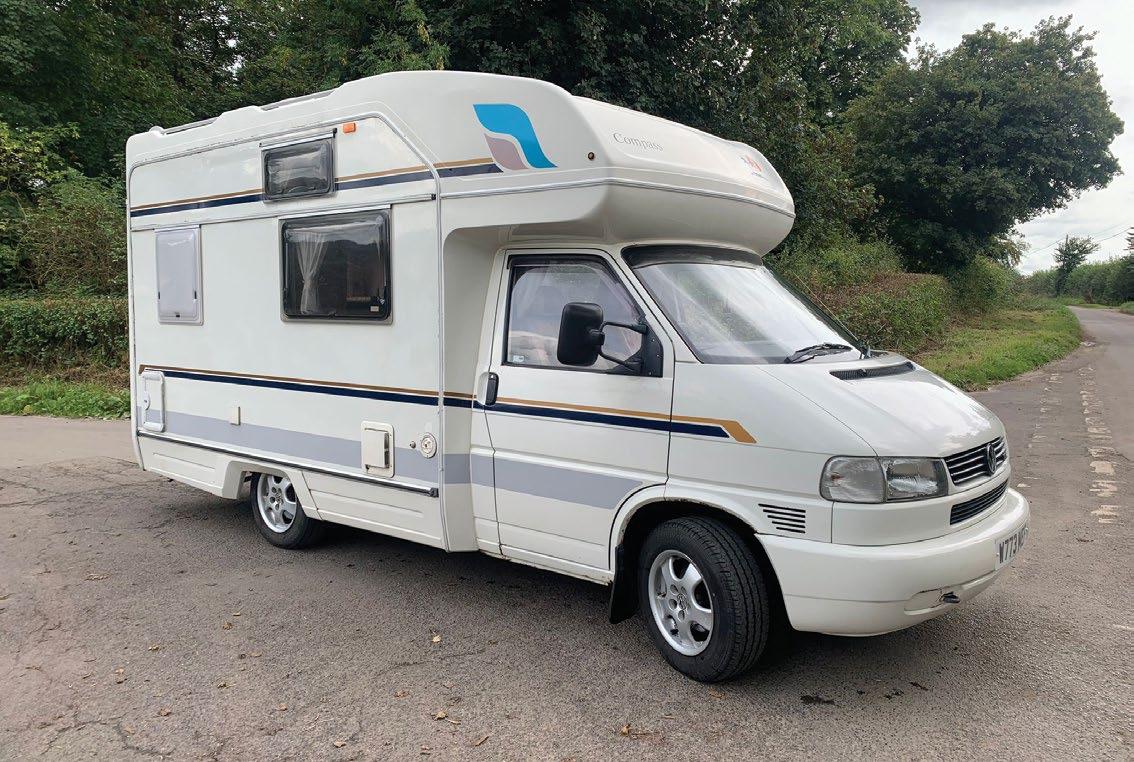
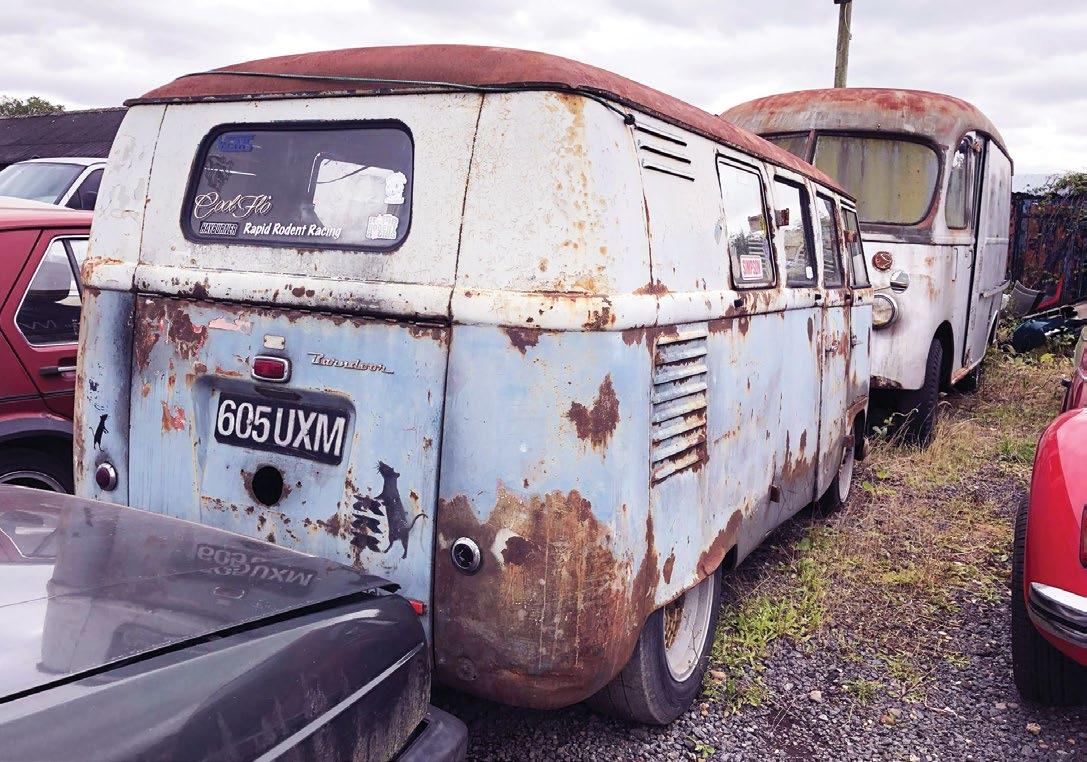
working out a puzzle. The drive home was a great experience. The motorhome has heating and doesn’t steam up the windows; it’s quiet and comfortable and a wonderful place to be. It ticks along happily at 70mph and was really good on fuel. This is a new world for me and I have to say it’s a very different experience from driving a Split or a Bay.
Leaving for Boomtown this year was a bit different from most years. I filled up gas bottles and the water tank, filled the fridge with food and drink, stocked my cupboards with condiments and brown sauce for bacon sandwiches, and plugged the motorhome into the 240 electric the night before so when I set off the fridge was cold and the leisure battery was charged up. When we arrived and set up it was so easy and convenient compared to my previous attempts that I decided I have fallen in love with my Iceberg and hope to have many adventures in the future. The other festival I went to was Shin Dig, which I hadn’t been to before. I really enjoyed it but it was a very wet festival. This is where the Iceberg came into its own.
Having a shower and a toilet was a game changer – no more walking through the mud for a pee in the middle of the night, and a hot shower to get clean before getting into bed. It still sank up to its axles on the way out, but at least we could have cups of tea and bacon sandwiches while we waited for the tractor to pull us out.
The workshop has been quite busy with more 1776 engine builds and a few broken beams to repair.
The 1776 is a build I have been doing for a Beetle, and with an Engle 110 with ratio rockers and twin carbs I think it will be fun. We have had a small issue I thought I would share: the customer wanted us to fit an external oil filter and possibly a small oil cooler as well. He wanted a CB Performance maxi 3 pump with the oil in and out as unions on the pump cover. We ordered one up and it came through in a few days. The pump was in its original plastic packaging with cardboard backing, so it was easy to see it had not been messed with or opened at any time.
We opened the packaging to install the pump and check it for clearance. As we looked at
it we noticed it was missing the usual hole where the oil goes to get back into the case. It looked funny and I really started to question myself. Then I looked at the gasket and saw that the gasket had the hole in it that I was expecting to see on the pump. It was just a stock pump which was not going to work as intended. The packaging being fully intact when it arrived leads me to think that this was an error at the factory. I got the pump replaced with my supplier so it’s not been an issue in any way, but it was something that could have been a right pain in the ass had it not been spotted.
Tomorrow I’m packing to go to one of my very favourite VW shows. It’s that time of year when I’m really excited to be going to Revesby Country Park in Lincolnshire for the Viva Skeg Vegas Classic VW Show. I have been many times and always enjoy it immensely – wonderful people in a beautiful setting and terrific fun in so many ways. It will be just the chill I need to get over a manic Boomtown.

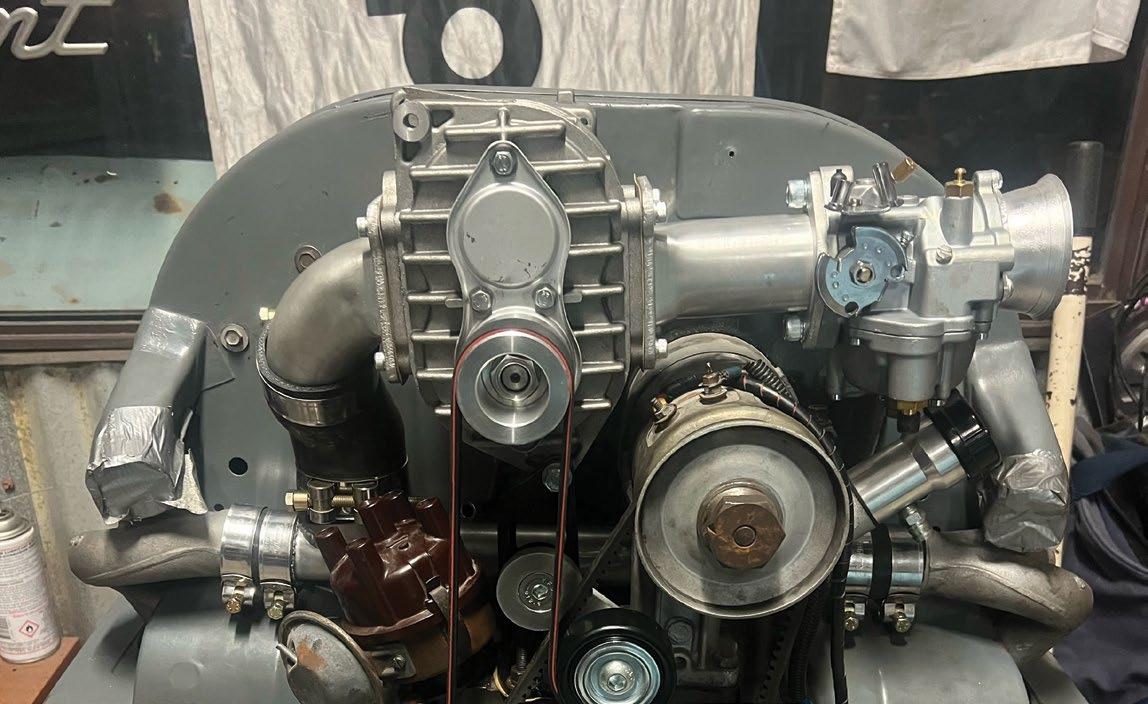
n Superchargers
n Superchargers
n Camshafts
n Camshafts
n Ignition systems
n Ignition systems
n EFI systems
n EFI systems
n Twin-spark kits
n Twin-spark kits
http://joeblow.me
http://joeblow.me
blowjobs@joeblow.me
blowjobs@joeblow.me
WANTTOADVERTISEHERE?PLEASEEMAILadvertising@hayburner.co.ukFORDETAILS

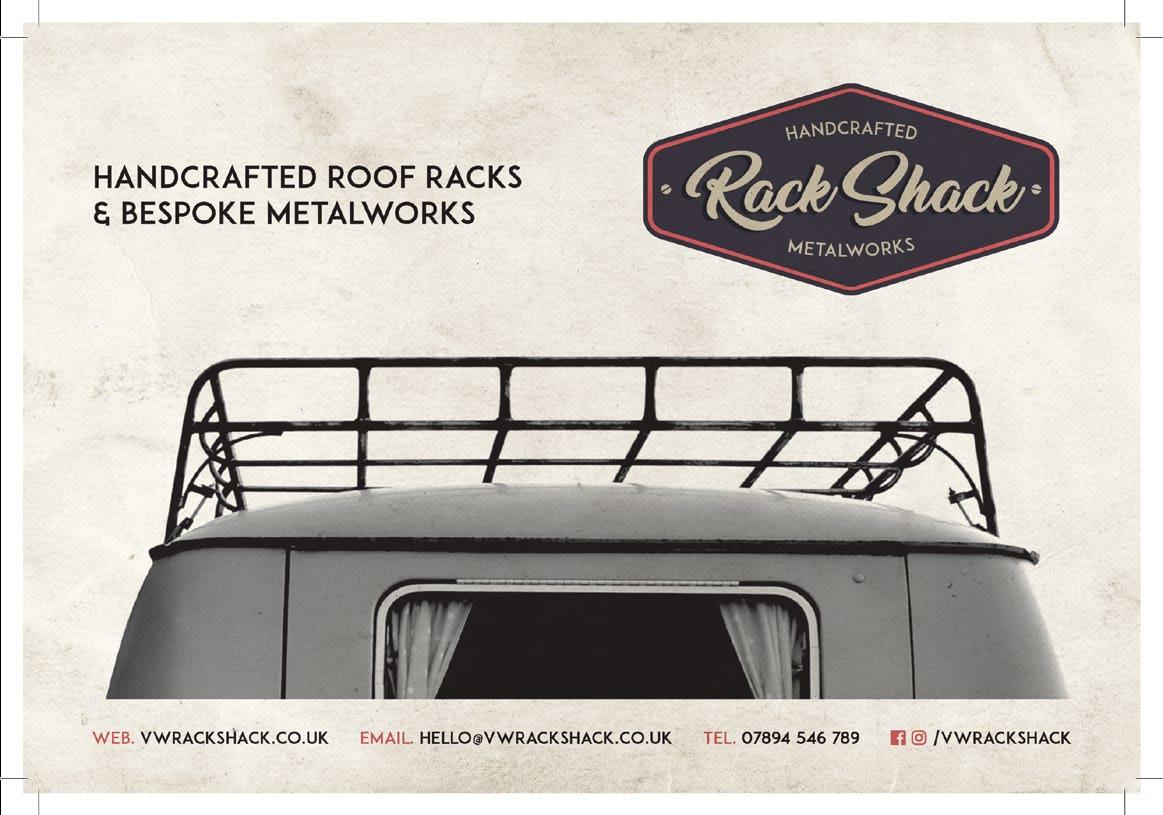

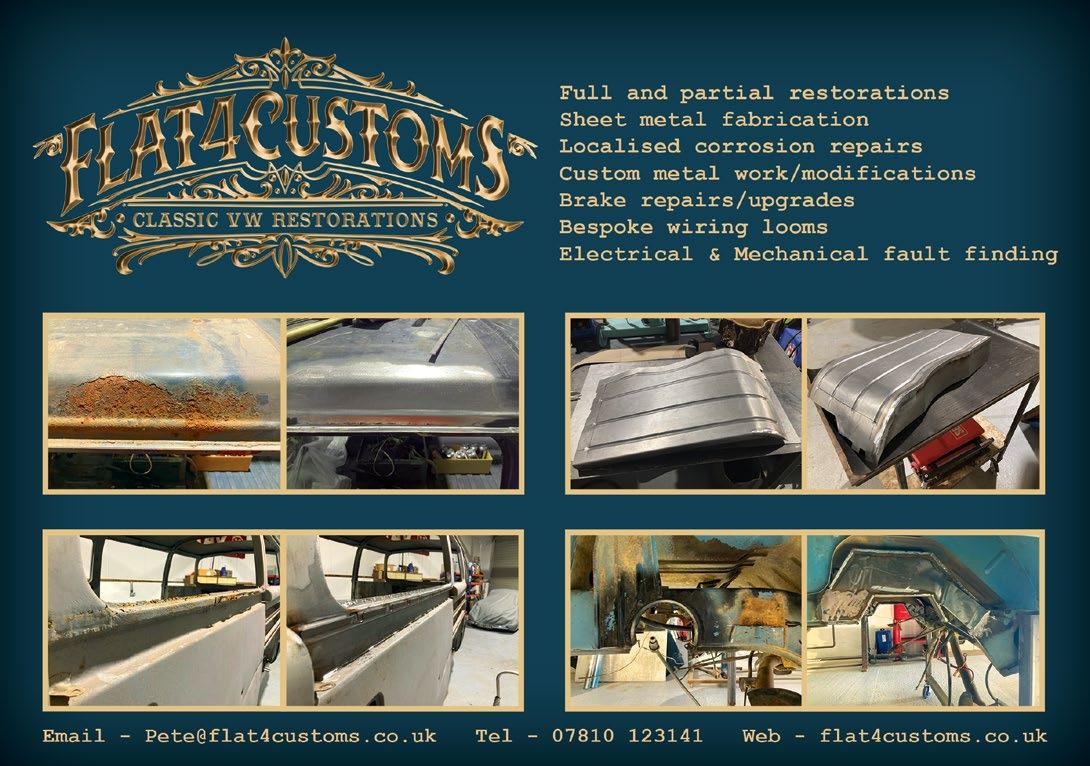

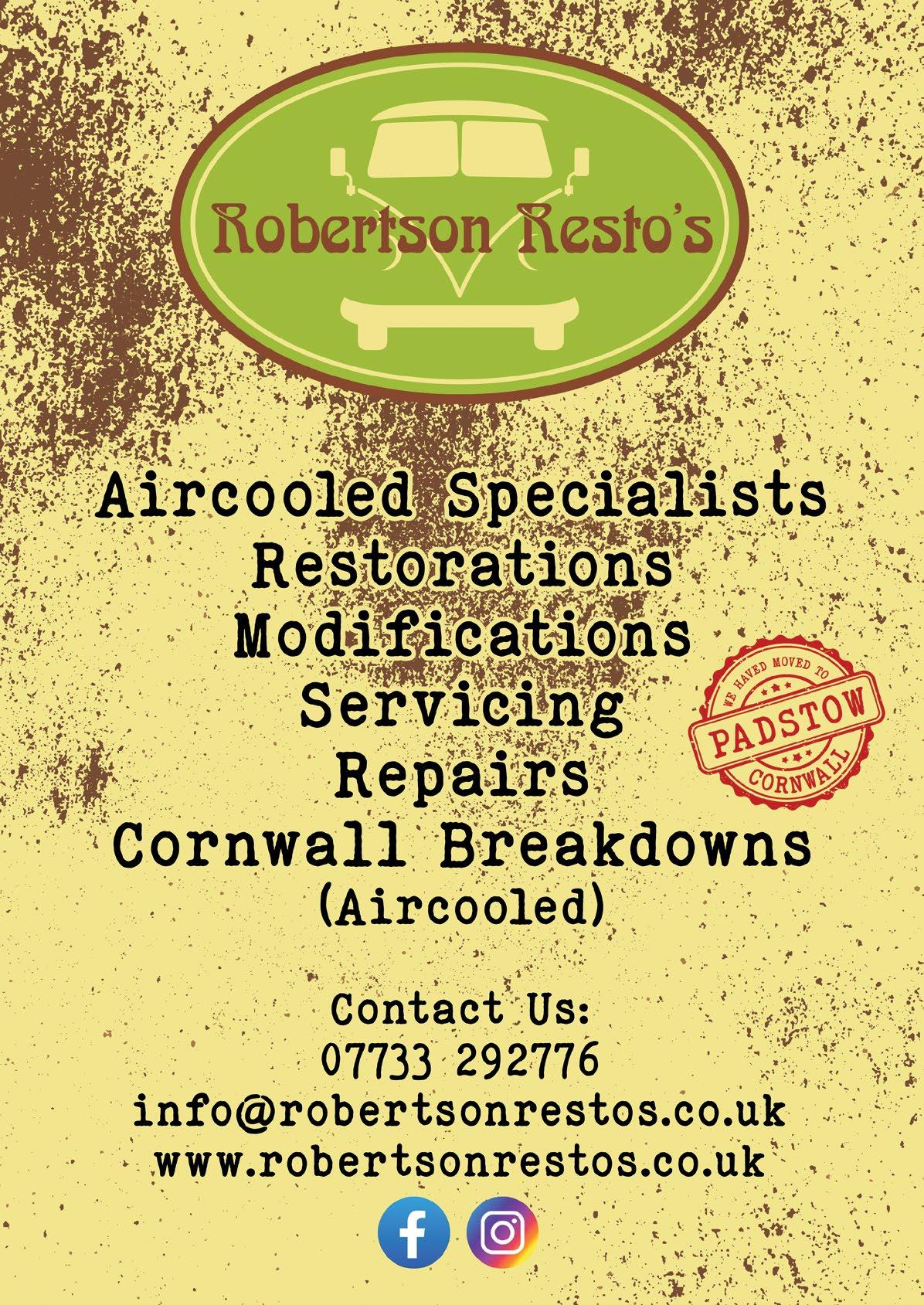

PHOTOS BY JAMES RUDLAND WORDS BY ADRIAN AUBREY
So it all began in February 2015. I’d been driving my supercharged Mini Cooper S as a daily for three years, and while it was an ok car, it wasn’t a classic and wasn’t putting a smile on my face in the way that only a classic can. (Cars are so much more to me than a means to get from A to B.)
I’ve run classics as dailies before – MGB GT V8, classic Minis, MG Midgets, TVR3000M, Mini Mokes, series 1 MX5s, MK1 Escort Mexico and RS2000, VW buses, that kinda thing – but they all had shortcomings. So I set about looking for the right kind of car with nothing
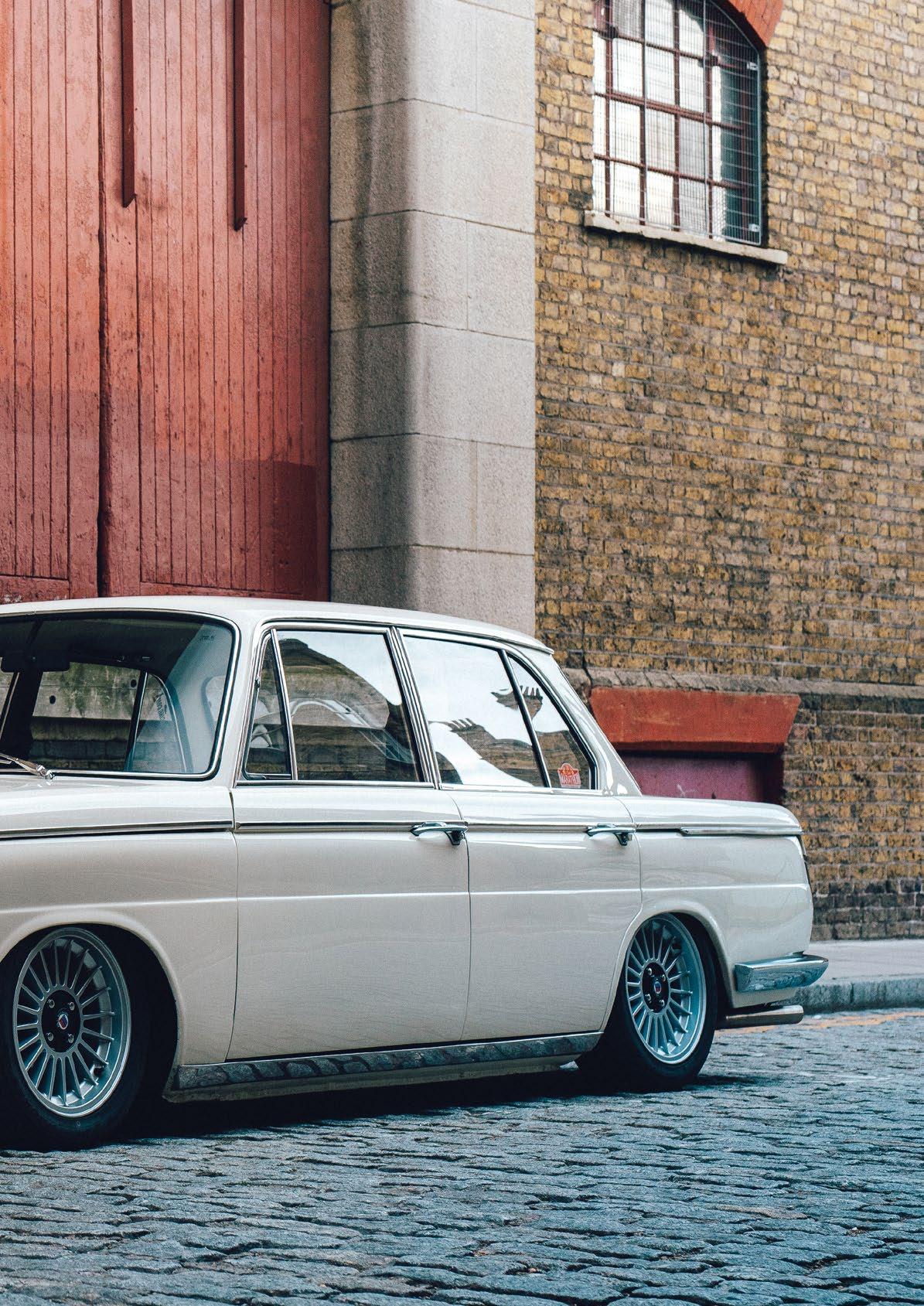
specific in mind, when I came across an advert for a 1968 BMW Neue Klass saloon. It seemed at first glance to fit the bill: fast and reliable enough to cruise all day at 80mph, a heater and wipers that worked and door/window seals that didn’t leak, and certainly not something you see every day.
I went and looked at the car, and within 100 yards of driving it I knew it was coming home with me.
Before we get onto the ownership experience, maybe a quick history lesson would be useful. In the late ’50s, BMW were in dire straits with
a model choice consisting of the popular but not very profitable Isetta bubble car or the outrageously expensive and opulent V8-powered luxury cars that were fast becoming outdated and obsolete. Plans were made to sell the company to Mercedes Benz as a parts supplier, until the workers’ union stepped in and managed to persuade a wealthy German industrialist to invest in the company, which they did. They took a controlling interest in 1960 which is when the “Neue Klass” (New Class) project began. The car that followed was the first new car and engine designed by BMW after 1933 and is widely regarded as the car that saved BMW. Without this car you’d never have seen another BMW again.
Much of its success can be put down to Wilhelm Hofmeister, who designed the body and where we find the Hofmeister kink appear for the first time (that little kink on the front of the C pillar that has been a feature of every BMW since), and Alex von Falkenhausen who was responsible for designing the legendary M10 engine, widely believed to be the best 4-cylinder engine ever built. This is of course wildly subjective. Some may say the VW flat
four deserves that accolade or maybe Honda’s F20C, but neither of those went on to form the basis of the most powerful Formula 1 engine ever to hit the track with 1400+ HP on tap in qualifying trim or the first M3 engine. Yep, same block, and according to folklore blocks for the F1 engines had to have done at least 100,000 km and to have sat outside for a year where the mechanics used to piss on them, apparently to add strength! You can read more about this engine and its importance here: https://www.hagerty. com/media/magazine-features/bmws-most-significantengine-didnt-have-six-cylinders/
So, with that out of the way, what about my car?
It started its life being supplied by my local BMW dealer back in August 1968 and is the 2000 TiLux model, which means it has the luxury trim and sports engine equipped with twin Solex 40s from the factory and producing 120hp (the equivalent top spec Ford Cortina at the time had 71hp and even the Lotus Twin Cam engines only made 100hp in standard tune).

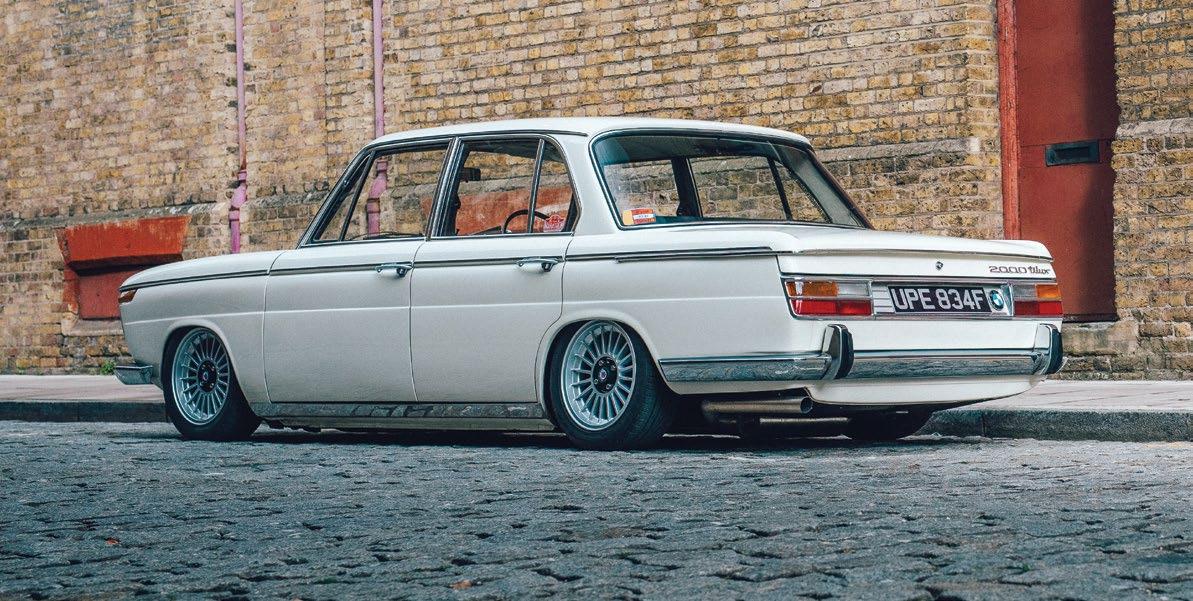
The suspension is standard MacPherson struts up front but sophisticated independent rear suspension, where most people were still on cart springs and live axles. It was this that made the car handle so well (winning several German touring car championships and many 24-hour races, beating period 911s, Lotus Cortinas, etc.) and retain levels of comfort only previously dreamt of in a sporting family car. All this complexity, however, came at a price and a high one at that! This is the primary reason why there aren’t many left in the UK, as in 1968 you really needed one of these in your life to justify spending £58 more than
the cost of an E-Type Jag…
Today there are about 30–40 of all the 4-door saloon models left in the UK. Mine is one of four TiLuxes known to exist over here.
My car was supplied new by my local dealer and stayed with its original owner, just a few miles from where I live, and then his son for the first 40 years of its life, with full BMW service history until they traded it in in 2008. It was bought by someone who prepped it for the 2010 Classic
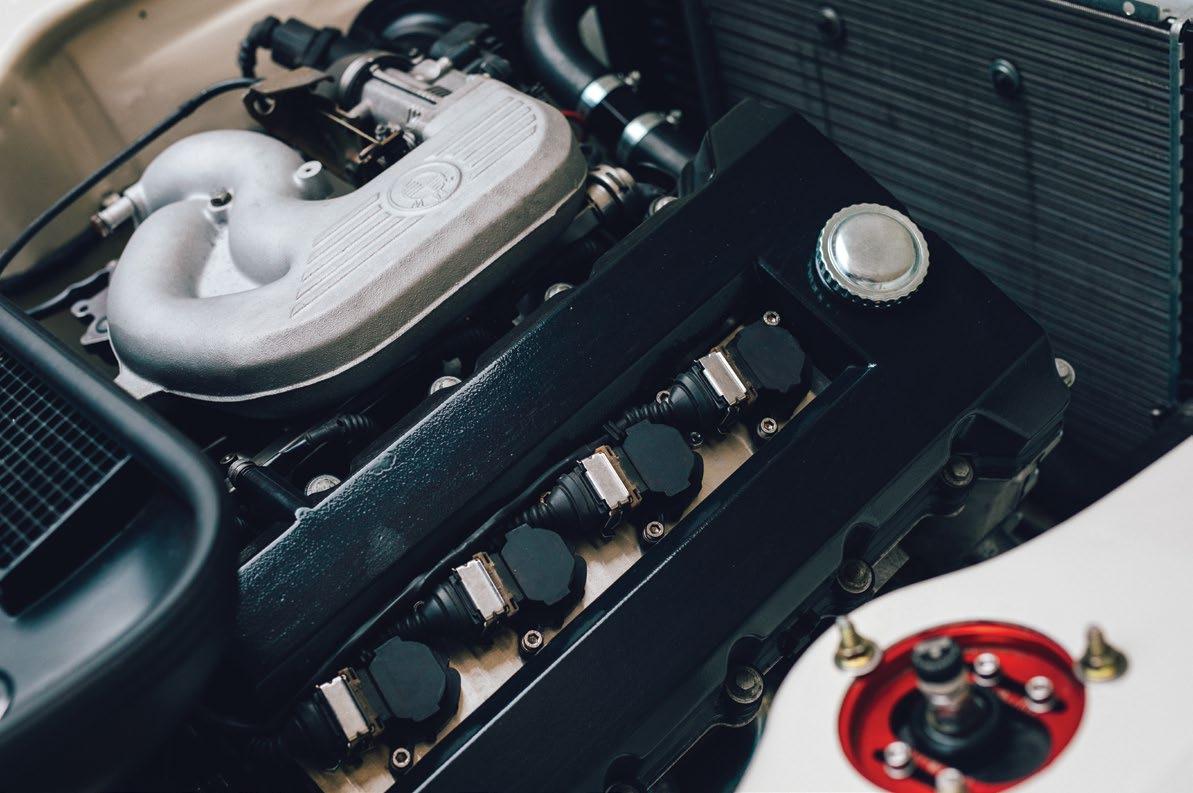
Marathon Rally (hence the Brantz trip meter, map light, and all the things required to obtain its MSA papers), after which point it did the trip to the MOT station once a year until it came into my possession. It had a minor restoration prior to doing the rally and not much seemed to need doing (famous last words!). I drove it as a daily, carrying out basic maintenance for a couple of years, and all was well – an oil change here, new brakes there, that kinda thing – but the biggest problem was that it lived on the drive and it was serving as my winter car so my 1964 VW Samba didn’t get too abused by the salt. Ahh, the good old British winter and salt. Boy, does it take its toll on ’60s metal, and after six years of it the body was getting a bit crusty around the edges.
I had already pretty much gone through it mechanically, replacing the worn Solexes with some nice new shiny Webbers, replacing the 009 distributor (yep same as the VW but with a different shaft) with a 123 Ignition one (can’t recommend those highly enough), electric fuel pump and filter king, and then a later 5-speed gearbox from an early 318 to help it cruise a bit better so I was happy with its ability to sit at 80–90mph all day long.
Now I am fortunate enough to count as a friend Steve Holmes (Stevo) who runs Double H Restorations with his partnerin-crime Nick Hill, and who I’d had in mind to trust the bare metal resto to, especially having seen some of the award-winning cars they have turned out. (Between them they own one of the coolest buses and 912s in the UK –fact!) It also helps that they are just lovely, lovely people, too.
As anyone who has restored an old car will testify, they are always worse once you start getting into them and this was no exception. I’d had the sills and the underside done by another mate a couple of years before so I knew that was all solid and good, but when we
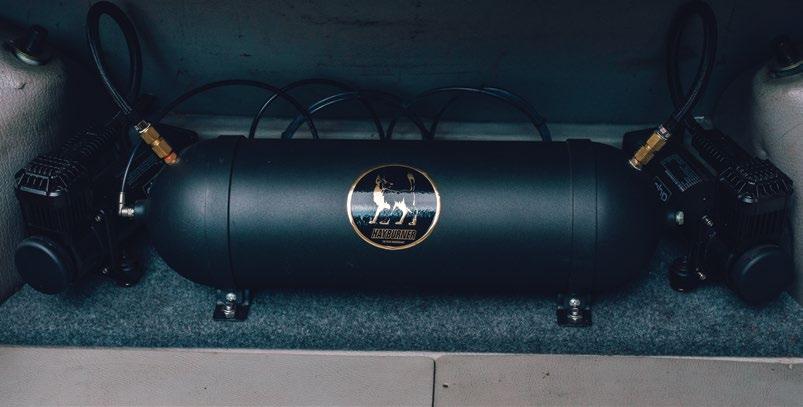


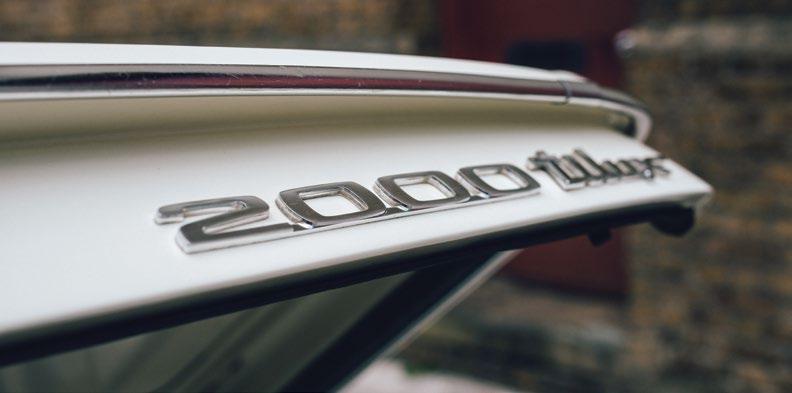
started taking wings and stuff off we found lots and lots of rust. Now if this was a 2002 or even a Karmann Ghia, then finding replacement panels would simply be a matter of who to choose from. Not so with such a rare car.
Jaymic, the classic BMW specialists, were invaluable for things like door seals and buffers and even managed to find me a NOS wing, but I was drawing a complete blank when it came to a bonnet. The one on it was beyond economical repair, so a replacement NOS one was found (the last one in Europe, I was led to believe) during lockdown and paid for, but I had to drive 700 miles to and from Holland to collect it!
The piece that caused me the most grief was the lower front valance which is no longer available, and I had

no choice but to have it handmade from scratch at considerable cost. The irony is that a few weeks later an entire NOS front clip came up for auction in the UK and ended up selling for less than £300 – bugger!
The paintwork ended up being way better than expected and is a testament to the guys at Double H. It’s truly amazing in the flesh. The interior is totally original and in great condition so nothing was needed there.
The last piece of the puzzle came courtesy of my longsuffering wife Isabel who wanted to make sure that the car came back to me exactly how I wanted it. A trip to see Phil West at the Install company was planned and the car now rides on a full custom Air Ride 3 digital setup. Hence the killer stance. A new set of replica Alpina wheels (period correct) were sourced and fitted,

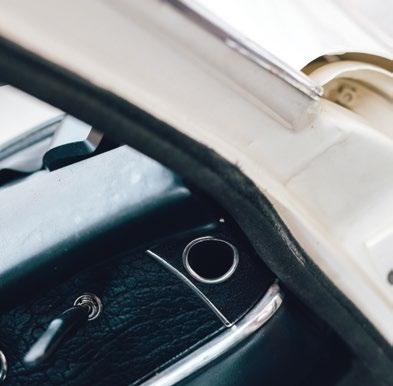
running Toyo R888Rs (now replaced with something a bit more sensible).
I’ve had the car back for about two years now and have enjoyed both driving it and soaking up the compliments it receives, but anyone who tells you a project is finished is a liar. In December 2023 it went to James at JFI Classics for a big brake upgrade and an M44 twin cam engine swap (EFI, of course), 2002 front subframe, steering, and a whole host of other upgrades to the electrics, etc., so

that this modern engine works in the car and still uses all the factory gauges – nice.
You may have heard of the phrase “project creep”. Well, it crept and crept as we went for the shaved engine bay look with battery under the back seat, washer bottle in the boot, things like that, but it was totally worth it.
Like I already said, these things are never finished and I’m looking forward to the next chapter in its development (yes,


there are more things planned such as electric power steering, a brake servo and a turbo, much to my wife’s dismay!). But it is my forever car and it will never leave me (my daughter has already called dibs), and will be used for me and my wife to travel in Europe once we retire, plus a few track days, while still remaining my daily.
Often overlooked, probably because of their rarity, these cars are hidden gems that I’m told drive way better than the 2002s (I’ve never driven one so I wouldn’t know). I’ve
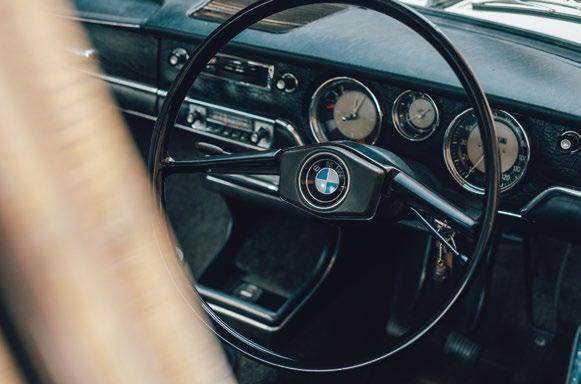
always said that the best bit about my car that no-one else knows about is how fantastic it drives. If you closed your eyes (and didn’t crash), you’d never know you were driving a 55-year-old car. It’s really that nice.
I’ve never owned a feature-worthy car, so it is humbling that Ned wanted to have it in Hayburner, for which I thank them all from the bottom of my heart.

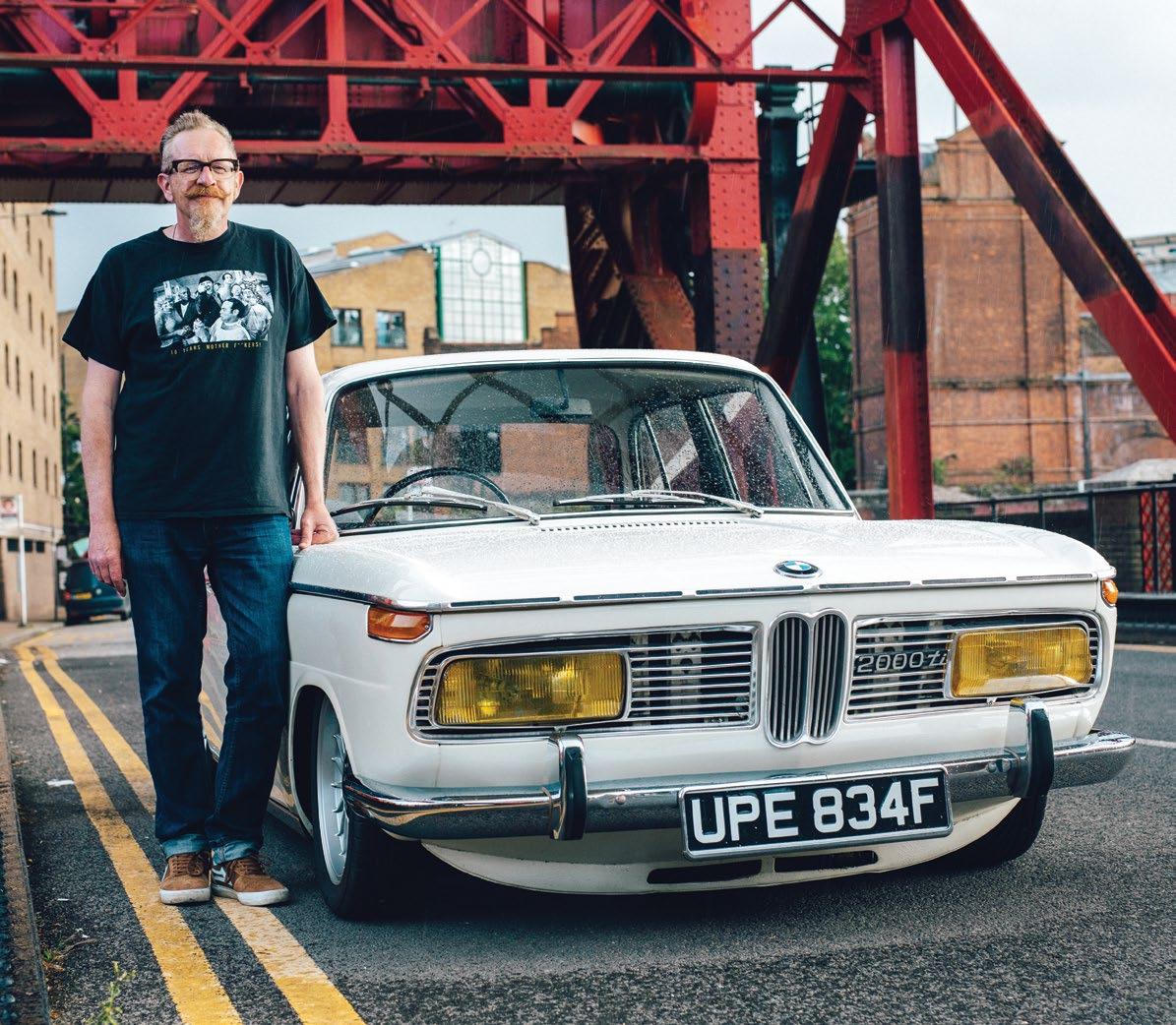



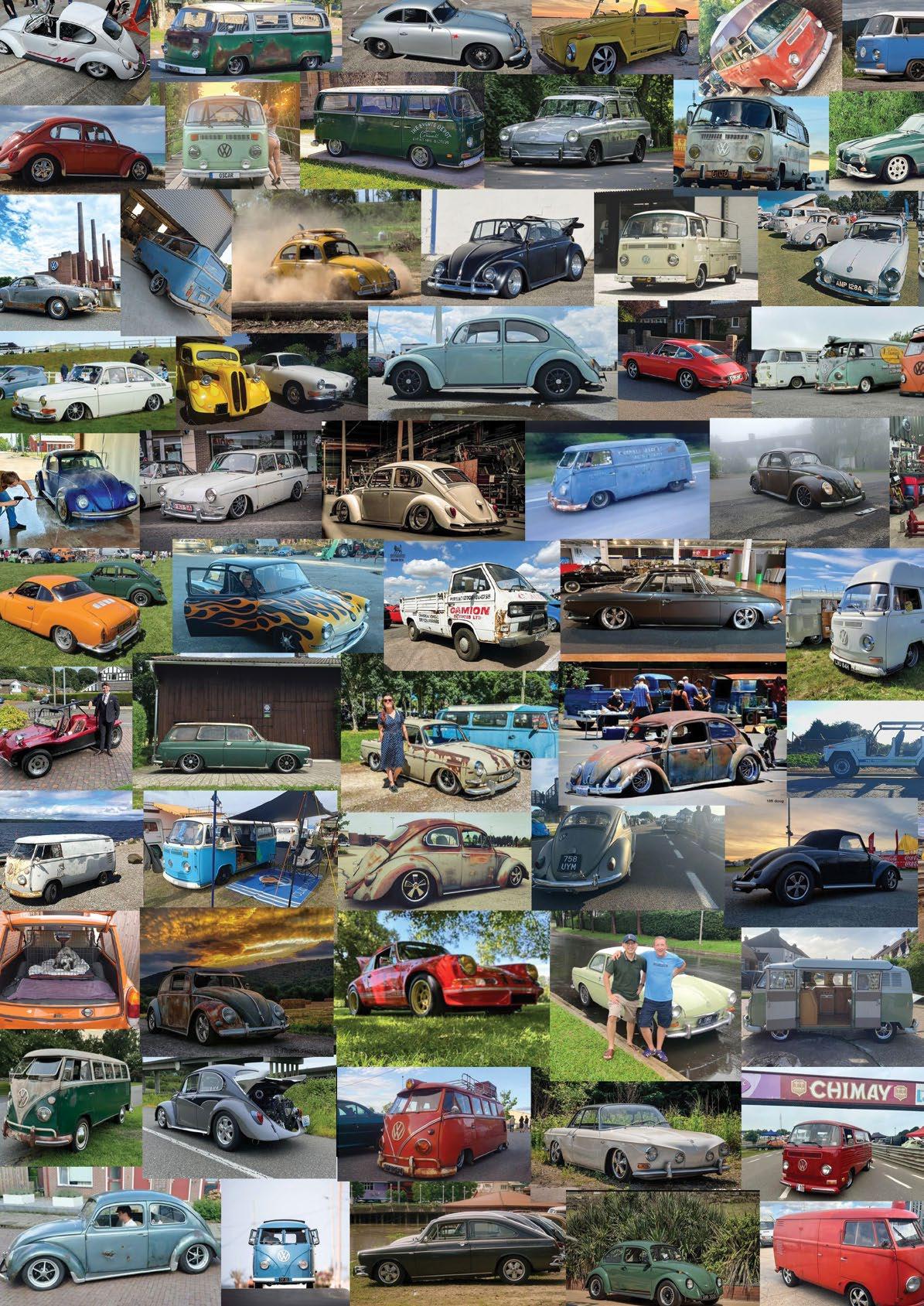
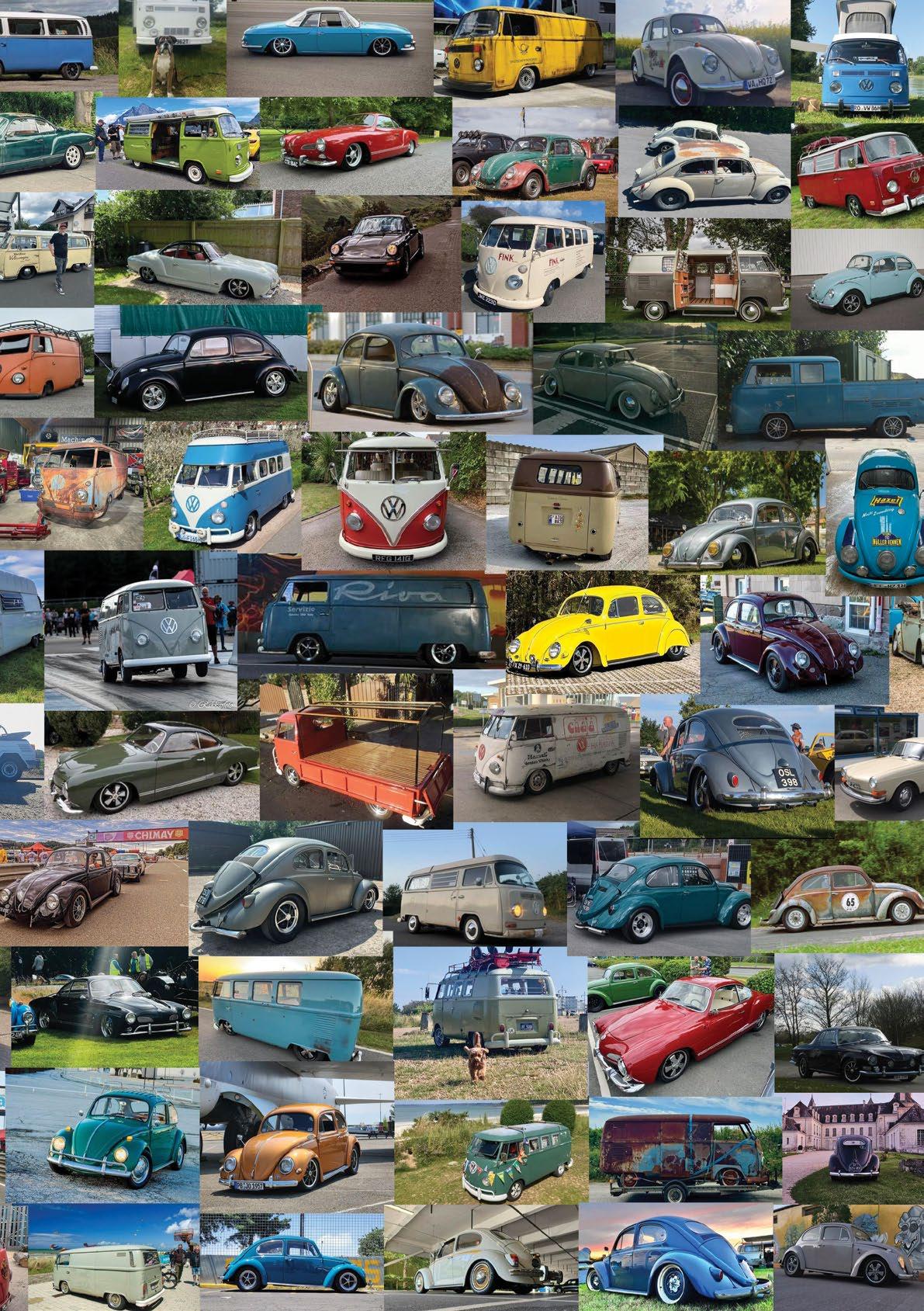
I’m not entirely sure where to start with this instalment. I think I’ve said that before at the beginning of the article, but this time I mean it quite literally because I’m sitting on a aeroplane on my way back from a family wedding in Croatia. It’s been a challenging trip, to say the least, but I won’t bore you with the details. Although I feel fortunate to have had the opportunity to attend this wedding, I have to say that it has fallen at the worst possible time of year for me. So, while everyone else is asleep, I’m here punching away at this article. My issue is that I can’t for the life of me remember where I ended in Issue 50. Luckily, thanks to technology, I have a pretty good record of where I should be. I’ve just found a photo on my phone of the gash I put in my scalp clambering underneath the ’49, and I remember this happened while Vic and Nell were on the BBT Brazil trip just after the
magazine had gone off to print with Issue 50, so I think that’s probably a good place to start.
I believe it went something like this: “Dan! Dan! Is it bad? It’s bleeding but I can’t see.” “Yeah, that’s all the way to your skull. It’s going to be a stitch.” Well it wasn’t a stitch because I have a self-diagnosed hospital allergy, so I did a little home surgery and I was good to go. However, this isn’t the first time the ’49 has hurt me. It seems to cut me pretty much every time I work on it. I’m not sure if the car just hates me, or if 12 years behind a desk has given me soft hands.
So … looking through these photographs I can quite smugly say that I have achieved quite a lot since the last instalment. I’ve been in a far better place mentally and felt particularly enthusiastic about this project again. In the last photo published, it looks as if we
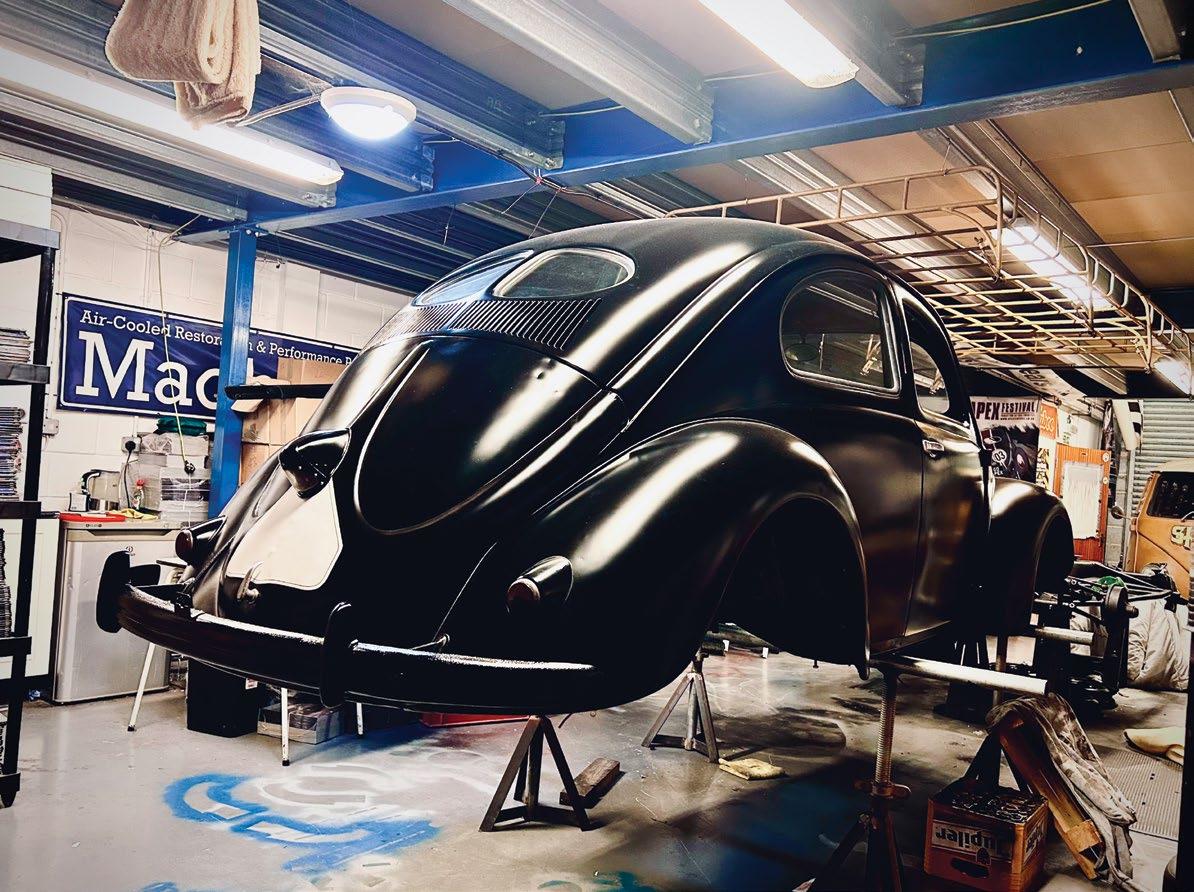
had the car back in paint and it was sitting there waiting for us to get on with it. Once the magazine went off to print with Issue 50 we didn’t really waste any time. With the freshly painted shell sitting downstairs in a space I have walk past every time I go to the toilet, it’s difficult to leave it alone. Inside my office on a table are all the reconditioned or new parts ready to be fitted, and Dan’s workspace is just outside my office door. It doesn’t take a lot of persuasion if you say, “Dan, shall we go try the deck lid on for size?” And that’s
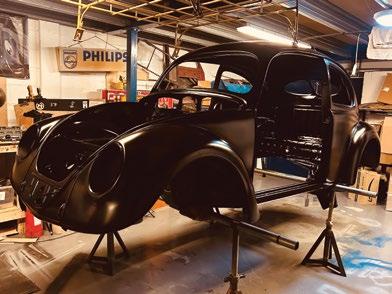
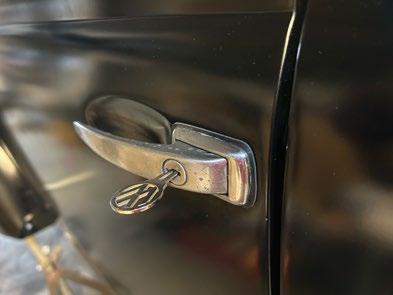
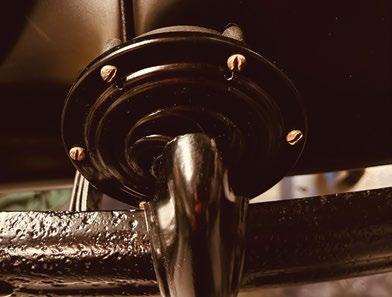
Before we knew it, it was time to give Iain Burns a call to come and pull the wiring loom through. As always, he arrived on time as arranged and got stuck in. I like working with Iain. Although I know my “it will be fine” attitude gets on his nerves when he is trying his best to get things just so, we share a love of music and he never fails to make me laugh. Under normal circumstances I’d
exactly where we started.
Fitting the deck lid was actually a pain in the arse. It was probably the part of the car that had had the most work done on it. Once we got it to fit the hole Drummer Matt had welded in the inner panel to fit the latch, to make the gap correct and for it to latch took hours of fitting, adjusting, bending and swearing. Eventually we nailed it. It was great to step back and see the first panel go back on the car. I really love the way it looks. I think I’ve mentioned before that my aim
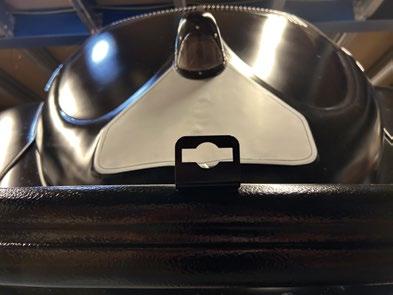
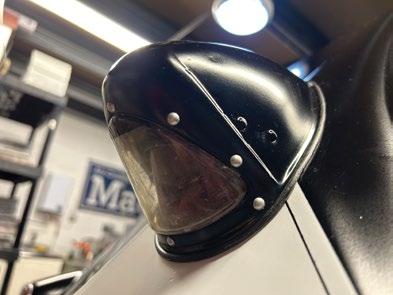
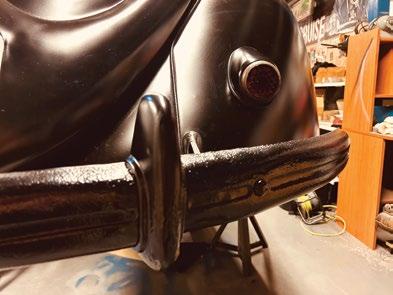
have had Iain make me a loom from scratch, but with this car being kept all original with a 6-volt system, the age of the car requires a cloth-braided loom. Iain said he could make one, but it wouldn’t be cost-effective as an English company AutoSparks make a braided loom for a ’51 which could be modified to work with my car. Iain was actually quite happy with the quality and
was to have a car early enough to have pressing for the licence plate, so seeing it in place felt like a real achievement.
After that, on went the bumper irons with the correct horn mount which we had to fabricate using one of the original mangled irons from Ewan McGregor’s Panel Van, with only old photos for reference as to how it should actually look. Then on went the bumpers, then the tail light shells, then the bonnet, etc.
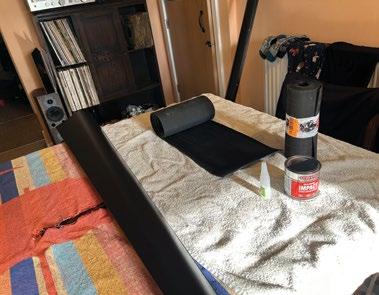
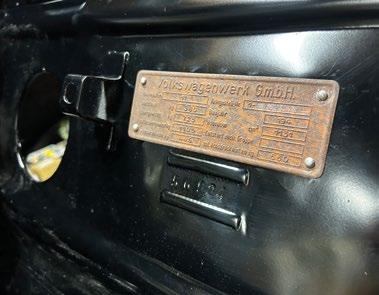
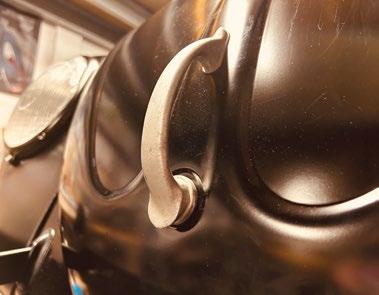
got it fitted in a day with nearly everything working. He is going to do a revisit at some point to do the finishing touches and the bits I didn’t have, ordered wrong or broke, but there’s no rush, at least no rush right now.
This is the point where I should talk about the Skeg Vegas Classic VW Show. When Toby Walker and I were discussing this year’s
Hayburner display, I suggested that as we were working on this project, maybe we could try and get some really old stuff – Split Beetles, Kubels, maybe a Tempo Matador, things like that. This soon turned into me volunteering to trailer the ’49 there to be displayed with the body split from the floor pan. Now this is an offer I’m living to regret. It’s 11.00pm on Sunday and I’m still sitting on an aeroplane, my print deadline (which I am severely behind on)
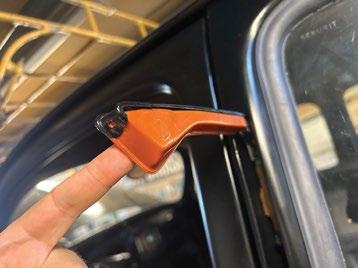
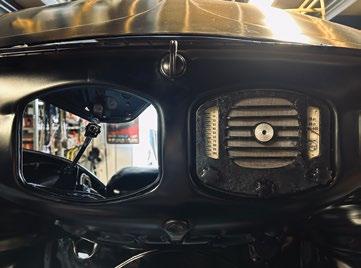
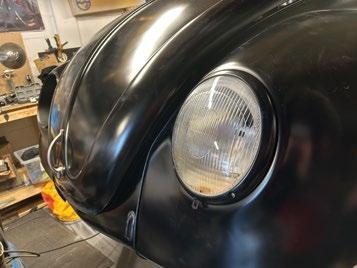
is on Wednesday, and Skeg is on Friday. I don’t even dare to say how much work needs to be done to get it to any sort of displayable condition. As this will have gone to print by the time of Skeg, I won’t be able to let you know if it was a success or not until Issue 52.
The next step was the glass. The rear split window fell into place, no problem. The windscreen, which I was particularly worried about because of all the metalwork it



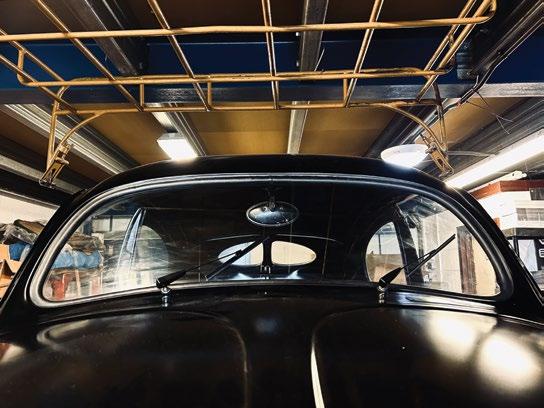
had received around the aperture, wasn’t as bad as I first thought because of a wonderful idea Dan came up with – using wood claps on one side while you set the other. The two rear side windows, however, were an absolute nightmare! I have no idea if it was down to the quality of the seals, but considering that part had no metal work at all, it was crazy how difficult they were to fit. At one point we nearly gave up! The door glass isn’t in place yet as I’m still
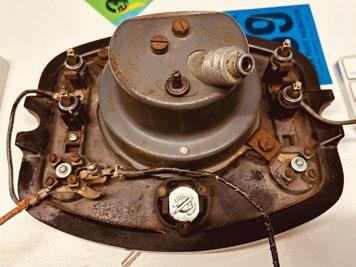


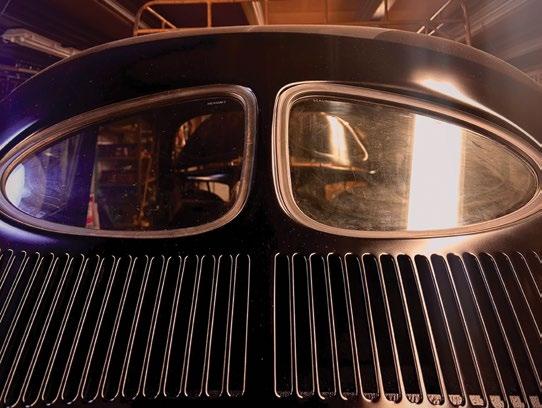

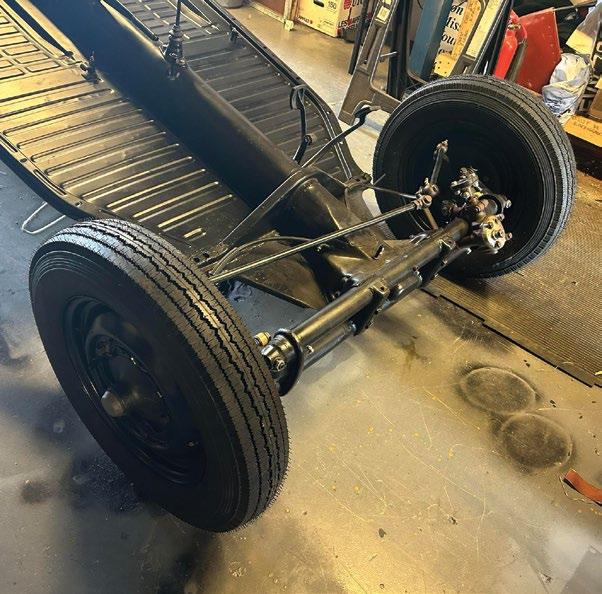
collecting parts for the regulators and need to build up the runners with new felt.
I think that apart from some locks, handles and latches, this brings us up to date with the body, so I’ll move on to the floor pan.
I hadn’t done any work on the pan for some time. It had been left with the front beam built up with the cable brakes in place, the pedal assembly fitted and all cables pulled through. The back was waiting for the Frankenstein of a crash gearbox we had built to
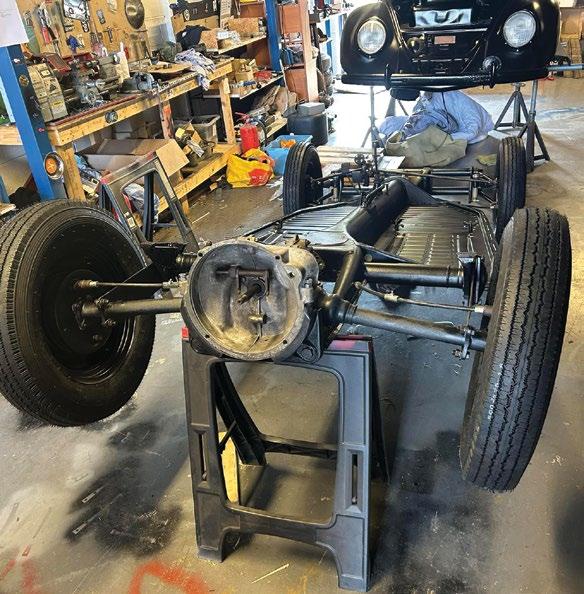

be able to build up the rear brakes and finally get it on its wheels. We did just that. The gear box was fitted and I went to bolt on a few bits and bobs. This was when I went to fit the rod that takes the clutch arm and the thrust bearing. I couldn’t believe we hadn’t noticed – it is physically impossible to fit this unless the box is split into two halves. This meant we had no option but to remove the box from the chassis and split it once again and fit the fork, which was something I really didn’t want to do.
So I’ve just walked into the office after getting very little sleep because of my 2am arrival home. I was greeted by a full set of five 3 x 16” wheels wearing brand new 5.00/5.25 16” T/T Classic Roadmaster tyres. It was a bit of a journey finding the correct tyres at the right price. To explain, I’m going to quote my thread on Facebook: “For anyone who’s still following, I’ve had a conversation with Longstone (extremely helpful company). His opinion was not to go for Waymaster because of the customer complaints they’ve received. I found this interesting
because everyone I have spoken to seem to rate them. His advice was to go for the T/T Classic Roadmaster. Apparently the Roadmaster is an identical tyre in every way to the Excelsior but with different branding on the side wall (and around £60 cheaper per tyre).” I couldn’t resist running down to the workshop to try one, and I personally think it looks fantastic!
Well, I’m going to have to leave you. I need to get this off to print and this car isn’t going to get itself ready for Skeg.
Before I run off, I just want to say that it means the world to me that the magazine is still growing after 51 issues and, as always, I want to say a huge thank you to everyone who has ever subscribed, advertised, supported, contributed, put a sticker on their car or represented us with a T-shirt. We are lucky to have you. As long as you enjoy reading, we will keep writing it.
Thank you all for being a part of it.

